#In this she is built because she was apart of the war effort and served; always moving and on her feet but like.. not beast-illness sick so
Text
War Rages On: part 3 (Bucky Barnes imagine)
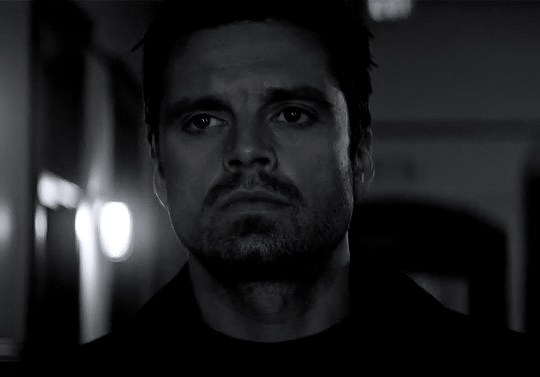
Words: 2451
A/N: if you don’t want to cry, word of advice, don’t listen to anything remotely sad. I literally have 3 potential endings to this story, don’t know which one I’ll choose. Part 4 will have a lot more action and part 5 will probably be the last. Don’t forget to keep tissue close by while reading ;) - enjoy!
Previously: part 1 - part 2
When Bucky walked inside the building he had once lived in, he felt anxious. Not for himself, but for Y/N. During the two hours his ride in the air lasted, he envisioned a thousand possibilities this could play out. He needed her to make it out of there. Whatever he would have to endure, he’d agree to any kind of torture so long as she was safe. He knew he wouldn’t bear to add her name to his already long list of victims. Her only fault had been to fall in love with him. It couldn’t lead her to death, not like this, not because of him. He would never allow Hydra to break the only pieces left of him she had managed to glue back together.
He knew the place by heart, so finding the cells where they would usually keep all their prisoners was fairly easy. Focused on the task, he was taking slow, measured breaths, watching every step he was making, avoiding the guards and the security cameras. He was silent. A ghost. He stopped at an entrance and sneaked out behind a soldier standing by the door. With a swift motion, he broke his neck and used his badge to access the place. Every movement felt rehearsed, a routine he had done a million times. He was mimicking the Winter Soldier with a perfection that still surprised him. He had almost reached the end of an endless hallway of empty cells when he stopped in his track.
“Y/N” He whispered. There she was on the dirty floor, laying right in front of him. She wasn’t moving and from the distance, she looked pale. Too pale to be alive.
“Y/N!” He repeated louder, not caring if anybody could hear him.
She didn’t answer, didn’t even move an inch. He took a tentative step toward her, afraid of what he would see when he would open the door. He raised his metal arm and grabbed the lock, tearing it apart in a swift motion. The gesture was effortless, the power colossal. He didn’t even blinked, his eyes remaining always on her frail figure. He slowly bent down, trying to ignore the bruises visible through her half-torn shirt and the dried blood everywhere on the floor. He laid a fearful finger on her throat and waited a second. Finally, he released a shaky breath, relieved beyond measure when he felt her heartbeat. She was alive.
Gently cupping her face, he brushed a hand against her cheek. His heart broke when he saw the shadow of a smile forming on her lips.
“Bucky” She muttered in contentment.
“Yes, doll. I’m here”
She didn’t open her eyes but tears slowly coursed their way down her face. Her lips parted and she leaned against his hand, inhaling deeply.
“We have to go, Y/N”
“You feel so real,” She answered. “Why do you feel so real ?”
She sounded upset, but not because of him. She could make out every detail, his scent, his voice, his touch. She wondered what kind of cruel game her subconscious was playing as she let his presence submerge her entirely. He raised his eyebrows in confusion, not understanding that, for her, there was no way he could be there. She had spent the last couple of days picturing him in her mind to ease the pain, to escape the torture. He was the fragment of her imagination keeping her alive. Her last shred of strength.
“Am I dying ?” She murmured. “Is that why you’re here ?”
“Y/N, open your eyes” He demanded with force.
“No..”
“C’mon, doll”
“You’ll disappear. You always do” She sounded broken, on the verge of snapping, but kept them closed.
“I promise I won’t” His voice cracked with every word, overwhelmed by the pain and helplessness when she spoke.
She grabbed his wrist, holding it tightly as she slowly opened her eyes. Her whole body was shaking, afraid the soothing sensation of his skin on hers would be gone and she would only see an empty room once again. It took her a moment to realize he wouldn't disappear and she started sobbing. Her shaky hands cupped his face, wiping his own tears. He gently laid his forehead against hers and she didn’t waste any more time and hugged him. She clung to him, her only safe place, as the battle for the remaining shred of her sanity raged. She tried to catch her breath but it was useless. This was days of emotions bottled up to survive, days of dreaming she could return to him.
“We’re gonna be okay” He kept saying, holding her tightly.
“Bucky …” She choked in despair. This was the safest she had felt in days.
“I’m here, doll”
He swallowed and blinked a couple of times, trying to stay strong and not break down.
“We have to hurry, Y/N” He reminded her after a while.
His voice seemed to bring her back to reality and she suddenly sat up, ignoring the dizziness and the pain it instantly ignited in her body.
“No, no, no, you have to leave!” She started begging, furiously shaking her head and clenched his shirt in desperation. “You can’t be here! You can’t! Please … Please go ”
“Y/N…”
“You don’t understand, they … they want you, Bucky. They’re using me to get to you” She put some distance between them and pushed him away when he tried to get closer. “You have to go”
“Not without you”
“You’re not listening!” She replied, frustrated.
“I am! And I am telling you i’m not leaving without you!”
He stood up and helped her do the same. She couldn’t hold on her own, too weak and tired. She pressed her hands on his shoulders to steady herself and his metal arm circled her waist.
“I’m taking you home”
“I don’t think so” A voice with a thick accent replied behind him.
The former assassin cursed under his breath and was quick to react. He pushed Y/N behind him, hiding her wounded body from the intruder. Suddenly on high alert, he stared at the man he once knew, a man hired by Hydra with the sole purpose of creating new super soldiers. He was the brain behind the Winter Soldier program. The Sergeant subconsciously grabbed the woman by her hip, bringing her as close to him as possible.
“Dr.Faustus” He greeted him without sympathy.
“At last we are reunited, soldier”
Bucky clenched his jaw so tight his veins were now visible. In all the time he had spent away from Hydra, he never thought he would come face to face with the doctor ever again. All their encounters had been turned into a distant memory, another one of his nightmares. The Sergeant was unexpectedly conflicted, like two parts of him smashing against each other for the first time, two very different men colliding together without his consent. The broken one felt scared, powerless, becoming once again a victim, while the assassin was already on the lookout, trying to find his way out of there.
Y/N could feel it. Hidden behind him, she laid her forehead on his back, defeated. His muscles were tensed under the pressure of his emotions and his grip on her hip tightened. She couldn’t contain her terror and silently cried. How could she save him now that they had him back ? What could she do when her body was in no shape to fight ?
“I wouldn’t advise trying to escape” The man spoke.
“You know I don’t back down without a fight” Bucky replied, eyeing the three agents surrounding the doctor. They were outnumbered.
“You might want to reconsider this time” He smirked viciously.
He made a step toward the couple, moving like a snake reading to suffocate its prey by strengthening its hold around their neck.
“Before you think about taking them down,” Hydra’s doctor began, pointing at the agents next to him “You should know she won’t survive. You see, the girl serves no purpose anymore. She was a mean to an end and she played her part perfectly. She got you right where we wanted you to be, up against a wall”
Bucky gritted his teeth in silent fury.
“I’m assuming she means a great deal to you, soldat” He sniggered irritatingly. He seemed to enjoy the emotional torture. “Now the real question is, how far are you willing to take this to save her life?”
Bucky looked around him and just felt a rage he couldn’t explain, a will to survive he never had before. Y/N grabbed the hand on her hip, entwining their fingers, and he closed his eyes. For a short instant, he held onto that comforting sensation, the sense of home she could bring to him by the simplest touch. He remembered the day they met, the exact moment he had fallen in love with her and the day they had promised forever to each other. He had a collection of precious memories they had built, engraved in his heart, and each one of them had the power to lessen his pain and lighten the weight on his shoulders. They needed more time to create their magic, to turn the horror they had endured into sparkles of distant memories. More time to live the life she had given back to him. But even more so, he needed her to survive.
“If I surrender myself, what guarantee do I have you’ll let her go ?” He offered.
“No!” Y/N shouted, trying to move around Bucky. He didn’t have to use much effort to push her back.
The doctor laughed, pleased his plan was working flawlessly. He turned on his heels and nodded at one of the soldiers next to him. The man took a phone out of his pocket and handed it to the former assassin.
“What is this ?” Bucky questioned him, ignoring the pleading eyes of the woman begging him to not give in.
“A message” Dr.Faustus replied. “With coordinates to this place, addressed to your Captain”
“This isn’t enough”
“Press the button and send it yourself, then”
Bucky gave him a wary look but took the phone nonetheless.
“I have a condition” He raised his eyes to stare at the man.
“You are in no position to negotiate, soldat”
“If you want me to follow you willingly, you will listen”
He pursed his lips in annoyance.
“Very well”
Bucky glanced back at his girlfriend, barely holding on her legs but still ready to kill him herself for what he was about to do.
“Let me have a moment with her” He pleaded, his voice deep with emotions.
“If you plan to escape …”
“I won’t” He cut him with a promise he would keep.
He seemed to ponder his options for a moment before he gave a nod, accepting the request. Bucky dropped his head in defeat and pressed the button on the phone screen, sending the message to Steve and praying he would be there soon to get her out of there.
The doctor turned around, gesturing to the other agents. In less than a minute, the room was empty and they were alone for what would probably be their last moment together. Bucky made a step toward the woman, knowing whatever time they had it would never be enough, but before he could do anything she gathered all the strength she had left and slapped him across the face.
“I hate you!” She shouted, tears streaming down her face. “I hate you!”
He had expected her anger but her words still hurt him. He couldn’t begin to understand what she was feeling when his own heart was already being torn apart.
“I had to…”
“Why didn’t you fight ?” She choked. “Why … why did you gave up on us ?”
“I gave up on me!” He told her in a deep voice, quickly closing the distance between them and cupping her face with force. “I’m choosing you over me”
“There is no me without you, Bucky” She muttered
“They don’t know the Winter Soldier is no longer here” He told her, trying to reassure her. “Whatever they have plan for me, it’s not gonna work”
“You don’t know that”
He laid his forehead on hers and a tear on his own rolled down his cheek.
“I know I need you to stay alive. I’ve lived on borrowed time long enough, Y/N, maybe …”
“Don’t you dare!” She cried, pushing him away. She struggled to stay on her feet but she couldn’t seem to care. “I swear to god, Bucky, I will kill you myself if you dare giving up now!”
“Steve is gonna find you and bring you back” He continued.
She shook her head and her eyes grew hot, the tears welling so quickly it was impossible to blink them away.
“Please don’t break my heart” She whispered.
His lips started trembling and he choked on a small but audible sob. Losses after losses, he had shed his own shade of tears, had been broken beyond measure and brought to hell. This was something else. Pain had a sweet taste of horror and self-hatred when it was felt under the power of all his sanity.
“Let me hold you” He begged her.
Despite her anger, she didn’t waste any time and sank her face into his chest, letting him comfort both of them. He kept her close, looking down at her with gleaming eyes, wishing he never had to let go as he tightened his arms around her.
“I love you” He spoke right next to her ear. “Like I’ve never thought it was possible to love. You picked up every pieces of me you could find and glued them back together. You built the man I am today from scratch with your kindness, your resilience and your love. You gave me a second chance, and a second life by your side, and what a life it has been. You are my world, my soul, but most importantly, my home. You will always have me, doll.”
“Don’t say goodbye like that” She muttered, an aching wound opening deep in her chest as the tears kept falling.
“This isn’t goodbye, I’ll make damn sure of that. Wherever you are is where I am too. That’s the deal we made, right ? I’m with you till the end of the line”
“This is the end of our line” She forced up the words.
He raised her chin with a finger to look into her eyes and in that moment they kissed, together in each other's protective embrace.
“It will never be”
“Promise me you’ll give them hell”
“I promise I’ll fight with everything I have”
Tag list below the cut
@briannareneea985 - @bangtanxberm - @kissmyoops - @steve-is-daddy - @tylard-blog1 - @harprs - @animegirlgeeky
#Bucky Barnes#bucky barnes x reader#bucky barnes fanfiction#bucky barnes imagines#bucky barnes imagine#the winter soldier#the winter soldier x reader#the winter soldier imagines#the winter soldier imagine#falcon and the winter soldier#Winter Soldier#winter soldier imagine#winter soldier x reader#winter soldier imagines#fatws#tfatws
108 notes
·
View notes
Text
Hordak can’t catch a break even on his birthday...
Oh fandom, you really like this sort of drama don’t you?

A few days ago, on Hordak’s birthday, there was this ‘interesting’ post in the tag – since, apparently it’s impossible to get any peace even on that day.
I was too tired to answer it at the time after being on call the day before so, here’s my delayed answer to all of that:
First off: this post has this bit in it when asked what that person dislikes about SPOP.
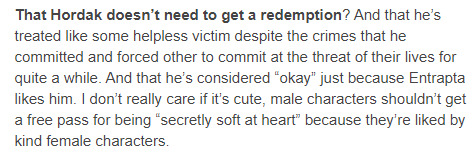
He doesn’t need to get a redemption and he doesn’t get one in the show.
None of his actions constitute a redemption arc. The man merely acknowledged his personhood and freed himself from his master and God. That’s what his arc was about: the right to have a personal identity.
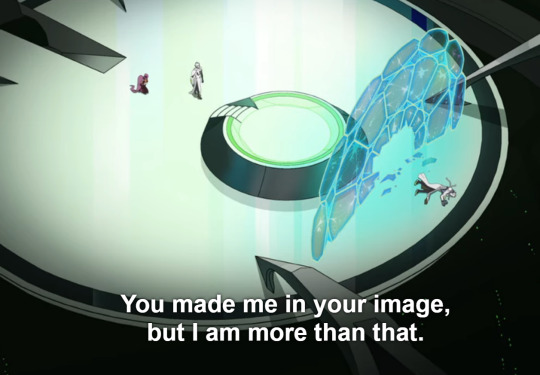
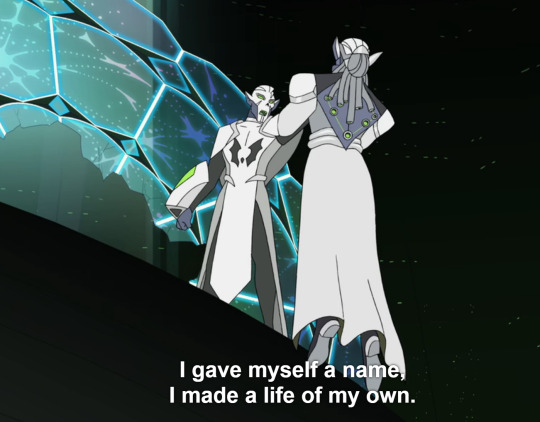
He gave himself a name and wanted to be his own person. That’s it. That’s all he wanted.
The man was merely freed from Prime’s influence- an influence he was born into since he’s been specifically manufactured to serve as a disposable mass produced soldier and worshipper of Prime.
If the argument that Catra was “forced” to commit crimes and thus she is not completely guilty of them since she was under duress – then the argument doubly holds for a person who has been directly programmed and conditioned to do so under the threat of death or mental rape (purification).\
Even while away from Prime, he was still conditioned to obey and brainwashed by Prime’s cult. He literally knew nothing else – he was not meant to. It’s how indoctrination works.
Prime’s clones aren’t people to Prime, they are tools. Those clones, while cut off from Prime still want to serve and please him: That’s what Wrong Hordak’s purpose in the show is- to show us just that.
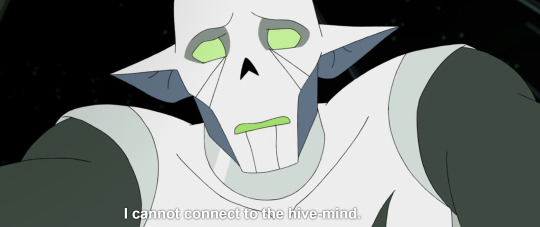

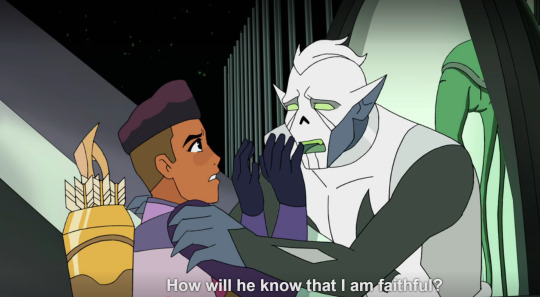
Hordak is not considered “OK” because Entrapta likes him. Hordak is merely shown – by Entrapta that he could live apart from his cult and have worth outside what Prime tells him he has.
Just like real life cult victims, he needs an outsider to help him see a way out of the cult. The nature of indoctrination and brainwashing makes it impossible for the brainwashed person to know they are brainwashed unless someone points it out.
Now for my favorite thing:

and

oh and

Oh boy… this makes me just so damn uncomfortable.
To offer a bit of context as to why. I have never been on social media before SPOP or in any fandom and as such, I have never encountered the ‘all men are evil’ discourse that seems to infest these places. It’s been quite a bit of culture shock for me.
What is it that makes anyone think it is ok to judge a person because of an accident of birth? (being born male)
Why does hate for 50% of the human population get such a free pass on these platforms? Misandry is just as terrible as misogyny. You are being biased against another human because of their gender. I don’t care that males are perceived as ‘privileged’ – that doesn’t make it ok to be terrible to them unprovoked.
How does hating all men help achieve equity?
Do you realize that this sort of discourse is exactly how you radicalize people against the very cause you are championing? You breed hate and adversity for the rest of us who actually want to to have a discussion on the topic.
I’m a feminist myself (in a country where feminism is hard-work) and let me tell you, making all men hate us does nothing but push away potential allies and make it a lot harder for our voices to be heard.
Feminism is about equality, not women dominating.
Now onto the second post: the one comparing Catra and Hordak with the question of which of them is a better person.

This whole war orphans that were personally abducted and tortured into serving the horde HC that some ppl have is really starting to get boorish. This has been going on for more than 6 months.
I have no idea why everyone thinks he went down chimneys and stealing babies left and right while cackling villainously. The man had a busy schedule of brooding in his lab, wallowing at his inability to use insulated cables and having his device blowing up in his face with the occasional Skype call to Shadow Weaver to see what the Horde is doing.
And yet, to a part of the fandom, this is what he looked like:
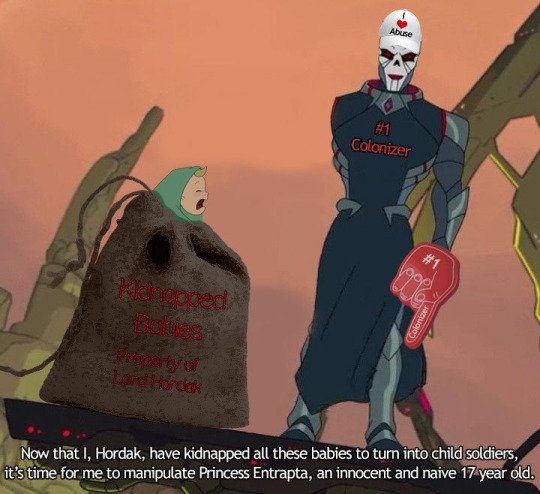
( @bat-burrito made this one and it’s glorious)
And if you don’t believe me about the lab recluse thing, you don’t have to, the show pretty much states it for me.
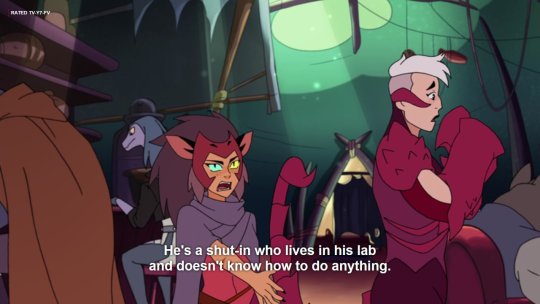
and
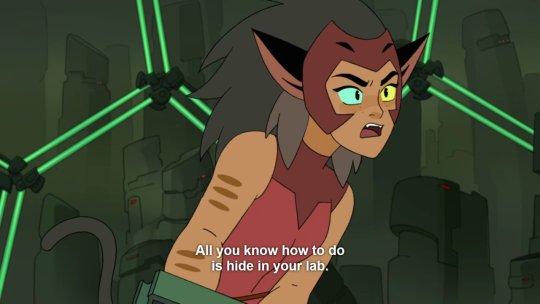
+
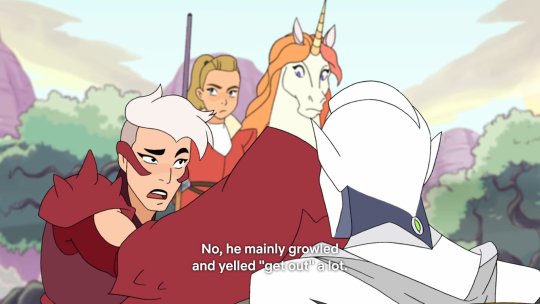
Hordak is a recluse that stayed in his lab and let the running of the Horde and most operations to Shadow Weaver and later Catra. He did not personally abuse anyone and he is not the origin of the cycle of abuse.
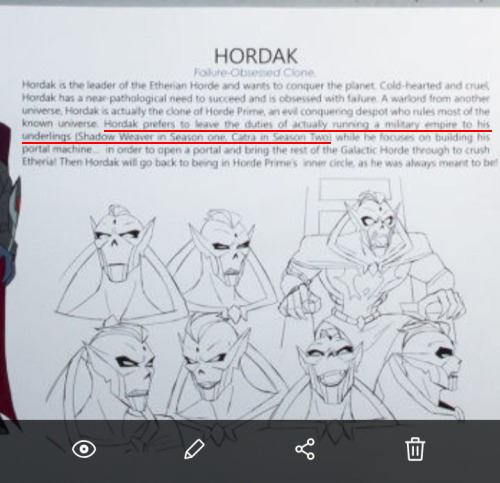
Shadow Weaver was a child grooming manipulative woman before she even joined the Horde – she did this to Micah while she was not “evil” or presumably abused by Hordak.
Even if you want to HC that Hordak abused her somehow, he is still not the one who started the cycle: Horde Prime is.
The whole fandom seems to forget about the eldritch monstrosity that created a whole army of brainwashed slaves to worship and die for him. Prime is the one that sent Hordak to die and gave him the motivation to try to prove himself worthy of life and love. If you want to point fingers, point them at the origin of all of this. This fandom has a strange Prime blindness. He is never talked about when it comes to being the start of all of this.
If Prime didn’t exist, Hordak wouldn’t exist. If Prime hadn’t sent Hordak off to die, then his clone wouldn’t have accidentally ended up on Etheria. None of the things in the show would have happened.
Adora would have died of exposure in a field, the monarchies on Etheria would have continued as they are and the planet would have continued to exist in despondos.

He is a dictator, yes. So are the princesses. Monarchies are dictatorships where the ruler is born into power. Hordak gained his through military might while Glimmer was born with hers and enforced it with tradition. I don’t really care to play “who’s the better dictator”. The princesses have their power because of the runestones- magical rocks put there by the First Ones to channel the planet’s magic and use it as a weapon. How come no one talks about that?
Do you think a king/queen keeps their crown without effort or subjugation of their subjects?
Also, Hordak had never interacted with Catra before SW dragged her before him to be judged. He was indifferent to etherians in general and didn’t seem to care which of them were his underlings so long as the operations were running smoothly. He was more focused on his portal and returning home than on anything else. He did not set out to “ruin lives” or quest for power. What he wanted was to return to his deity and become a mindless part of the whole again – that is as opposite to power hungry as you can get.
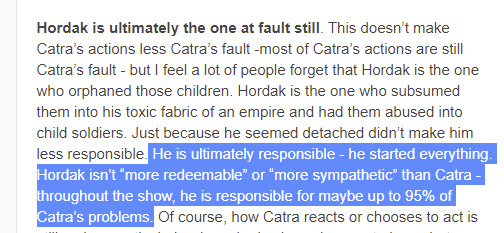
Catra was directly abused by Shadow Weaver throughout her childhood. That makes Shadow weaver responsible for 100% of that abuse.
Catra was found in a box by Adora and adopted by Shadow Weaver. Hordak didn’t know or care that she existed.
He is responsible for the war, he is responsible for the war casualties and the property damage. He is not responsible for Shadow Weaver being a terrible person and mother figure.
Again with the orphan thing. We have 5 cadets in the show.
Adora was found in a field.
Catra was found in a box. Lonnie, Kyle and Rogelio are unexplained. The only lizard ppl we see in the show are in the Horde or the Crimson Wastes. The other two could just as well be the children of some of the soldiers.

I may harp on about what a bitch Shadow Weaver is – the reason I do so is because she is legitimately terrible to the two girls in her care.
I was the unfavorite growing up, I WAS the Catra in my family who could do no right while my sibling was the golden child. I don’t however hate Shadow Weaver. She is a cartoon character in a show and she does the things she was written to do. Hell, she is a very compelling and believable villain. Her motivations are clear and she is consistent. Her voice actress portrayed her splendidly and her character design is superb. I like her but that doesn’t mean that I don’t acknowledge her role in the story. I don’t however make up parts of the story to make her more evil than she was or treat my headcanons about her as absolute fact.
Again, sigh: Prime is the worst villain in the show. He is quite literally Nyarlathotep and does this to planets:

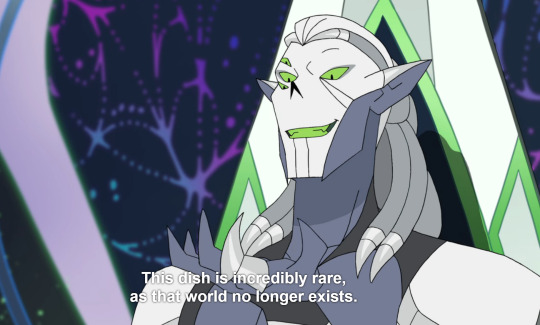
This to people:
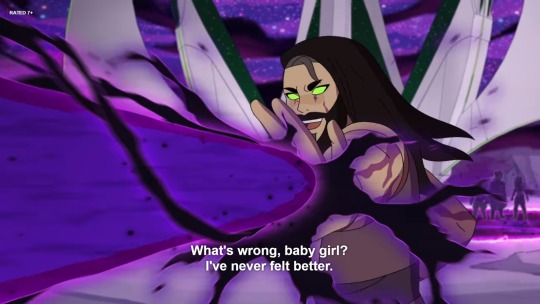
and this to the people he created to serve, worship and love him:
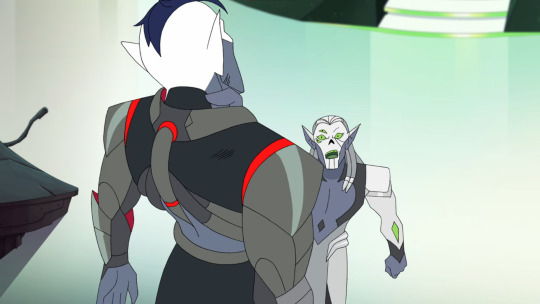
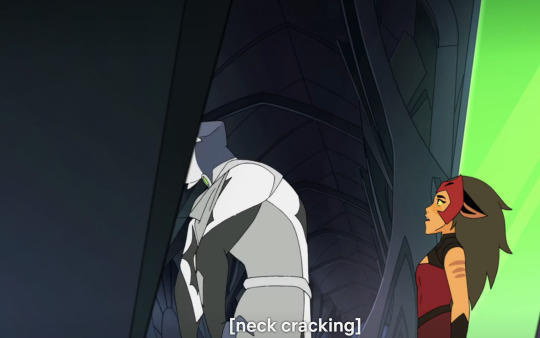
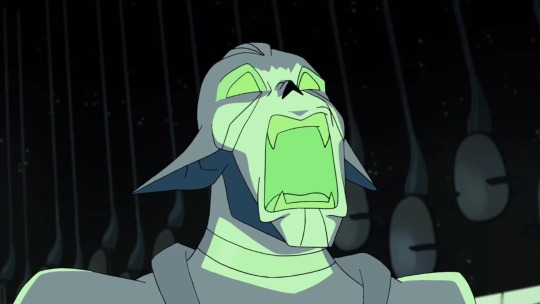

How is that not worse?

I love Catra and it genuinely annoys me when people erase her agency or try to paint her as one-dimensional victim. Catra was an antagonist for most of the show and she rocked it! She was 400% more efficient at it than cloneboy. Give the queen some damn respect and recognition! Catra had a lot of agency and her actions moved the plot of the show more than those of the protagonists. (they were mostly reactive).
Catra pulled the lever of the portal in a moment of distress after a breakdown, a Shadow-Weaver related breakdown because that’s how trauma works.
Hordak didn’t make her do it, he didn’t send Catra after Adora either. These were Catra’s choices. They came from a place of hurt but they were her choices still.
The portal was a means of transportation, not a weapon. Building it was not Catra’s mission, it was Hordak’s. He built it so he could contact Prime and either summon him here or go home –whichever course of action Prime wanted. Again, Hordak wanted to go back to this:
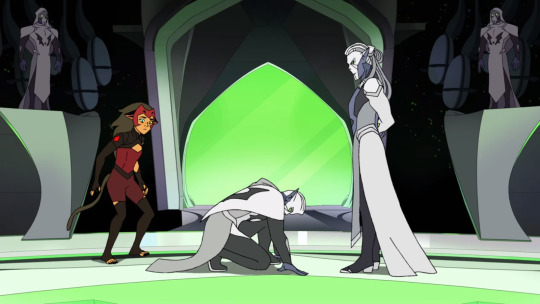
...
The only person who knew the device was dangerous was Entrapta and she tried to warn Hordak about it. Catra was the one who stopped her, violently so, then sent her to die on Beast Island- the fate Entrapta saved her from a season ago. Catra then tried to have Hordak open the portal before it was ready.
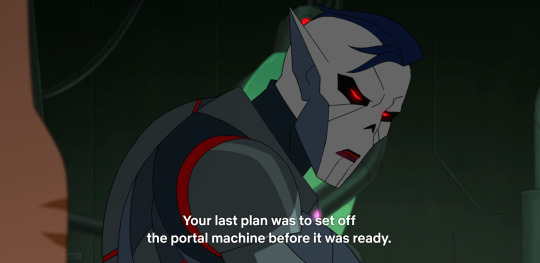
When he wouldn’t – she pulled the lever herself because that is how desperate she had gotten at that point, to show Shadow Weaver how wrong she was. That is how hurt Catra was by her mother figure’s betrayal and abuse.
Don’t take that away from her. Don’t call it curiosity or naivete or whatever. She knew the portal was dangerous but she wanted to prove Shadow Weaver wrong so badly that she didn’t care at that point. She had been pushed that far.
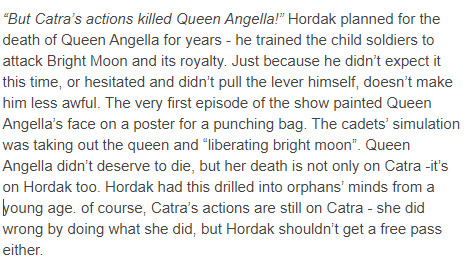
Catra’s actions led to Angella’s death but she was not directly responsible for it. She didn’t activate the device to kill Angella, it merely happened accidentally. Catra was however glad it happened and wanted to profit from the aftermath of her death.
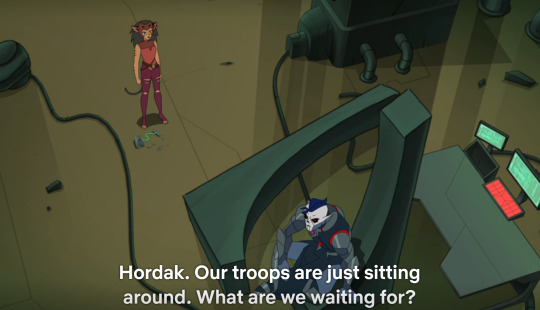


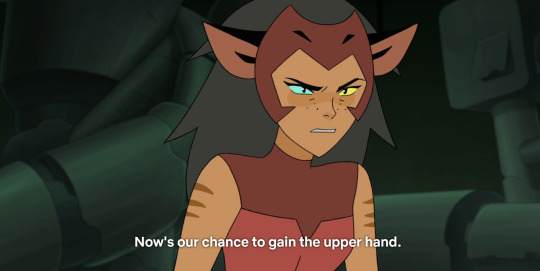
Hordak didn’t care or plan to kill Angella personally. There is no in-show moment where any of that is portrayed. Since he doesn’t care about the specifics of running the horde seem to know what they are conquering at the moment, it seems that that was usually a task reserved for his second in command.

^ - troop movement ordered by Catra
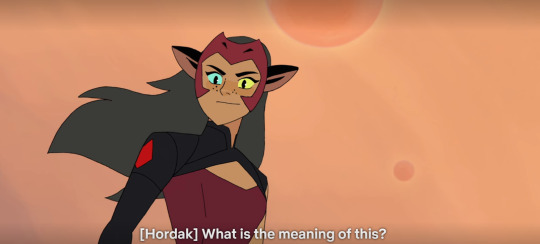


Hordak doesn’t even know what his own army is doing.

Again with the Hordak “drilling into orphan’s minds”… I seriously doubt that any of them had ever seen him out of his lab or that he came up with the propaganda himself.
Manipulation is more Shadow Weaver’s game not his. For all of Hordak’s faults, he is not deceptive or manipulative. If anything, he is woefully incapable of spotting lies. (it might have something to do with him being born in a society where lies were almost impossible because of the hive mind and Prime being able to browse his thoughts at a whim- as such, it wouldn’t be a skill he would have been able to develop).
Hordak canonically despises deception and lies. I really don’t understand where this image of a manipulative and cunning Hordak comes from. He wouldn’t be able to plot himself out of a paper bag if his life depended on it.

First off.. S4 Catra was his equal, not his subordinate. Don’t take that away from her. She earned it.

He doesn’t look that threatening here...
And again: Prime created the system. He made clone slaves and programmed them to serve. His clones have hardware installed for the express reason to facilitate his control over them. He has a religion in place to make sure their thoughts do not stray from his purpose. I am legitimately boggled by this fandom’s tendency to completely forget about his existence.Does anyone really think that these people that are born “prechipped” and programmed to know nothing but Prime’s Light are really knowledgeable about human morality?
That they would know that conquest is bad when that is the express reason for their creation?
If I were born in that situation, I’m not sure I would have known any better. Hell, if any of the clones even try to disobey Prime, they would get either mindraped (erased) or killed for the effort. They really have no choice, even if they knew that killing in Prime’s name is wrong (they don’t) they really can’t do anything about it. They have no choice but to be what they were made to be. I find it personally abhorrent when these designer slaves are held accountable for what Prime has made them do.
And to the people that say Hordak was free of Horde Prime once he was stranded on Etheria.. That is not how indoctrination works. The fact that I can’t go to church this Sunday because I’m locked in the house and can’t find the keys doesn’t make me an atheist.
Hordak was serving Prime even on Etheria. He keeps mentioning it to both Entrapta and Catra. He started the war because that’s what he thought Prime wanted of him and that’s what he’s been programmed to do. Personal and informed choice really doesn’t factor into his decision at all.

He is not sympathetic because Entrapta likes him. Notice how I haven’t brought up his relationship with her up to this point?
He is sympathetic because he literally had no choice but to do the things he was indoctrinated into doing. He was build and programmed for it, just like all the other clones. They are not able to deviate from that because of the way Prime functions and rules over them.
There is no point in the show where Hordak relishes over his status as a ruler or the “luxury” it affords him. He does not engage in the same behaviors his progenitor manifests.



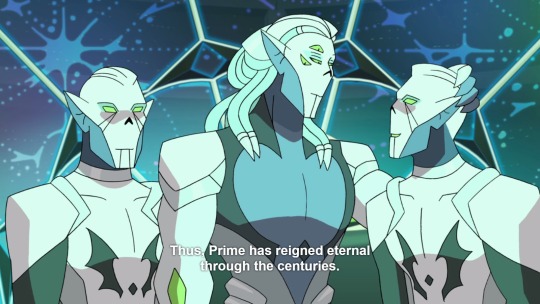
There is no point in the show where Hordak relishes over his status as a ruler or the “luxury” it affords him. He does not engage in the same behaviors his progenitor manifests. He attempts to emulate Prime in order to project authority in the only way he knows how but since those are some really big shoes to fill, he is woefully inadequate.
If Hordak had been power hungry, he would have stayed in despondos and ruled his own faction. Being away from Prime is the most powerful and autonomous he’s ever been and yet, he wants to throw all of that away in order to be a powerless, nameless part of the whole. What Hordak wanted was to be enslaved by Prime because that’s what he had been created for.
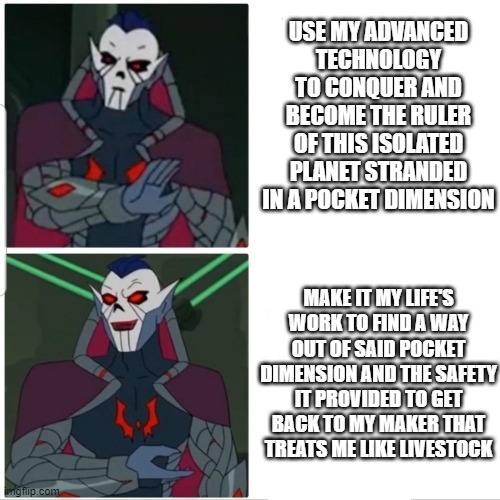
“vengeful” – and how did Hordak manifest this vengefulness? Who did he take revenge on in the series?
“apologize” – when and where in his 3 minutes of screentime would he remember everything after 2 mindwipes, realize that the whole worldview he had since inception is wrong, realize that he had been mistaken into doing the horrible things he did and then go to all of the characters and apologize for it?
Would anyone be convinced of that had it happened in 3 minutes? I’d rather they don’t redeem him than do a shit job at it.

Very true. He’s not a better person. He’s just a person in an impossible situation. Both Hordak and Catra were handed a raw deal, I don’t understand why everyone insists on pitting them against one another. They both did bad things and they were both in horrible situations. The specifics don’t really matter since neither of them would have done the things they did had they been more fortunate.

This is the exact reason for which I don’t hold Cara’s actions against her. Catra’s only model of success was Shadow Weaver. She emulated her abusive mother figure because she had no other example and because she wanted to please that woman. It does not excuse the way Catra acted but it explains it.
I really don’t understand why some people want Catra punished. I’d rather she get love and help. That is what she needs. In time, she will want to do better and be better by herself. She doesn’t need to be forced, heavens know, she’s been forced enough as it is.
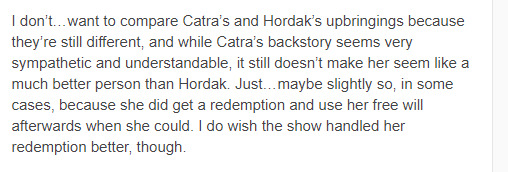
They are really different. Catra got an abusive, shitty and violent childhood. Hordak got this:
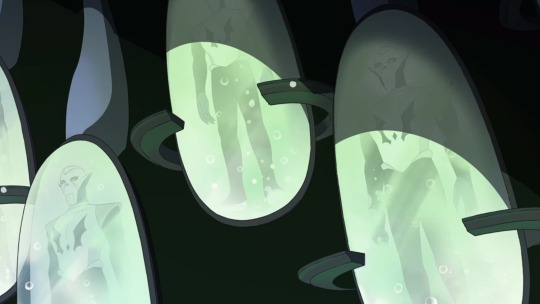
He was literally robbed of a childhood.
She was taught by Shadow Weaver that weakness gets you killed. Hordak was not allowed to have emotions to begin with, or thoughts of his own, or a name...
Comparing to victims of abuse to see which one of them is more likable is such a strange concept to me.

Catra was robbed in s5 too. I don’t hold that against her. I blame it on the writers. S5 could have been a lot better.
#Hordak#Catra#catra vs hordak discourse strikes again#can we please stop with this#it's been 6 months#my pixel is nicer than that pixel#a cartoon villain is not an actual despot#cartoon and fandom activism is not real activism#Cartoon characters can't apologize for their actions unless the writers make them#the writers in s5 were too busy with butchering the previous seasons to actually put any thought into the cohesiveness of this show's themes#everyone felt a bit ooc in s5#spop critical#spop fandom drama#spop
195 notes
·
View notes
Text
Notes and References for i know your eyes in the morning sun
Hi! These are notes and references for my IndoPhil fic i know your eyes in the morning sun, so please check it out before reading this!
Title: i know your eyes in the morning sun
Summary: When a homesick Indonesia is unexpectedly taken out of his meeting for a day trip in Rome with Philippines, he isn't expecting much more than exhaustion ahead of him. Instead, what happens is a whirlwind of food, fun, and a surprising amount of reflection on their histories and differences as nations. And as he looks deeper and deeper in the other nation's bright eyes, he learns to come to terms with the feelings he's been ignoring for far, far too long. Alternatively: a nation who's too attached to the past goes on a date with a nation whose entire philosophy is built on trying to live in the moment. Yes, there is kissing involved.
Read on: AO3 | FF.net
Scene 1: Pizza al taglio

As coincidence would have it, the G20 2021 Summit actually will be held in Rome, Italy. However, it’ll be on the end of October rather than the end of September like how its depicted in the fic. I’m also very much ignoring the COVID-19 pandemic. Pretend it never happened.
Borobudur is the largest Buddhist temple in the world, found in the island of Java, Indonesia. It was built way back in the 7th Century and it's probably Indonesia's top most visited site.
Terang bulan is basically like a really large, fluffy, folded pancake. It also has a variety of different names and is also eaten in Brunei, Malaysia, and Singapore.
If you could have a convenience store dedicated solely to pizza, that's what pizza al taglio establishments are like. Its literal translation is pizza by the cut, and since it's a lot more common to find in Rome than in other places in Italy, it's also called Roman-style pizza. The layout for the al taglio shop that Indonesia and Philippines go to is inspired from the shop that me and my family went to: a small family establishment just a short walk away from the Vatican.
You can actually find a recipe for Indonesia’s arugula and mozzarella pizza here: https://shared.publicmediaconnect.org/docs/atk/Pizza_Taglio_Cooks_Illustrated.pdf
Scene 2: Souvenir store + Bus stop


Indonesian rupiahs are notoriously hyperinflated, so the 15 euros that Philippines uses to buy the keychains convert to 250k+ rupiahs. That's around 50k short for actually being able to buy a local economy flight on Lion Air. For comparison, the same amount of euros convert to approximately 900 Philippine pesos. It’s also a few hundred pesos short of buying a local economy flight on Cebu Pacific.
There actually was a point when a G20 meeting was held in the Coliseum. It was the G20 culture ministers meeting just a few months ago, in July 2021.
Yes, on top of the thousands of festivals we already have, Filipinos also celebrate Oktoberfest! It's more of an excuse for local beer companies to shamelessly promote their product and encourage drinking fests on a massive scale, but a more legitimate Oktoberfest celebration is organized by the German Club in Manila. Lucky Philippines gets to celebrate it authentically in Munich with the German brothers, who historically aimed to conquer the Philippines before America managed to stake his claim. So if you sense that Germany is being oddly shy towards Philippines here, that's just Germany being embarrassed because of their history.
Italy's major international airport in Rome is Aeroporto Internazionale di Roma–Fiumicino "Leonardo da Vinci", so you generally just call it Fiumicino for short. A possible travel route for flying from the Philippines to Italy is Clark-Dubai-Rome, and another is Manila-Hong Kong-Rome.
Scene 3: Gianicolo

Bali, Boracay, and El Nido are beaches that serve as major tourist destinations.
Vietnam has already been mentioned to be a menace when she's drunk in her most recent character introduction. Laos is at the top of ASEAN when it comes to alcohol consumption, with the average Laotian drinking seven liters of pure alcohol every year.
Indonesia is sometimes known as the Invisible Nation. What this means to say is that there have not been many things that Indonesia has done that made massive waves on the global scale. From what I’ve read, this seems to have been an especially popular sentiment among Western analysts during the Cold War.
Australia's awkward attempt at an apology is a reference to when the Australian government had allegedly monitored and spied on the phone calls of several Indonesian officials. Indonesia and Australia have a history that goes far deeper than that though.
Monas is a common abbreviation for Indonesia's Monumen Nasional, proudly standing tall in the middle of Merdeka Square as a commemoration of the fight for Indonesian independence. Taman Surapati is a large, chill public park; it also has a monument dedicated to commemorating ASEAN there. Both are located in Jakarta, Indonesia's capital. Meanwhile, Philippines' mention of Luneta refers to Luneta Park. It's also known as Rizal Park, as it's the place where the national hero Jose Rizal was executed for the influence he had in encouraging the fight for Philippine independence.
In Rome, there are seven major hills: they formed the geographical heart of Ancient Rome, with Palatino and Campidoglio as the most significant given how connected they were to Rome's founding and Rome's religion. Gianicolo is outside the boundaries of Ancient Rome, and as such, it isn't counted among the seven hills. It is dedicated to the Roman god Janus and was a place for the augurs to divine the will of the gods — kind of like a prophecy, if a prophecy could be divined from bird entrails. Now it's a great spot for a scenic view of modern Rome which features, among other things, a large statue of Giuseppe Garibaldi. Garibaldi was a major figure in the Italian Reunification.
Nusantara means many different things, but in the era of the Majapahit empire, it referred to the vassal kingdoms in what is now modern-day Malaysia, Singapore, Brunei, Timor Leste, and the southern parts of modern-day Thailand and Philippines. Modern usage of the word in Indonesia generally refers to the Indonesian archipelago, but it can also be used to refer to the entirety of maritime Southeast Asia. Culturally and historically, Southeast Asia is divided into the mainland region (the countries connected to the Asian continent: Vietnam, Thailand, Cambodia, Laos, Myanmar) and maritime (the countries that are islands and archipelagos: Malaysia, Indonesia, Singapore, Brunei, Philippines).
Italy, together with the United Kingdom, is the largest European migration destination for Filipinos. The largest migration destination for Filipinos in general is America.
Shout-out to Ro-na for this wonderful headcanon of Philippines being sickly in his early days as a Spanish colony! The galleon ships used to facilitate trade between the Philippines and Mexico (perhaps the Philippines' most major contribution to the Spanish crown) would often be attacked by pirates or destroyed in typhoons, especially in the first few decades.
Majapahit and Srivijaya are only two of pre-colonial Indonesia's many powerful empires. A lot of the pre-colonial stuff has been simplified for brevity's sake, but a brief summary of it all basically goes like this: pre-colonial Indonesia was involved with everyone in maritime SEA, where everyone traded with each other; and mainland SEA was non-stop fighting where the major powers were the empires that would later become Vietnam and the Khmer empire that would influence everyone else in mainland SEA. You can find a more detailed look into mainland SEA history by Gemu in her posts here, who is my main influence for everything mainland SEA-related.
A young Brunei picking flowers for a young Philippines is a reference to all the marriages that had occurred between their nobility during the pre-colonial era.
Scene 4: Apartment

The turtle fountain in Rome is a real thing: Fontana delle Tartarughe was originally designed with dolphins in mind, but the dolphins were removed and replaced by turtles. In fandom, you usually see Philippines calling Indonesia kuya, which is Tagalog for older brother. In at least one Indonesian language (I can't remember which one at the moment, sorry!), kuya means turtle.
Tondo, Seludong, Butuan, Sulu, Sugbu, and Panay are all polities in pre-colonial Philippines, two for each of the main island groups in the country: Luzon in the north, Mindanao in the south, and Visayas in the middle. Unlike pre-colonial Indonesia, the societies in the Philippines were never united by a single kingdom or empire; the Philippine islands were only united through the efforts of Spanish and American colonization.
Filipinos tend to sing a lot. Many of us are really good at it. Karaoke is really popular here.
Philippines' PIN code of 8862 is a reference to when ASEAN was founded: August 8, 1962. The founding members were Philippines, Indonesia, Malaysia, Singapore, and Thailand.
This might be as good of a time as ever for me to mention that I am depicting Philippines and Indonesia as Catholic and Muslim respectively. Filipinos are predominantly Catholic and the Philippines is the largest Catholic country in Asia, while Indonesia has a number of official religions and is the largest Muslim nation in the world.
Special thanks to Desa for helping me with Indonesia's prayer times! Normally, Muslims pray five times a day, but when travelling Muslims are allowed to pray only three times. This is called Qasr salah, or Qasr sholat in Indonesia. What is usually Fajr (called Subuh in Indonesia), Zuhr, Asr, Magrib, and Isha becomes only Fajr, Zuhr-Asr, and Mahgrib-Isha; essentially, without getting into the specifics of time, a prayer for sunrise, afternoon, and night. The mosques will remind everyone when it's prayer time with adhan (called adzan in Indonesia), but in non-Muslim countries abroad, many Muslims have to use websites and apps to keep track. Something I didn't mention in the fic is that Rome actually has the largest mosque in the Western world, Moschea di Roma, so Indonesia could have potentially prayed there.
Scene 5: Apartment dinner table

Sholat wouldn’t take Indonesia more than a few minutes, so imagine that he did something else while waiting for Philippines to finish cooking.
Baked fish with sliced lemons is a meal that got served to me a lot in Italy. Chop suey is Chinese, but China has had a significant cultural influence for most of Southeast Asia throughout history; the Indonesian version is known as kap cay. Indomie Mi Goreng is a particularly tasty and famous kind of instant noodles from Indonesia. It's very popular in many Asian countries. Indonesia doesn’t drink, but Philippines is drinking white wine because that’s what you’re supposed to do when eating fish. Red wine goes with meat.
Admittedly, this is my own personal headcanon, but I like to think of Philippines living in Spain with the other Spanish colonies while everyone else in maritime SEA were left behind to live in their own countries. It's my own neat Hetalia universe explanation for how much Spanish influence there is in Filipino culture, and how isolated Filipinos can sometimes feel among their neighbors.
I do think that Philippines would have a Hispanic-sounding human name, but I've never really settled on what name actually would be: in fandom, Felipe, Lorenzo, and Jaime get thrown around a lot. In contrast, it seems like most people have settled on Dirga (short for Dirgantara) for Indonesia.
Philippines is sometimes called as la colonia abandonada in Spanish sources: the abandoned colony. Because the Philippines was so far away, Spain couldn't manage the colony directly and had to rely on Mexico/Nueva España to do the dirty work until Mexico became independent. This led to a more relaxed manner in how the country was managed for most of its Spanish colonial life; some scholars even go as far as saying that Spain's treatment of the Philippines was kinder than Spain's treatment of Latin America. I don't really agree — it was different, sure, but it wasn't kind in the least.
Contrast that with Indonesia as the largest and most important colony of the Dutch empire. Aside from all the money and economic prosperity that Indonesia gave to the empire, you'll also find many Dutch songs and hymns that are all praises to Indonesia. Much of the research in Indonesian history, ethnography, and archeology was made possible because of Dutch interest and support; until now, the Netherlands remains to be Europe's leader when it comes to Indonesian studies. This isn't to say that Netherlands treated Indonesia well, however.
After the Japanese occupation of Indonesia in WW2, Netherlands fought to keep power over the archipelago. Needless to say, the Netherlands failed. Indonesia was recognized as an independent country soon after.
Indië is the Dutch colonial name for Indonesia.
APEC is the Asia-Pacific Economic Cooperation, of which Philippines and Indonesia (and Thailand!) are members.
Scene 6 + 7: Apartment bedroom

What was Philippines doing in the 1920s, you ask? Being an American colony and trying to lobby for laws that would hasten his independence. Indonesia was in the middle of what’s called the Indonesian National Awakening; all the different peoples under Indonesia were beginning to come together and unite to fight for a single independent nation.
As a tarsier, Pien is actually supposed to be nocturnal; he shouldn't be sleeping at night at all. Maybe he just got jet lagged? Who knows.
BL stands for the boy's love genre of TV series. For years, Thailand had been the lead when it came to BL production with shows like TharnType and SOTUS. Recently, the Philippines has also been developing BL series — Gameboys specifically had achieved worldwide acclaim and is distributed globally through Netflix.
Filipino languages tend to have more complex verb conjugation and sentence structure compared to Bahasa Melayu and Bahasa Indonesia. The linguistic explanation for this is that most of the Filipino languages are based on the older Proto-Malayo-Polynesian language while Bahasa Melayu and Bahasa Indonesia are based on the newer, more simplified descendants of Proto-Malayo-Polynesian.
Pramoedya Ananta Toer was an Indonesian author that focused a lot of his work on nationalistic sentiments. He has a quote on bravery that I really like: Dalam hidup kita, cuma satu yang kita punya, yaitu keberanian. Kalau tidak punya itu, lantas apa harga hidup kita ini? Loosely translated, this reads as: In our life, we only have one thing, which is bravery. If it’s not, what is the value of our life?
Indonesia, as a large archipelago in the Pacific Ring of Fire, has a lot of active volcanoes. In contrast, the Philippines is regularly hit by tens of typhoons annually.
There are an estimated 12 million Filipinos overseas, and this number consistently rises through the years. It's one of the largest diaspora populations: name a country, you'll probably find a Filipino working there somewhere. OFWs (Overseas Filipino Workers) account for 10% of the country's population and the remittances they send back to their families account for 10% of the country's GDP. Indonesia has a similar phenomenon with TKIs (Tenaga Kerja Indonesia), of which there are 4.5 million worldwide.
Post-independence, Indonesia was very paranoid over Western influence in Southeast Asia. In that same time period, Philippine delegates to international conferences would always speak of democracy and the looming threat of Communism; even though most of the Asian delegates would prefer to move past Western problems and disputes to focus on a united Asia.
Telenovelas are soap operas produced in Latin America. They became popular in Southeast Asia as they were distributed and remade here. The Indonesian equivalent is the sinetron, and the Filipino equivalent is the teleserye.
Additionally, I cannot stress enough how much this fic is built on the foundations laid by others. I’ve already mentioned how much I took inspiration from Gemu’s depiction of mainland SEA, but I also credit Indonesia’s thing for temples to Desa; the passive-aggressive energy between Thailand and Philippines to Hali; amnesiac Piri to Koko, Kopi, and Sopas (among the many). There are a dozen other things I can attribute to a huge assortment of writers and artists: that Singapore has trouble remembering his pre-colonial roots as well, that Piri might have had a good relationship with Romano, Piri’s general flirty and flighty attitude, Indonesia’s awkwardness and big brother aura, etcetera, etcetera. If you’re someone that has been contributing to the SEA fandom these past few months, thank you. Thank you so much.
25 notes
·
View notes
Text
The Revival of Akillian: Chapter 9
Prologue / Chapter 8 / Chapter 10
9. NEGOTIATIONS
At six o’clock sharp, Micro-Ice’s alarm clock starts screaming “Get up, Micro-Ice! It’s time!” to the tune of “Your Tracks in the Snow”, the latest hit from Freeze, number 1 in Akillian’s Top 10.
- Grmph! - the boy grumbles, pulling the quilt over his head. – Already? Tell me it’s a nightmare!
In the bed across from him, D’jok straightens up and stretches, yawning.
- Did you sleep badly? I dozed off like Ahito.
- I can imagine. (Micro-Ice emerges from under the duvet and whacks the clock to turn it off) You didn't have to put up with a crazy guy who kept going on about how he would be the greatest football player in the galaxy, all night!
- Are you talking about me? Did I talk in my sleep?
Micro-Ice sits up and stretches. D’jok is already out of bed.
- If only that’s all you did! Right then, it seemed like you had won the Galactik Football Cup all by yourself. In just one night!
- And why not? – questions D’jok, grabbing a towel from his locker to go to the shower.
- Why not what?
- Why wouldn’t we win the Cup?
- There are many reasons! - Micro-Ice shrugs. - Stop dreaming, D’jok… we’re awake now, you know?
“Hello everyone,” Aarch’s voice sounds through a speaker built into the ceiling. “You have exactly half an hour to get ready and join the holo-trainer. Be happy, Micro-Ice: you are finally going to play a match!”
Half an hour later (Aarch does not tolerate delays, nor lack of discipline in general), they all find themselves in the holo-trainer, separated into two groups: on one side, in yellow, are Tia, D’jok and Micro-Ice with Ahito in goal; on the other, in purple, are Mei, Thran and Sinedd, the goalkeeper being represented by a sim. D’jok and Sinedd look at each other.
- Let's go! – calls Clamp, with the press of a button.
The ball bursts from the center hole, flaring between D’jok and Sinedd, attackers of each team. Immediately, there is a fight between the two rivals to recover it. D’jok wins with a short header, passing to Micro-Ice. Thran intercepts the ball with his chest. He passes to Mei, who is immediately tackled by Tia, who returns the ball to D’jok. He rushes towards the goals and finds Sinedd in his way, who sticks to him like a leech. With no other solution than to get rid of the ball, he sends it back to Micro-Ice. Thran immediately comes to mark him, but Micro-Ice manages to dribble around by juggling the ball, foot-head-chest, so fast that Thran can no longer follow... a final flip-flop and presto, Micro-Ice is free from Thran, rushing in turn towards the goal, in which the sim bounces from one foot to the other, his eyes following the trajectory of the ball exactly. Sinedd rushes after Micro-Ice… he throws his foot forward, hitting him in the calf and sending him tumbling onto the fake grass.
- Can’t stand up, Micro-Chip? – taunts Sinedd.
Micro-Ice grabs his leg, wincing in pain – if only that was virtual! Tia comes to his aid, helping him up.
- Foul! - shouts Aarch, who had replayed the footage in slow motion on the console.
- I'll get him, that jerk. – grumbles Micro-Ice.
Leaning on Tia, he casts a hateful look at Sinedd, who walks up to his team with his head held high and his face smirking.
D’jok will take the free kick. The three purple players make a wall in front of the goal. Mei gives Sinedd a look, whether one of reproach or admiration, it’s hard to say. D’jok takes a few steps forward... he runs and fires full force. The ball grazes Sinedd's head - who pulls away at the last minute – and bounces off the top bar of the goal, launching into oblivion.
- What strength! – exclaims Clamp in front of his console. - 120 km/h, are you seeing this?
- I would have preferred if he were shooting less hard but his shot was on target! - reproaches Aarch, in front of the general monitor.
The match continues, with varying degrees of success and a number of errors: missed passes, aborted dribbles, corners, players who collide to retrieve the ball… a somewhat sterile duel between D’jok and Sinedd, about who will hit the hardest or farthest, or who will score a goal first, to the detriment of a less spectacular but more constructed team play.
- Do you know what we’re missing, Aarch? – prompts Clamp with a smirk.
- Time, - Aarch replies, not smiling at all. - A lot of time!
- Maybe, yes... but we would gain a lot if we recruited a good passer... if you know what I mean!
Having managed to steal the ball away from Sinedd, D’jok arrives in front of the purples’ goal, but is blocked by Mei and Thran, who surround him and leave him no way out. Having no one within walking distance, D’jok is forced to shoot in the air, by guesswork... suddenly a kind of rocket flies above him, stops the ball in the sky in a blaze of moving waves, rolls over onto her back and swings her foot on the fly - the ball shoots towards the goals like a missile, hits the poor blue sim and pulverizes him, then sinks into the back of the net.
- Waaaouh! What a goal! - exclaims D’jok in shock.
As usual, Tia takes no personal pride in this. No sooner has she landed than she gets up and goes back to her place, as if nothing had happened.
- Little Tia seems to have adapted perfectly to my holo-trainer! - rejoices Clamp. - I told you, Aarch: with your ideas and my machines, we’ll get there, you’ll see!
A few miles away, in his office in the luxury Confederation building, Artegor Nexus watches Tia’s Breath-magnified goal on his own console. Behind the screen is a small device, no bigger than a credit card, its green LEDs flashing frantically: reception is perfect.
Hacking into Clamp’s hardware proved too easy: Jorg didn't need to break in, or bribe anyone. It was easier to enter the Arena Stadium than a spaceport... if Aarch and his friends continue to be so naive, thinks Artegor, the Red Tigers will hardly have to make an effort to crush them, even with this kid who possesses the Breath: so long as one has studied the tactics of the adversary well and knows all their secret moves...
Artegor pauses his console and opens a transpace channel for an interstellar call: he must send his report to the Honorable Galahaas, Grandmaster of the Shadow Council.
***
The Interplanetary League of Galactik Football has its headquarters on the planet Oeno, a cosmopolitan world mainly made up of archipelagos scattered over a vast pink ocean. This bizarre color of the water, combined with a light but permanent haze, tints the sky over Oeno purple, which, lit by two synchronously rotating stars, offers the most magnificent sunsets in the entire Galaxy. Bathed in a climate of roughly equal mildness from pole to pole, Oeno is a paradise for tourism, water sports and floating palaces. The League’s headquarters, on the edge of a lagoon of delicately pearly waters, is a bizarre construction meant to feature two stylized players, standing up to retrieve a football. But, apart from the sphere which sits at its top, nothing makes it possible to distinguish such a symbol: the building is rather a mess of columns, pillars, and flying buttresses... the architect, a Cyclops, apparently only had a vague idea of humanoid anatomy.
Massimo Spoto, human delegate to the League and vice-president of the Homologation Commission, introduces himself to the receptionist in the vast hall which serves as the entrance, a sort of cathedral all in glass and wooden beams, and steel that rises to a dizzying height, which makes one wonder, considering its incredible angles and overhangs, how it stands at all.
- Is the Commission meeting taking place on the fifteenth floor?
- Yes, sir, it is. - answers the hostess. - Do you have your accreditation? (Spoto shows her the small holo-card) Perfect, sir. The elevators are at the end of the hall.
- I know, thanks.
As he walks towards the elevators, Spoto notices a man sitting in an armchair, absorbed in reading a newscast. He recognizes him: that curved nose, those thick lips, those fancy features, that rebellious lock on smooth, shiny hair… General Bleylok, here? On the day of the Commission’s vote? Bad sign…
Bleylok is one of the leaders of Technoid, and the leader of what is customarily called the Cartel, this square of vengeful officers, nostalgic for the time when Technoid was the main military force of the Galaxy, when it could have made Humans absolute masters of the two most powerful fluxes: the Smog of the Shadows and the Charge of the Lightnings… yet when the Shadow Wars broke out, Bleylok was barely born. Spoto suspects the general of harboring in his fiendish heart something far worse than a spirit of revenge: an inordinate ambition, an unquenchable thirst for power. However, all this hardly concerns the vice-president of the Homologation Commission… except that Bleylok – and therefore Technoid, or at least the Cartel - took a sudden interest for the new Akillian team trained by Aarch, the former star striker of the planet. An interest that Spoto cannot explain, because this team has not yet proven itself and demonstrated the slightest ability to measure up to the current stars of Galactik Football…
Bleylok joins Spoto in the elevator and presses the button for the tenth floor. Being a rather frank man, Spoto decides to attack him head-on:
- There is one thing I do not understand, Bleylok. Why does Technoid want Aarch’s team to be homologated so much?
- I don’t speak for Technoid. - answers Bleylok coldly.
- Ah, excuse me. So why are you, Bleylok, Cartel general, so keen to have this team certified?
- It’s none of your business.
- Yet this is my vote!
- This is my floor. - evades the general.
The elevator doors open on the tenth floor. Before exiting, Bleylok hands Spoto a small briefcase, then slips away with a smile and a small nod.
- But, wait…
Too late: the doors close and the cabin resumes its ascent. Intrigued, Spoto opens the briefcase...
Credits. Thousands of credits.
Because he is vice-chairman of the Homologation Commission, Spoto's voice counts for two...
***
Taking advantage of the fact that the evening is “free time”, Micro-Ice had gone back to see his mother in the Cafeteria. He wanted some good hot chocolate and a slice of pie, just to make a change from the “special sport” vitamin food scientifically studied by Clamp and prepared like a chemical formula by a Scrap, thereby being entirely tasteless. In fact, he mostly wanted to complain and pamper himself a little.
- I have never worked so hard in my life! - he whimpers, slumped over the counter. - It’s sure worse than the ice mines. I’m aching all over, even my hair!
- I saw you on TV, - Gail smiles, stroking his chin. - You were very good!
Micro-Ice straightens up at this and smiles.
- Really? Didn’t I look too tense, mom?
- Nervous, you? The only times you look upset are when you’re sick. (She serves him a large mug of steaming hot chocolate to accompany his slice of pie) What about D’jok and the others? Didn't they come down with you?
- They stayed over there to watch a game on TV. (Micro-Ice sighs, bites into his pie, and swallows a sip of hot chocolate) How do they manage to watch more football? It’s beyond me. If I see one more ball, I’ll pulverize it!
- My poor darling, you’re going to be seeing a lot more balls!
- Why do you say that, mom?
Gail smiles at him again, barely concealing her pride.
- I just heard on TV that your team has been officially recognized by the League...
D’jok, Thran and Ahito (well: if he wasn’t asleep) are also hearing of this in front of the wall-mounted screen in the “relaxation room” in the depths of the Arena Stadium. Live from the League headquarters on Oeno, the unrelenting Callie Mystic clarifies:
- It is now up to the Federation to organize a match between the Red Tigers team and that of Aarch, in order to determine which of the two will have the honor of wearing Akillian’s colors during the qualifying phases of the next Galactik Football Cup...
- Yeah! - D’jok exclaims, punching the air. - I tell you, we will win this cup! I can smell it, yeah!
- You’re right, D’jok! – agrees Thran. - We are awesome!
The two high-five over Ahito’s head, who suddenly wakes up.
- Yeah, awesome! Go, Warren! - he cries.
- Hey, brother, the match is over…
Thran breaks the news to him and the three of them hug, congratulate each other, pat each other on the shoulder, and jump in excitement, shouting victoriously. As they enter the room, Aarch and Clamp observe this joyous commotion.
- At least they’re motivated… - Aarch sighs.
Clamp rests a compassionate hand on his friend’s shoulder.
- We still have a few days to train as much as possible… plus, there’s the friendly match against the Wambas. We’ll get there, Aarch!
- Not without a proper passer. (He clenches his fist) I have to try again. How do I convince him, damn it!
***
Norata is suddenly awakened by a noise. He sits up in bed, heart pounding, and listens... yes, he recognizes a creaking sound: that of the front door, the slides of which have started to rust because of all the humidity from the plants. Good heavens! If he catches Rocket running away to join this bunch of freaks at the old stadium...
He jumps out of bed, puts on a jacket, arms himself with a powerful halogen torch, and hobbles as fast as he can to the entrance, going out into the courtyard which he sweeps over with the beam of his torch: the jet-snow has not moved… but there, next to it - footprints! A robber?
Footsteps behind him in his house! He turns around abruptly, to shine his torch at a face. A face he knows all too well, even though he tried to forget it for fifteen years...
- Do you remember our reaction when dad banned us from playing soccer? - reminisces Aarch. - We wanted to build a rocket so we could escape to another planet!
- If I had listened to dad, I would still have my leg today. - Norata retorts, lowering his torch nonetheless.
- And you would have died like him in the Catastrophe! In any case, we would never have shared all these moments that we lived together... when we set out to conquer the world. Your son is very talented, Norata. Far more talented than we were at his age. He can become a galaxy-renown player!
Norata frowns suspiciously.
- What makes you think he’s good?
Aarch frowns: apparently his father doesn’t know about Rocket’s visit to Arena Stadium, or his training session.
- I can feel it, that’s all. - he evades. - Question of genes, no doubt...
- Good or not, he will be a florist on Akillian, period! There is nothing wrong with that, it is an honorable job!
- But football is his passion, you know that very well!
Norata shines his torch at his brother’s face again.
- You’re here on private property. I’ll ask you to leave, or I’ll call the police!
- Okay, I understood. I won’t bother you with this football thing anymore. You have my word. (Aarch slowly steps out the door, then turns back on the threshold) Farewell, Norata.
Norata watches Aarch go into the night, his head bowed, his step heavy. He remembers that rocket story well. He was eight years old, his brother ten. It was Aarch who drew up the plans. Then the two of them had gone to Arcadia’s Brico-Store to look for materials. The salesman’s eyes had opened wide, and he had laughed at them. “Build a rocket? Sure, no problem. But it’s not a toy store here. We sell gear for grown-ups... you’re not even old enough to handle a laser drill”. Aarch then realized that this business was really beyond their reach. Both had been sorely disappointed... but they left the planet anyway. Later.
Norata rushes to the porch.
- Aarch!
His brother comes to a stop in the snow in the yard, and pivots slowly. Norata holds up one finger.
- One match. I’ll leave you Rocket for one single match: the one against the Red Tigers. If you lose this match, Rocket comes right back here, and I never want to hear from you again. Never!
***
Curled up in the bed of his hotel room, Wouwambou, the captain of Team Wamba, coughs, shivering and chattering his teeth, eyes murky and gray in complexion. What an idea he had to want to accompany his trainer on this cursed frozen planet! While he was so at home, in the heart of the jungle, where the temperature is around forty degrees... but when he learned that the Akillian Federation was offering the trip for two in order to negotiate the conditions of the game of Aarch’s team against the Wambas, he jumped at the chance: the Wambas are a peaceful but poor people, footballers are very poorly paid by galactic standards (although they earn more than enough to live comfortably on their planet) and interplanetary travel is usually an expensive dream...
But Wouwambou had forgotten that, on Akillian, the average temperature is minus ten. As a result, he’s got a rife fever, he’s sick like a swamp gnok. He waits for the doctor, but wonders how he will be able to pay him: a bad flu was not included in the fees… and a doctor’s fee on Akillian is one month’s salary for a Wamba! Too bad, he has to get better, otherwise he will die here, and his team needs him...
There is a knock on the bedroom door. Ah, the doctor, finally!
- Come in, - he manages to articulate in a hoarse voice, between fits of coughing.
It’s not the doctor. Unless Artegor Nexus has changed jobs...
- What... what do you want? How did you find me?
- Why, - smiles Artegor. - When you are a fan of the Wambas like me, you will stop at nothing to visit their illustrious captain! But... it looks like you have a bad flu, my friend?
- Yes, I’m waiting for the doctor...
- And you don’t have enough to pay for one, I imagine? I know the Wambas are not rich...
Wouwambou stares at Artegor with his feverish eyes, wondering where he is going with this. The Red Tigers coach takes a wad of credits out of his pocket and places it on the bedside table.
- With that, you will have enough for a good treatment.
- But what... why...
Wouwambou doesn’t finish, seized with a new bout of coughing. Artegor places a holo-card reader on the table, then walks back to the bedroom door and says in an icy tone:
- She must not be able to play. Ever again. Am I clear enough? I am counting on you, dear friend!
The door slams behind Artegor Nexus. With a trembling finger, Wouwambou activates the reader. In the small field appears a slender young girl with silver hair, kicking a ball ferociously. A halo of bluish lightning emanates from her.
21 notes
·
View notes
Text
As the World Falls Apart
Read on Ao3
Padmé watches Obi-Wan rock Leia around the ship, willing her to stop crying. He shushes and coos at her as he gently pats her back. Nothing seems to work. He’s been trying for the past hour or so. Leia has a strong pair of lungs and doesn’t seem to be stopping anytime soon. Even as Obi-Wan practically begs her to stop crying. Nothing works. They’ve tried feeding her. They’ve tried changing. At this point she’s just crying for the sake of it. She’s sure of it.
Obi-Wan looks dead on his feet as he paces from one part of the cockpit to the other. His eyes are bloodshot, red and splotchy. Dark bags under his eyes. His clothes are scorched and burnt. Hair tousled. He’s limping slightly. She hasn’t said anything about it, but she assumes it’s from his fight with Grievous. He hasn’t smiled once since they got back from Mustafar - not even one of his fake ones he puts on sometimes. (Except when the twins were born, but even that smile, while fond and loving, had been filled with heartbreak.) In fact, he looks miserable right now. Like he’s on the verge of crying. He probably is, Padmé muses. Padmé kinda feels like crying too.
She had offered to take Leia off him, but he had refused. Told her to remain seated, a dozing baby Luke in her arms. It was typical of him, really. Obi-Wan had always been good at giving pieces of himself, even at the expense of himself. He had been like that as long as they’d been friends.
It’s strange. How it has merely been hours since the twins had been born. And now they were hurtling through hyperspace. Master Yoda had told them to go to Naboo with the twins and go into hiding. Obi-Wan would serve as protection and a teacher once Luke and Leia start showing force sensitive abilities. They’ll need to learn how to control it. Padmé is just grateful she’s not going to be alone, and she’s sure Obi-Wan feels the same. She is grateful for his company, no matter how miserable they both might be right now. At least it’s something.
She’s glad he snuck onboard the ship when she went to Mustafar. She’s not sure what would have happened if he hadn’t. She thought she could talk some sense into him. Obi-Wan had probably thought so too. Even after all he’d done she still loved him. She continued to love him, even if he broke her heart. Obi-Wan too.
Anakin had always said he and Obi-Wan were closer than most jedi. That they were like brothers. That Obi-Wan had been like a father to him. Looking at him now, there’s no doubt the love was mutual. And as a mother now, she feels like she gets him better than she ever has. All of Anakin’s stories about Obi-Wan. Their little misadventures.
They were like two halves of a whole, and Padmé can’t help but feel like Obi-Wan died with Anakin on Mustafar in some way. The Obi-Wan in front of her is almost like a shell of the man she knew.
She can’t imagine having to do what Obi-Wan did. It’s just not fair. But things are rarely fair. With the war rampaging the galaxy, sith lords at every corner. The galaxy has never been fair, but it could at least try for Obi-Wan’s sake. Padmé can’t imagine being only thirty-eight years old and knowing as much heartbreak as Obi-Wan does. She can’t help but admire his strength. That he’s still standing right now. Padmé honestly feels like she’s going to break any moment.
And if Leia doesn’t stop crying soon she might start crying too.
Leia’s screeching is ear-piercing. She’s red in the face from the sheer effort of it. Tiny fists balled into the fabric of Obi-Wan’s tunic, tears streaming down her small face. It’s a miracle she hasn’t worn herself out by now. Padmé sure would have.
God she hopes this isn’t going to be a regular thing. She’s not sure she can take it. And from the looks of things Obi-Wan doesn’t either. Taking care of twins is going to be enough work, but having to deal with twins and a screaming baby sounds damn near impossible. Even for two people.
R2 beeps in sympathy from where he’s piloting the ship.
Padmé closes her eyes, preparing for the impending headache she knows she’s gonna get soon. But then the screeching stops. It just stops. Padmé can’t believe her ears, but when she opens her eyes again Leia seems to have settled against Obi-Wan’s shoulder, eyes half lidded and body lax. Obi-Wan looks at her with bewilderment. As if he can’t believe it either.
A range of emotions crosses his features before he closes his eyes, in utter relief, and lets out a choked sound. Something like a sob. It’s an utterly pathetic and pitiful sound. Something that’s not very becoming of a Jedi master. But she finds that she agrees as she smiles at him. Wet and a little crooked, but relieved.
But that’s not the end of it. It’s like the floodgates have finally opened - that the dam has broken - because Obi-Wan chokes back another sob. And another. And another. And then there are tears running down his cheeks and disappearing into his beard. And he’s sniffling as he suppresses shudders in an attempt to not disturb the now calm baby.
“Obi-Wan?” she murmurs, just loud enough for him to hear her. “Why don’t you sit down. You must be exhausted.”
He nods. “Y-yes that— that— I’m so-sorry. I—” He gasps and hiccups as he stumbles over the words. It’s truly a pitiful sight.
She does her best to put on a warm and comforting smile. Even as her whole body aches, she stands up and walks over to him, careful not to jostle Luke too much. She’s never seen him like this before, and if her heart didn’t feel like it was already shattered into a million pieces it would break even more now. “It’s okay,” she tells him, putting a hand on his arm. His tattered sleeve full of burns and holes. “It’s okay.”
Gently, she guides him back to the pilot’s seat and he slumps down into it. His sobs subsiding into quiet sniffles and silent tears. Leia appears to have drifted off to sleep, thank the stars. Padmé isn’t sure she can handle much more at this point. She envies them. The twins. And their ability to just fall asleep as the world falls apart around them. They haven’t got a clue what’s happening around them. Everything is in shambles, and she’s grateful that they’re blissfully unaware of it all.
The ship rumbles beneath their feet. It’s a sturdy craft. Skillfully built and probably expensive, but awfully boringly decorated on the inside. It’s nothing like Padmé’s ships. But she supposes the jedi don’t really care for such.
“I’m sorry,” Obi-Wan croaks after a while. “I mean it.”
Padmé raises a brow at him. “Why?”
“I failed him. I failed Anakin,” he says, voice tight as he avoids her gaze. the light of the stars dancing across his features and glimmering in his glassy eyes. “I should have realised something was wrong. He was my padawan. I should have known.”
“Obi-Wan,” she murmurs. “Palpatine groomed and manipulated him for years. It’s not your fault. There’s nothing you could have done. We did our best.”
“I shouldn’t have let him see him. I always knew there was something about him.”
The corner of Padmé’s lips quirk upwards. “I never liked him either,” she says. To which Obi-Wan smiles at her, albeit faintly and ever so briefly. At least it’s something.
Leia continues to doze on Obi-Wan’s chest, ear pressed to his chest where his heart beats below his ribcage. She looks so small with his hand almost covering up her entire back. She just wishes anakin was here. So he could enjoy his children with her. Like he should. But she supposes Obi-Wan will have to do. As far as she’s concerned, he is the next best thing. He did raise Anakin, after all.
Padmé breaks the silence. “So what does this make you then?” she asks, humour in her voice. “Grandpa Obi-Wan?”
She hears the jedi snort. “Surely I’m too young for such a title.”
“Oh yeah, old man? Pretty sure I heard your joints pop when you sat down just now.”
“You’re going to regret saying those words in ten years time when you’re my age.”
Padmé smiles, a real, genuine smile, for what feels like the first time in forever. She even chuckles a little. A little quiet and awkward, but genuine. When she looks at Obi-Wan he is smiling so wide it reaches his eyes.
They’ll be exiting hyperspace soon, but right now they can rest. Just her, her children and Obi-Wan. Some ragtag team for a family, but she doesn't really mind the idea of it. There’s just something missing.
Obi-Wan strokes Leia’s back so gently it almost looks like he’s afraid to break her. He watches her with such softness and adoration it makes Padmé’s heart swell. He has only known them for a day and he already loves them. Anakin would be ecstatic.
“I just wish Anakin was here.”
Obi-wan stops stroking Leia’s back momentarily, fixing her with a gaze she can’t quite deschipher. “Me too,” he murmurs. “They’re wonderful, Padmé. He would have adored them.”
Padmé nods, a sad smile on her face. “He would have.” Her heart aches at the thought of it, but she appreciates the sentiment. “I’m glad you’re here though, Obi-Wan. It means a lot that I’m not alone.”
“I’m glad too, dear,” he tells her softly. “I’m not sure what I’d do if— I mean—” He swallows thickly. “—Almost everyone I knew is dead. Mace, Bant, Luminara, Quin… Ahsoka. Oh god, Ahsoka.”
Padmé can almost feel the grief in the air. She wonders if this is what it’s like to be a jedi. To have one of those bonds that Anakin had talked about.
“I’m sorry too,” she tells him. “About the jedi, and the clones… And Anakin. I know you loved him.”
Obi-Wan closes his eyes and nods solemnly. He doesn’t need to say anything. She understands. She reaches out and grabs his hand where it lies limply in his lap. It’s calloused and scarred, but warm and gentle. Obi-Wan’s hand is warm and firm in her hand. A little bigger than hers, a little rougher. The hand of a jedi. Of a long life lived. Of a friend. A mentor. Even a father. She can imagine him ruffling a young Anakin’s hair with. Righting Ahsoka’s grip on her lightsaber. Shaking her hand at events. She gives his hand a squeeze and hopes he gets it. He does. He squeezes her hand back. They sit like that for the rest of the journey.
They exit hyperspace, the ship jolting slightly from it. In the distance Padmé spots Naboo. As long as she had lived on Coruscant Naboo would always be her home. And now it would be Obi-Wan’s too, she supposes. She looks over at him and finds him with his eyes closed. As if he’s asleep. She smiles. She can wait to wake him until they’ve landed. He could use the rest. She could too, honestly.
She misses Anakin already. Not the man she saw on Mustafar, but the man she fell in love with. The father of her children. The man that loved, and was loved in return. Her Anakin. Obi-Wan’s Anakin. Ahsoka’s Anakin. A man that was flawed, but good. A man that was kind. Her husband. Ahsoka’s master. Obi-Wan’s padawan. God, she misses him. Just the thought of him makes her heart ache.
They’ll be okay, Padmé thinks. Not right now. Maybe not for a while. But one day. She’s sure of it. They’ve survived so far. They’ve got each other. They just need a moment of quiet. Just a little moment. They’ll be okay. Just not right now.
#star wars#sw#star wars prequels#star wars clone wars#star wars fanfiction#sw fanfic#obi wan kenobi#padme amidala#leia organa#luke skywalker#r2d2#anakin skywalker#star wars obi wan#star wars padme#star wars luke#star wars leia#star wars anakin#fanfic#fics#my fics#mine#a jedi a senator and two force sensitive children
23 notes
·
View notes
Text
Belter - Tommy Shelby
a bit of Tommy fluff based on Belter by Gerry Cinnamon, because thats what the world needs right now.
i hope youre all doing well and staying inside and safe! nothing lasts forever <3
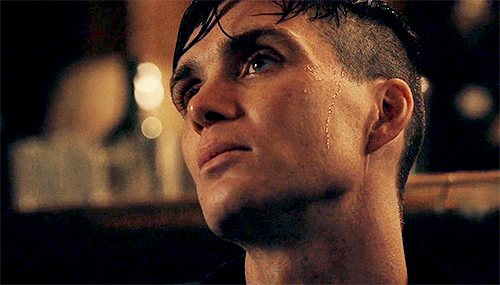
She is a belter
Different from the rest
Tommy saw you as soon as you walked through the door. It wasn't like when he saw Grace or Greta, he felt you. You took his breath away, you made the most powerful man in Birmingham speechless, without even knowing it.
Diamonds on her finger
And she always looks her best
You looked like something from his dreams, from any mans dreams. Every single light in that room hit your dress; you shimmered. He couldn't ignore you if he tried.
He would never know of the time you spent in the mirror, scrutinising ever part of your body and picking yourself apart - to him you were immaculate.
She is a gangster
With a hundred mile stare
When she walks
Her feet don't touch the flair
You were Tommys ride or die, and everyone knew it. Nobody touched Mrs Shelby - those who didn't know you well feared tommy too much to do you wrong but the ones who did feared you.
Just as smart as tommy, you were his equal. Arthur and John were no match for you quick wit, you could level with Ada on complex politics and even Polly admired your strength of character;
“she's a good one Tommy, that lass, but god be with you if you ever do her wrong”
She plays with lightning
I'm a hundred miles high
Dishing out the thunder
Like a God inside the sky
You had no fear of Tommy, and he loved that about you. the way you spoke to him, the way you teased him - made him weak. When you were alone together you had all the power. He would do anything you said, and it both terrified and excited him. Sometimes you let him have a flavour of that control, let him take the reins. But he knew it was all on your terms - he would serve you in any way possible, anything to hear the way his name sounded from your lips.
How can she reach me
When I'm high above the shelf
Lost inside a smoke ring
While I ponder to myself
At first the Shelbys accepted you because they had too; Tommys girl was part of the family whether they liked it or not. However, when they saw how you could deal with him, talk him out from those dark corners of his brain he often dwelled in. You brought back parts of Tommy that they hadn't seen since before the war, parts they thought they would never see again. And for that, they welcomed you into the family with open arms.
Is happiness an option
Or has love just turned me blind
It took Tommy a while to actually believe you would stay. He found it hard to believe that someone as good as you would be willing to blend their future with a man like him. He felt like he wasn't worthy of the happiness he felt when you were around him, the euphoria he felt under your touch. After all the bad things he had done, how could any god grant him such an angel like yourself. He'd lost love in the past, he knew the feeling of heartbreak and he also knew he could survive it - but he doubted losing you would compare. He had found someone he genuinely couldn't imagine a future without, and it scared him shitless.
No happy endings
Unless fairytales comes true
But she looks like a princess
And there's not much else to do
He tried to turn you away, tried to deny the attraction he felt every time he was in your presence - but it was simply a battle he didn't want to fight nor did he enjoy. All it took was a bit of interest from you and he would lose all resolve, all common scene. You brought him to his knees and he would let you every time.
She gets underneath my skin
But I've been stung a few times
So I don't let no one in
No even belters
it would take a while for you to get inside that head of his, truly. Tommy had built so many walls to protect himself over the years that they were heard to bring down, even when he wanted to let you in. But Tommy was worth the effort, even if he didn't believe it himself. You loved him and you were willing to put in the leg work to prove he could trust you with all the sides to his personal.
She is a Belter.
#Tommy Shelby#tommy shelby imagine#tommy shelby x reader#tommy shelby x oc#peaky blinder imagine#Peaky Blinders#peaky blinder headcanon#Arthur Shelby#John Shelby#Ada Shelby#polly gray
107 notes
·
View notes
Text
Erendor x Samara Headcanons
This somehow happened... even though they are literally my least favorite Winx characters. I wanted to develop them somewhat more so that I could stop despising them so much. I think it worked... even though there are some problematic things.
TW for mentions of murder and infertility.
It was a semi arranged marriage in that Erendor was the one who was having negotiations with Samara’s family since he was already king. His parents were currently residing at one of their numerous estates, however, and were as removed from the ruling of the kingdom as possible since the monarchy was hanging by a thread. Erendor had to find a way to settle the growing tension for which he needed some strong allies and it just so happened that Samara’s family was the most influential.
Samara was actually a second child but her elder sister was already promised to a nobleman from another famous lineage and pulling that apart would be bad for the monarchy as well as the other family was bound to turn against them. So Erendor was to marry Samara and have the endorsement not only of her family, but also the new house that her sister was to join soon. They had a perfunctory engagement that only served to not make it look like the situation of the monarchy was so dire that Erendor was taking desperate measures to stabilize it. They married as soon as possible to fortify the alliance and start working on continuing the royal bloodline.
Samara was extremely good at pretending and showing exactly what was expected of her. Her mother had been dragging her to beauty pageants ever since she’d had anything to show in the talent portions of the competitions and she’d learned from little to read what people expected from her and then show them just what they wanted to see. She could get under anyone’s skin and steer them into doing whatever she wanted. It was the skill she’d perfected while her sister had spent more time in education as they’d hoped for a better marriage for her. Samara’s mother had hoped exactly for that result as it gave them guarantee that Samara would be able to control her husband while they controlled her to give them even more influence and power.
Erendor was wary of Samara at first. He was way more observant back then when the future was being built on a day to day basis and he’d seen enough to know she could charm anyone, which made her the one with the real power in their marriage. He had to win her over on his side if he wanted to ever have any real control over Eraklyon and that would be a challenge since she already had everything she could want, including the crown. He could never beat her at her own game so he tried a different approach by being dangerously honest with her which threw her off every time to give him an opportunity to peek under her facade and get to know her better.
He learned that the price of her smile was a ring on her finger and the price of her heart was holding her hand in his. She was indeed used to getting everything she wanted but he hadn’t known she wanted commitment to her that her family had never shown as they’d been using her ever since she’d learned to walk and freedom that she could only get if she had more power in her grasp than her mother held. He paid enough attention to her to learn how to never disappoint her with a gift and gave her the choice of what to do with the power she held – give him equal control of it by taking his hand or keep being pulled like a doll by the strings her mother had wrapped around her until death cut them off. He gave her the decision to choose whose hands to put the control over the kingdom in and that was more than her family had ever given her.
Her mother never expected that Samara could choose her husband over them. She’d never thought that a man could win her daughter’s trust after she’d raised her to view people as means to an end because that was how they’d view her. It was too late by the time she realized she’d made a mistake by demonstrating that to Samara herself. Her daughter had all the important people in her hand and she put them in Erendor’s pocket to throw her family so out of the loop they would never be able to come back. They lost any control they had not just over the kingdom but over most of their estate and assets as well and had to leave Eraklyon before Samara bankrupted them completely. She didn’t spare the family her sister married into either in case her mother tried to make her comeback via them and all the wealth was distributed to the struggling economical branches to patch up both the holes in the kingdom’s resources and those in the people’s trust.
The monarchy was saved and the two of them were left with their blooming alliance. They got along perfectly when he asked her opinion on everything and let her handle most of the diplomacy, only ever interfering when his presence was needed. Outside of the throne room, their shared time was limited by mutual agreement. Samara liked to use her newly found freedom to choose her personal endeavors herself and Erendor could use the break on his ego (he knows he couldn’t have done it without her but sometimes it is still hard to swallow his pride even though Samara has never flaunted the fact in his face, perhaps due to her own experiences of being dependent on someone else).
Besides, it takes them both a little while to process whatever slips into one of those honest conversations they tend to have in the middle of the night–there’s always room for Samara in his bedchamber and she’s rarely refused an invitation to go as well–or early in the morning over breakfast. He still catches her off guard–and himself, too–when he admits something that requires trust that their mutually beneficial deal does not justify. Samara actually likes it because it feels like she can trust it’s real and she’s even confessed a couple of things herself on her own initiative even though the word love has never been approached by either one of them. Erendor’s honesty is always blunt and has zero romance to it but Samara prefers it that way as she’s not sure how long it will take her to trust romance.
It all seemed well until they learned that Samara had fertility issues that got in the way of conceiving an heir. Samara retreated and locked herself into her bedchamber. She wouldn’t even let Erendor in, let alone go to the throne room or even the dining hall. Erendor had to forbid all maids and other servants from going to her until she came out, steaming about him breaking their deal that they were equals and he couldn’t control her. Not the best plan to get her to talk in hindsight but he didn’t have much choice.
They talked once Erendor explained himself and she calmed down. She was upset not only over the discovery of her problem but also over the fact that all their efforts in putting the monarchy back together had been wasted. Erendor tries to reassure that nothing has changed – she is still the queen (aka indirectly reassuring her that he wouldn’t divorce her over that which not only went through her head but she was also leaning towards after he broke their deal). They can still adopt a child and the monarchy will have an heir. Samara warns him that his brother will not stand to have someone outside the bloodline take the throne from under his nose. She knows the ambition and bitterness of being a second child and her family wasn’t even in line for the throne. Erendor promised they would figure it out but, meanwhile, there was a war brewing between the Ancestral Witches and Domino and his alliance with Oritel was enough of an excuse to buy them some time to think.
As it turned out, the solution presented itself. The royal dog breeder almost lost control of the hounds as she prepared them for a hunting session. After Erendor only didn’t bite her head off in the literal sense, Samara had her turn as well which saw the woman breaking down and confessing that she’d found herself pregnant and abandoned by both the father and her family. Samara instantly pieced together the plan that could be the solution to all their problems and after Erendor agreed, they offered the woman to give her baby to them. They would make him a prince and she could see him grow with every one of his needs taken care of if she would keep her mouth shut about the deception they were pulling. They reached an agreement and brought their scheme to fruition by presenting the boy as the royal heir while the official version was that the dog breeder’s baby was stillborn.
Distrustful of the emotional goodbye the woman said to her child, Samara decided to tie up their loose ends. Erendor had already dealt with the doctor supervising the birth through semi-legal means and it was just the mother that could reveal their ruse. Samara poisoned the dogs with a mix just strong enough to drive them mad with pain but not kill them so that they would attack their breeder and tear her to shreds. It happened almost as she’d planned it but before the dogs could be put down by the guards, they slipped away, having been pulled out of the effect of the poison by the grief over killing their caretaker. The woman had an unusual gift for training the animals and immense skills to top it off that Erendor could have never rivaled even despite his time in Red Fountain spent taming dragons. She was known as a dog whisperer and the animals had all formed a bond with her that was unbreakable so when they killed her, they turned into mindless beasts with the rage and pain of betraying their own mistress like that.
The hounds got lost in the forest to spread all over the kingdom and terrorize it for years to come. With everything else that was happening, Erendor’s focus was not on getting rid of them. The alliance with Domino was broken to the result of losing an entire city and being plagued by guilt. Without their strongest ally, the kingdom was soon swallowed in wars and debates over the future of the monarchy. The hounds were yet another crisis that was pulling Eraklyon thin over all the fronts it was stretched on.
The problem only got solved once Sky signed up for Red Fountain. Along with Brandon and a handful of other soldiers, he tracked down the hounds and killed them to stop them from wrecking havoc. Curiously, they didn’t run from him or try to attack him which he found odd but shrugged off as his gift for taming dragons obviously working on other animals as well (they never had hounds in the palace again after the “accident” with the last dog breeder). The last hound was the only one that put up a fight but it turned out it was because she had a puppy she was trying to protect. Unusually for dogs, it was only one. A small white female dog. It was so little Sky could snap its neck with two fingers but he took pity on it and took it in, swearing to his parents that he could tame it and make sure it would never hurt anyone. He named her Lady to further his point as she was extremely well behaved and obeyed every one of his commands, even letting Samara pet her despite her obvious dislike of the queen.
Lady was put down after going rabid out of the blue and attacking the queen. Samara didn’t like having to worry whether the dog wouldn’t tear her to shreds if Sky weren’t there to stop it so she got rid of it as well. Over the years she’d tried to provide for Sky both the warmth and discipline he would need to turn into a good prince as she didn’t want him growing up the way she had and being a pawn in the schemes of others. There was a certain duty to be upheld as an heir to the throne (of a country falling apart no less), though, which was why she and Erendor were pushing the marriage with Diaspro on him. The girl was more than respectful towards them despite being a spoiled brat otherwise and she was a princess aka their best choice for his fiance. They could use an alliance amidst the brewing situation in the kingdom.
With the years and the state of Eraklyon going downhill after the alliance with Domino fell apart, keeping the kingdom afloat was weighing down on Erendor on top of the guilt her felt for his deal with the Ancestral Witches and he became more selfish and rudely outspoken. He didn’t care much about diplomacy when he was counting on Samara to take care of it. She herself started falling into the rabbit hole of being queen and having the power to make everyone bow to her, however, and she abandoned her persuasive way with words for more forceful approach. After the whole fiasco with the dog breeder, she had to make sure nothing else would go astray to topple their unstable thrones and she had less and less patience for coaxing people to go her way rather than coercing and even forcing them to. The image of the monarchy was falling apart once more which was why Erendor was so hasty about passing the title of king down to Sky. Their son was very well liked amongst both the high society and the commoners so they had to leave the power in his hands at least in appearance.
#winx club#winx erendor#winx samara#erendor x samara#winx sky#winx headcanons#headcanons#can you tell why she named sky sky?
12 notes
·
View notes
Text
On this day in history: Battle of Leuthen (1757): Frederick the Great perfects his oblique order.
The Seven Years War (1756-1763) is regarded by many as the first true world war. It was fought on five continents and in many oceans, it was at its heart a battle of supremacy for worldwide influence, namely between Britain and France. Its origins were in colonial conflict between these two powers in North America which became known as the French & Indian War. However, it was also fought with a particularly ferocity in Europe. Britain was not a main participant involved in the European theater, instead this sector of fighting largely centered around their two main allies in this conflict and question of continental supremacy in Central Europe. it was the seeds to the so called German Question, would German speaking lands of Europe, then divided into the many entities of the Holy Roman Empire, be lead by the continual leadership of the Hapsburg Realm known based in the Archduchy of Austria or would it follow the Kingdom of Prussia?
Prelude: The German Question
-By the 18th century, the Holy Roman Empire, Central Europe and the German speaking peoples of Europe had largely been under the leadership of Vienna and the Hapsburg dynasty, then known as the Archduchy of Austria with its rulers serving as Holy Roman Emperor. A title that conveyed certain ceremonial & political weight with it. The Holy Roman Empire was a collection of mostly German speaking states that was concentrated in modern day Germany mostly alongside other parts of Central Europe. The Hapsburgs were its leading family and also held sway directly over parts of Italy, Bohemia, Hungary, Poland, Romania, Croatia, Italy and other parts of the Balkans. In the past its traditional enemy was the Ottoman Empire, long seen as the last bastion between Christendom and the spread of Islam throughout Europe.
-Its success against the Ottomans in the Great Turkish War (1683-1699) alongside Russia, Poland, Venice and other nations has essentially reversed the trend of Ottoman encroachment. Instead, the Turks now found themselves on the defensive and largely having to compete at against an expansionist Russia. Meanwhile, Austria challenged its longtime enemy France, now run by the Bourbon dynasty for control over influence within continental Europe.
-Austria sought Britain and the Dutch Republic’s assistance in containing French supremacy in Western and Central Europe, all these nations had a mutual interest in containing the expansion in French power which was coupled with the Bourbon’s taking over Spain and its empire too.
-Austria and France clashed in the War of the Spanish Succession (1701-1714) and the subsequent War of the Austrian Succession (1740-1748).
-It was in the last 17th and early 18th century and the aforementioned wars, that the Kingdom of Prussia, centered in northeastern Germany and run by the Lutheran Hohenzollern dynasty looked to gain power and influence.
-Prussia was comparatively small relative to Hapsburg lands but it built its reputation on its military prowess, starting with Frederick WIlliam, Elector of Brandenburg. As a member state of the Holy Roman Empire, it had a vote in the election of the Holy Roman Emperor, who was not a direct rule of other members of the fragmentary “empire” but a “first among equals” and one who held the most sway over the collective.
-Frederick William, his son and grandson (Frederick I) & (Frederick William I) were recognized Electors of Brandenburg and in the latter two’s case as Kings in Prussia and they made many military reforms that improved Prussia’s army.
-Under Leopold I, Prince of Anhalt-Dessau who served as Prussia’s royal military overseer a number of key reforms which set it apart from all other European armies were implemented. Firstly, he replaced the traditional wooden ramrod of muskets with which a soldier must plunge the musket ball into the barrel with an iron ramrod. The difference was stark, a more durable iron ramrod had a longer shelf-life than wood, was less prone to breaking and therefore was quicker for reloading. Secondly, he introduced the goose-step march which slowed the march of the army, conserving their energy when going into battle and providing for more uniform cohesion. Thirdly, he increased the role of the fife and drum musicians, making musicians out of some soldier and increasing the size of military marching bands, which was seen to boost morale. Fourth, he introduced relentless drilling with emphasis on the rate of fire and the maneuverability of units in formation. Fifth, the officer corps were directed and limited to the Junker (Prussian nobility) class which had a good miltary education and was firmly loyal to the Prussian nation and King. Additionally, firm but harsh corporal punishment was introduced to instill discipline and deter desertion. Finally, politically the introduction of mandatory conscription was more enforced in Prussia.
-All these elements left in place the Prussian Army becoming perhaps the most well oiled war machine in Europe at the time with only Austria, France, Britain and Russia being competitors, in time they would come to find out just how well trained and efficient this force was.
-As Prussia’s military reputation grew, so did its influence in the world of German politics and Austria clearly began to see it as a rival. Though initially, in the War of the Spanish Succession, both nations were together to curb French influence, with the Prussians serving with distinction as mercenaries under the Holy Roman Empire’s banner.
-1740, however changed things when two new rulers came to rule over Prussia & Austria. It started with Frederick II, the new King of Prussia. Frederick had a troubled relationship with father, Frederick William I. His father was well educated in government and military affairs and had hoped his son and heir would be inclined towards such matters too. Frederick was instead, prone to the burgeoning trends of the Enlightenment then coming into full flourish and sweeping Europe’s philosophy circles. Frederick was more interested in music, the arts and philosophy. His father also physical and mentally abused him, beating him with a cane and calling him many insults. To add to the strain, he appears to have been a homosexual, something punishable by death even for a royal during that time. Famously, he attempted to flee to Britain with his tutor/lover Han Hermann von Katte to escape the abuse by his father. However, both Frederick & Katte were caught in 1730 during their flight. Katte and Frederick were technically army officers and Frederick William I wanted to make an example of them for their flight as a betrayal of the nation. Though Katte’s initial sentence was imprisonment until the King’s death, Frederick William I instead ordered his execution. He made his son watch his friend and lover die by beheading, Frederick is said to have passed out at the sight of his lover’s execution by his father’s order. Frederick himself was also imprisoned by his father for the next two years.
-Eventually, father and son somewhat reconciled. In part, because he got Frederick to marry a woman, Elizabeth Christine of Brunswick-Wolfsbuttel. However, Frederick remained a semi-closeted gay man and never had children with his wife nor had any physical intimacy with her, though appears to have had no affairs with other women either. Instead, he always maintain an interest in the military and quite probably had male lovers & confidantes. Instead, the couple maintained separate residences over the course of their lives and Frederick knew full well the marriage was for political purposes. It was to last from 1733 until his death in 1786.
-Frederick came to the throne in 1740, having inherited a Prussia with a stable economy, efficient administration & most important of all, well trained and sizable army relative to its population. All things despite their often strained relationship he owed to his father. Of his father after his death he said:
“What a terrible man he was. But he was just, intelligent, and skilled in the management of affairs... it was through his efforts, through his tireless labor, that I have been able to accomplish everything that I have done since.”
-1740, also saw accession to the Austrian throne, Maria-Theresa, daughter of Charles VI, Holy Roman Emperor and Archduke of Austria. She had married, Francis, Duke of Lorraine, a Franco-German, portion of the Holy Roman Empire. Together, they would co-rule the Hapsburg Empire & give rise to the Hapsburg-Lorraine branch of the family, as Maria-Theresa was the last in the senior line of the Hapsburg family, which is declared to “die out” due to no more direct male heirs. Their subsequent branch would head the family and rule Austria in its many iterations through World War I in the form of the Austro-Hungarian Empire.
-The issue of Maria-Theresa’s gender came to be the powder keg for growing Austro-Prussian conflict. However, it was a smokescreen to expand Prussian power at Austrian expense, being just a convenient excuse other rulers needed to undermine Hapsburg rule as Holy Roman Emperors. Charles VI, aware of the problems caused by having no male heirs and relying on a system of primogeniture, where the eldest surviving legitimate male son or nearest male relative was given to rule, was forced to spend much of his reign using diplomacy and concessions to the other Electors of the Holy Roman Empire and great powers of Europe, to recognize his daughter as his heir and as Holy Roman Empress and ruler of Hapsburg lands. The Pragmatic Sanction of 1713 was the recognition by the other powers of Europe of her succession to these lands.
-However, looking to weaken the Austrians and get the balance of power set about in a more favorable fashion, France & Prussia backing the relative of Maria-Theresa, Charles-Albert of Bavaria, proclaimed his right to become Holy Roman Emperor. Making him in effect Charles VII, Holy Roman Emperor. He was of the House of Wittelsbach and his reign interrupted the Hapsburg claim to the title for the preceding 300 years. Citing, Salic Law, from the Middle Ages, neither France nor Prussia could truly “respect” a woman’s claim to hold the title of Holy Roman Emperor or to rule over the Hapsburg lands. For France it was about controlling the balance of power, for Frederick of Prussia, now Frederick II, it was a chance to increase Prussia’s profile. So launched the 8 year long War of the Austrian Succession. The war saw Frederick II invade Austrian Silesia in modern day Poland. With this Maria-Theresa & Frederick II were ever after archrivals.
- By 1745, Frederick’s army time and again surprised the Austrians and Europe at large and had more or less secured its war aims, Silesia. He secured for himself a reputation as a great tactician and for the Prussian army, a sense of true respect for their performance. The treaty of Aix-la-Chappelle in 1748 ended the war, Maria-Theresa was declared to be Holy Roman Empress and ruler of all Hapsburg lands with her husband who became Francis I as Holy Roman Emperor. Their family would continue to succeed them ever after. However, Frederick got to retain control of Silesia and this caused simmering tension and resentment with Maria-Theresa.
Diplomatic Revolution:
-In the years following the Treaty of Aix-la-Chappelle, the political goals of Europe’s great powers realigned. Britain and France still retained colonial rivalries the world over and both sought to have a favorable balance of power on the continent as well. Austria & Britain had been traditional allies for decades but with British support for Prussian claims to Silesia, Maria-Theresa no longer felt Britain could be a dependable ally in what she sought, a reclaiming of Silesia, she needed help to achieve this and turned to an unlikely place, its former rival...France.
-Meanwhile, Britain felt Austria itself was too weak to take on France and therefore was willing to subsidize other powers to contain French ambition on the continent while the Royal Navy & British Army took French colonies elsewhere. So a partner switch developed. Prussia & Britain signed an alliance in January 1756.
-Meanwhile. France at first declared neutrality thanks to diplomacy from Austria which no longer had borders on France’s natural borders and this lead to a thawing of icy relations. A series of treaties was signed between Austria and France in 1756-57 which formed an anti-Prussian coalition between the two and later supplemented by Russia & Sweden. France agreed to support Austria regaining Silesia, and subsidies for Austria to maintain a large army against the Prussians. In exchange at the war’s end, France would gain the Austrian Netherlands (Belgium). This would allow France new ports to threaten Britain.
War:
-War had broken out 1756 officially between Britain and France though their North American colonies had been fighting since 1754.
-Frederick II, sensing the growing alliance against him wanted to preempt any Austrian attack against Silesia and thusly invaded the Austrian ally, the Electorate of Saxony in August 1756, this kicked off the war and lead to many back and forth battles over the next 7 years.
-The war shifted in 1757 to Austrian Bohemia (Czech Republic) and left Prague under siege by the Prussians at one point. Frederick garnered many important early victories but was forced to withdraw in this instance.
-By late 1757, the French were providing Austria the long awaited support for its thrusts into Silesia. Prussia was gradually pushed back following the retreat from Prague and now was facing pressure from multiple approaches.
-This approach culminated in the November 1757 Battle of Rossbach, the only physical battle to involve both France & Prussia against each other. Frederick caught the Austro-Franco army by surprise and inflicted 10,000 casualties to his less than 1,000. France essentially remained a non-entity in this theater for the next several years, though they did continue to fund the Austrians. Austria’s real support would come later from Russia & Sweden against Prussia.
Battle of Leuthen:
-Meanwhile, another and even larger Austrian army was looking to engage Frederick, this one was lead by Maria-Theresa’s brother in law, Prince Charles Alexander of Lorraine. He sought to engage the Prussians and defeat Frederick decisively. Indeed he did defeat the Prussians, not under Frederick’s command at the Battle of Breslau in late November 1757 which threatened all of Prussian Silesia in December with 66,000 soldiers under his command.
-Frederick meanwhile had 33,000 meaning his troops would be outnumbered 2 to 1. Learning of the fall of Breslau, he moved his troops, 170 miles in just 12 days, a very accomplished maneuver given the roads and transport of the times.
-Prince Charles, aware of Frederick’s approach’s toward Breslau, the provincial capital of Silesia. He sought to stop the advance 17 miles west at the town of Leuthen.
-The Austrians hoped to check any Prussian countermove with a force running north to south spread out around Leuthen, knowing the Prussians would come from the west.
-Charles had placed his command in the village church tower to give him more of a vantage point over the rolling countryside displayed before his army. This meant he should be able to anticipate any move Prussia made.
-Frederick however, was quite familiar with the land, having used the Silesians countryside around Leuthen as parade and drilling grounds for the Prussian Army during peace time. Rarely one, to do the expected Frederick wanted to use his tactical prowess against the Austrians.
-His first step was to survey the land and hatch a plan. Austria’s strongest concentration of troops was on the left wing (south end) and their front stretched five miles north to south. Frederick, decided he would make the Austrians think he was in one place and then show in an unexpected place. His goal was to get the Austrians to react to this deceit which would provide an opening to his advantage.
-Realizing a series of low lying hills running almost parallel to the Austrian line lie in front of both armies. Frederick planned to use these hills to cover his troops movements for the main strike. First however, a force of cavalry would would launch an attack to distract the Austrians on the north end of the battlefield, the more lightly concentrated side. The Austrians thinking the attack was now coming from the north instead of the south would transfer the greatest concentration of troops from the south to north and check the Prussian attack. Meanwhile, Frederick employing his favorite tactic, oblique order would march from behind the hills to the now weakened south end of the Austrian line, perform a right angle turn and blast volleys into the weakened line, and roll it up from the south end, essentially performing a bait and switch on the Austrians.
-On the morning of December 5th, 1757, fog came onto the field, making it hard to see either side, this helped the Prussians more than the Austrians.
-Prince Charles saw Frederick’s initial moves early in the morning but interpreted them possibly as a retreat at first Meanwhile, Prussian cavalry attacked the north end of the Austrian line from the woods, indeed it seemed as if the Prussians were attacking the north end, having expected a southern end attack initially hence the greater concentration of troops. The worry was this attack coming from an unexpected direction could contribute to the Prussians rolling up the Austrian line.
-Charles reacted by shifting his entire southern flank’s reserve to reinforce and extend the line to the north. His transfer of troops drew out the line’s length and weakened the southern flank. They would in fact be facing the weaker Prussian attack, while the stronger attack would hit their originally anticipated southern flank, now weakened by deception. Little did he realize, he had fallen in Frederick’s trap.
-Indeed, Frederick marched his troops quietly in the fog and behind the hills before the Austrians, before he performed a right turn and executed oblique order, essentially moving the bulk of one’s forces against the weakened flank of the enemy and pushing them back so as to create an opening that forces the enemy line to shift, contort and break. His troops were well timed and disciplined to pull off such a maneuver.
-The main Prussian force marching south behind the hills was in two parallel columns. They moved past the length of the Austrian line and out of sight totally before veering eastward until they formed virtually a right angle with the Austrian line who was surprised by the sight of the Prussian army emerging from fog in battle line formation. The Prussian infantry opened fire with devastating volleys, keep in mind, the rate of five for Prussian infantrymen was 5 shots a minute per man compared to the 3-4 averaged by other European armies of the time. Their hard training had paid off with a faster and consequently more damaging rate of fire than their enemy.
-The Prussians now pushed forward against the confused and bedazzled Austrian army, which ironically, seeking to avoid being rolled up in the opposite direction, weakened their originally stronger side only to be rolled up anyway from a now completely unexpected direction.
-The Austrians had a few regiments try to check the Prussian advance from the south and indeed some artillery pointed south held them at bay but Frederick ordered some artillery of his own to be placed on one of the hills to the west of Leuthen, which in turn enfiladed the Austrian guns and forced them to withdraw.
-Meanwhile the Austrians tried to shift everything south in order to maintain control of the situation but the Prussian cavalry which had launched the screening attack on the Austrin north flank intially had withdrawn until was called into action by Frederick once more, causing more confusion for the Austrians who ultimately withdrew from the field, heading northeast.
-Frederick wanted to pursue but snowfall made him call off the pursuit. That night, Frederick arrived at the castle at nearby Lissa, occupied by both Austrian officers and refugees from villages caught near the battle. He politely surprised the Austrians by acknowledging they did not expect his presence their that night but did ask for lodging. Subsequently he went on to besiege Breslau and force an Austrian surrender.
-The war was far from over and Frederick and indeed Prussia’s fortunes fluctuated until its conclusion in 1763, in which Prussia would technically be the winner, retaining Silesia, in exchange for the recognition of Maria-Theresa’s son, Joseph as her heir. Though the war exhausted both sides in terms of manpower but ultimately, Frederick stopped Austrian +other Germans, French, Russian & Swedish armies from ending Prussia and his reign altogether.
-As a result of his tactical & strategic performance in this war and the preceding War of the Austrian Succession, he earned the historical moniker, Frederick the Great. The Battle of Leuthen was one illustration of the man’s tactical prowess, perhaps the most perfect example of this and more broadly of how far Prussia’s army had come from a comparative German backwater to the premier army on the European continent.
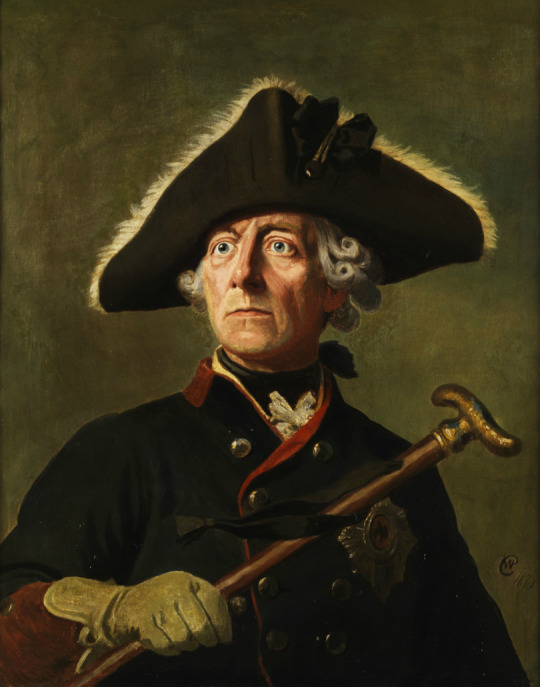

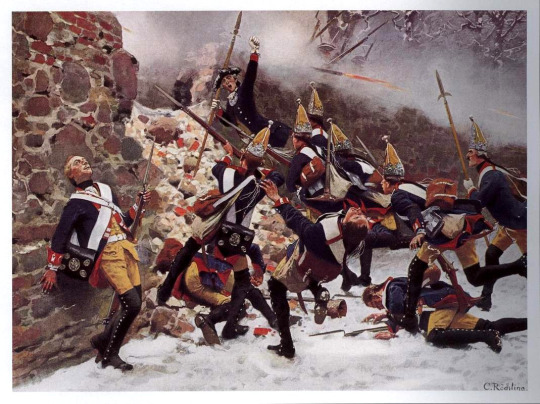

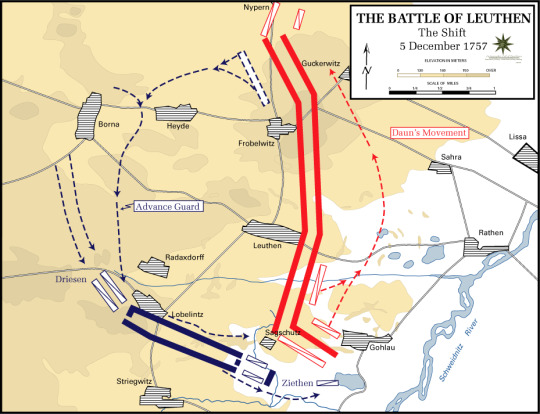


#on this day#military history#Seven Years War#third silesian war#prussia#tactics#oblique order#austria#Frederick the Great#maria theresa#holy roman empire#18th century#military tactics
10 notes
·
View notes
Text
My Top 10 Favourite Horror Films of 2020
Every January, most people who review or talk about movies on YouTube tend to piece together a Top 10 list of their favourite movies from the year prior. In order to stand out from the crowd (and also because I was too lazy to do this sooner), I decided to wait until March, by which time most YouTubers aren’t really talking about movies from 2020 anymore.

I know what you’re thinking: sounds kinda stupid – why would anybody care about a Top 10 list of the best movies of 2020…THREE months into the new year!? Well, as you’ve likely heard, 2020 was a year like no other, and as result of the ongoing global pandemic, movie release dates from 2020 were pushed back months, sometimes multiple times. Some films that were supposed to be released last year didn’t arrive until 2021, even though they’re officially considered “2020 films,” according to their profiles on websites like IMBD and Letterboxd.
And so, some of these so-called “2020 films” were not available (at least to me) until only recently, such as Saint Maud or The Dark and the Wicked. I feel like I’ve now had a chance to see almost all of the horror films I’ve wanted to see from last year. In this video, if you care to stick around, I will share with you my Top 10 favourite horror films of 2020. So, here we go…
#10/ The Dark and the Wicked:
A sister and brother return to the family homestead where their father is slowly dying and their mother is understandably distraught but also disturbed and distant. The siblings soon realize that something evil has invaded their family home as they are terrorized by whatever is slowly killing their father. Directed by the same guy behind 2008’s The Strangers, The Dark and the Wicked is at times bleak and unsettling, and it does a good job at keeping you intrigued in this family’s unnerving conflict. However, it felt a bit rushed and undeveloped at other times, and its ending left me somewhat unsatisfied.
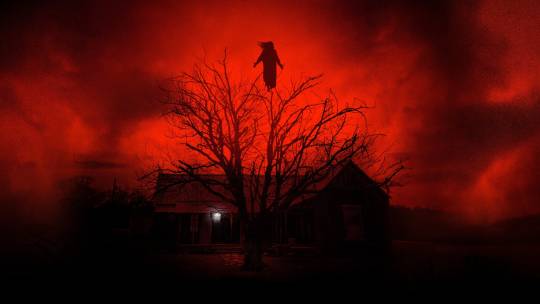
#9/ Relic:
Soon after Kay and her daughter Sam return to their remote family home following the disappearance of the family matriarch, the widowed Edna, they discover that something sinister has taken hold of both Edna and the house itself. Although Relic – which was co-produced by Jake Gyllenhaal and marked the feature directorial debut for Natalie Erika James – isn’t exactly offering up any enticing twists or salacious gore, or even a original concept for that matter, it relies on evoking dread and building tension to compel its audience to stay invested until the bitter end.

#8/ Amulet:
Taking its sweet time to unravel, Amulet is centered around Tomaz, an ex-soldier who is now homeless but is offered a place to stay at a decaying house in London, which is inhabited by a beautiful young woman named Magda and her dying mother. As the story moves along, we see that Tomaz is starting to develop feelings for Magda, who seems a bit…off. His feelings for her don’t wane even after Tomaz discovers that there’s something insidious going on in the attic of the house, where Magda’s mother is seemingly imprisoned. Toss in a suspicious nun and you’ve got yourself a creepy little film that seems to have fallen between the cracks.
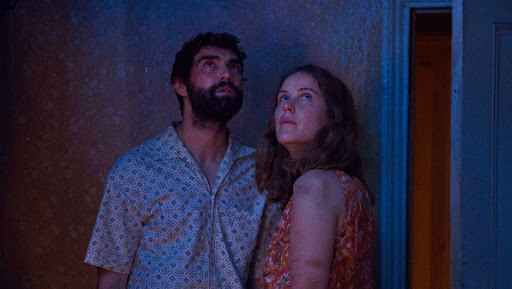
#7/ The Beach House:
One might argue that not a lot actually happens in The Beach House and that the payoff isn’t worth the investment, but if you go into this film with an open mind and zero expectations, you should at least be satisfied. Two troubled college students head to a deserted beach getaway to spend some time together, but end up struggling to survive alongside some unexpected guests as a mysterious infection disrupts their holiday. Although it is a slow build up to the film’s climax, it is a tense and intriguing ride along the way, as a series of unsettling events give way to an apocalyptic episode that feels almost like a throwback to the sci-fi films of the 1950s. Making his feature film directorial debut, Jeffrey A. Brown elicits with The Beach House those brooding existential thoughts that lay dormant in the deep boroughs of our minds.

#6/ The Invisible Man:
There’s always an elevated risk when making a modern film based on an old story that has already been told through cinema numerous times before. The last time H.G. Wells’ 1897 novel The Invisible Man had been adapted by Hollywood was in 2000’s Hollow Man, which was panned by critics despite making a sizeable profit. The 2020 adaptation is far superior and is perhaps the best adaptation of Wells’ classic in any medium. Elizabeth Moss gives a stellar performance that draws real emotion, so that we agonize alongside her as she is essentially haunted by a relentless ghost hellbent on controlling every aspect of her life. We live in an era when technology has advanced enough to bring this 124-year-old story to life like never before, while a polished script and an exceptional lead performance gives The Invisible Man a deeper level of emotion and terror.

#5/ Saint Maud:
For most of Saint Maud it is unclear whether certain experiences are actually happening in reality for the main character or if it’s all simply in her head, as some sort of mental breakdown caused by a work-related tragedy. Maud is a young hospice nurse and a newly-converted Roman Catholic who suddenly becomes obsessed with “saving the soul” of the woman she is currently taking care of, Amanda, a hedonistic dancer with a chronic illness. Maud’s behaviour worsens, as does her mental state, as horrific scenes and visions make us question if she’s actually losing her mind or experiencing something beyond this world. Saint Maud is an A24 feature by the way, so that should be enough to know what you’re getting here in terms of quality.
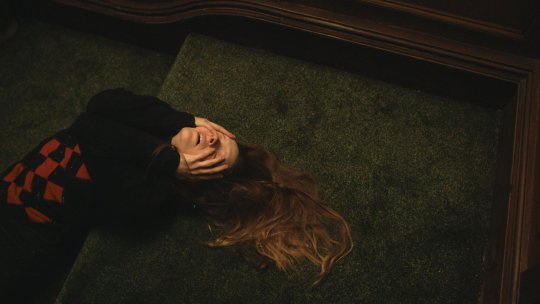
#4/ The Lodge:
Isolation is often embraced as a way to pad a horror film’s fear factor, and it works especially here in The Lodge, as a soon-to-be stepmom becomes stranded at a remote holiday home in the middle of winter with her fiance’s two children. The kids begin to untangle the dark past of their stepmom-to-be and a series of disturbing events transpire as their hope for survival fades. The Lodge is a dreary, atmospheric slow burn that leaves you somewhat unsettled. With its wintry backdrop, stylish sequences, and almost claustrophobic dread, the film doesn’t ever allow its audience to feel at ease for long, insisting that an underlying foreboding remain intact throughout. Although I found the ending somewhat disappointing, I immediately began to concoct a possible prequel that would delve into the backstory of the film’s lead character. One can hope.

#3/ Host:
It’s increasingly difficult to be innovative and original when it comes to horror films these days, especially in the particular genre of so-called “found footage.” Rob Savage’s Host, however, comes off as something different, setting itself apart from most films in this realm in various ways. It centers around six friends who hold a séance via Zoom during a COVID lockdown, guided (at first) by a medium they hired. The séance then takes a dark turn and things soon escalate into madness. Sure, there are elements in Host that are prevalent in numerous horror films, but it uses a modern and topical way to implement them, while also refusing to overstay its welcome by cueing the credits less than an hour in. Overall, this film’s popcorn-and-Saturday-night-movie fun factor is why it ranks so high on this list.

#2/ Possessor:
It’s always a treat to come across an original idea, especially when it’s within the horror realm, and Possessor is certainly unlike anything else I’ve seen in awhile. Andrea Riseborough plays an elite corporate assassin who uses brain-implant technology to take control over other people’s bodies in order to kill high profile targets, though with every mission she gets further and further away from her true self. With her latest possession, she becomes trapped in the mind of a man who threatens to obliterate her for good. It is a provocative vision by director-writer Brandon Cronenberg, who just so happens to be the son of legendary Canadian filmmaker David Cronenberg, and it serves as a disturbing piece of dystopian fiction that is even more frightening because it isn’t too far beyond belief.
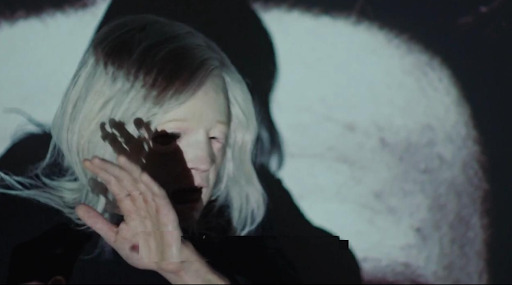
And because everyone else is doing it, here are five honorable mentions that narrowly missed the list:
- The Call
- Color Out of Space
- Don’t Listen
- The Mortuary Collection
- Porno
#1/ His House:
In addition to its emotional storytelling and genuine moments of terror, His House – from first-time director Remi Weekes – sheds a light on the plight of refugees in a way that feels both respectful and empathetic. After a Sudanese couple make a harrowing escape from their war-torn homeland, they are granted asylum in England, where they struggle to adjust and fit in. They are assigned a shabby house on the outskirts of London, where the couple begin to experience terrifying and unexplainable events. His House is built around a fresh concept, two fantastic leads, and some truly haunting imagery, and I wish that more horror directors would put as much effort into quality filmmaking as Weekes did here. If this is his first venture into feature filmmaking, I am excited to see what his future has in store.
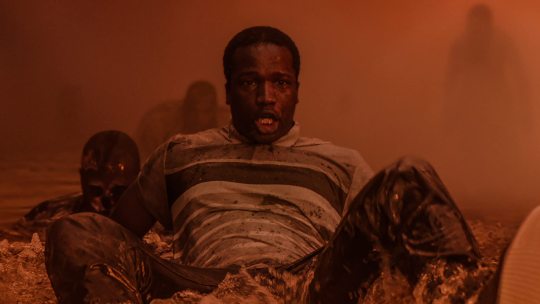
There you have it, my Top 10 favourite horror films of 2020. What did you think and were any of these titles on your own Top 10 list? Please tell me your thoughts and recommendations in the comments below.
youtube
5 notes
·
View notes
Text

Linda Darnell (born Monetta Eloyse Darnell, October 16, 1923 – April 10, 1965) was an American film actress. Darnell progressed from modeling as a child to acting in theater and film. At the encouragement of her mother, she made her first film in 1939, and appeared in supporting roles in big-budget films for 20th Century Fox throughout the 1940s. She rose to fame with co-starring roles opposite Tyrone Power in adventure films, and established a main character career after her role in Forever Amber (1947). She won critical acclaim for her work in Unfaithfully Yours (1948) and A Letter to Three Wives (1949).
Darnell was born in Dallas, Texas, as one of four children (excluding her mother's two children from an earlier marriage) to postal clerk Calvin Roy Darnell (1888–1977) and the former Margaret "Pearl" Brown (1892–1966). She was the younger sister of Undeen (b. 1918) and the older sister of Monte Maloya (b. 1929) and Calvin Roy, Jr. (b. 1930). Her parents were not happily married, and she grew up as a shy and reserved girl in a house of domestic turmoil. Starting at an early age, her mother, Pearl, had big plans for Darnell in the entertainment industry. She believed that Linda was her only child with potential as an actress and ignored the rearing of her other children.
According to her siblings, Darnell enjoyed the limelight and shared her mother's dream.[1]:19 Darnell once said: "Mother really shoved me along, spotting me in one contest after another. I had no great talent, and I didn't want to be a movie star particularly. But Mother had always wanted it for herself, and I guess she attained it through me." One elocution teacher recalled: "[Darnell] didn't stand out particularly, except that she was so sweet and considerate. In her theater work, she wasn't outstanding, but her mother was right behind her everywhere she went."
Unlike her husband, Pearl had a notorious reputation in the neighborhood of being "aggressive" or "downright mean". Despite some financial problems, Darnell insisted that she had had a joyful childhood and loving parents. Darnell was a model by the age of 11 and was acting on the stage by the age of 13. She initially started modeling to earn money for the household and performed mostly in beauty contests.
Before leaving school for Hollywood, Darnell was a student at Sunset High School, which she entered in September 1937, majoring in Spanish and art. She did not have a lot in common with her peers and usually spent her time at home as a teen, working under the guidance of her mother. In 1936, she entered the Dallas Little Theater and was cast in the southwestern premiere of Murder in the Cathedral. The same year, she was hired as one of the hostesses at the Texas Centennial Exposition.
In November 1937, a talent scout for 20th Century Fox arrived in Dallas looking for new faces. Encouraged by her mother, Darnell met him, and after a few months he invited her for a screen test in Hollywood. Arriving in California alongside Mary Healy and Dorris Bowdon in February 1938, Darnell initially was rejected by film studios and was sent home because she was declared "too young".
Although originally wanting to become an actress on the stage, Darnell was featured in a Gateway to Hollywood talent search and initially landed a contract at RKO Pictures. There was no certainty, though, and she soon returned to Dallas. When 20th Century-Fox offered her a part, Darnell wanted to accept, but RKO was unwilling to release her. Nevertheless, by age 15 she was signed to a contract at 20th Century-Fox and moved to a small apartment in Hollywood all alone on April 5, 1939. With production beginning in April 1939, she was featured in her first film, Hotel for Women (1939), which had newspapers immediately hailing her as the newest star of Hollywood. Loretta Young was originally assigned to play the role, but she demanded a salary which the studio would not give her. Darryl F. Zanuck instead cast Darnell "because he felt that the name would advertise her beauty and suggest a Latin quality that matched her coloring."
Although only 15 at the time, Darnell posed as a 17-year-old and was listed as 19 years old by the studio. According to columnist Louella O. Parsons, Darnell was "so young, so immature and so naive in her ideas" and was very loyal to her boss, Darryl F. Zanuck. Her true age came out later in 1939, and she became one of the few actresses under the age of 16 to serve as leading ladies in films. While working on Hotel for Women, Darnell was cast alongside Henry Fonda and Claudette Colbert in Drums Along the Mohawk (1939) in June 1939. She was later replaced because the studio felt her role was not important enough. In an interview during production of Hotel for Women, which lasted until June, Darnell admitted that movie making was not what she expected: "I'm learning what really hard work is. At home in Dallas I used to sprawl on the lawn and dream about the nice, easy time the screen stars must be having in Hollywood, but the last two months have taught me quite another story."
Since the beginning of her career at 20th Century-Fox, Darnell had been very positive about her frequent co-star Tyrone Power. In a 1939 interview, she expressed her interest in starring opposite Power in Johnny Apollo (1940). Rationalizing why she was not cast, Darnell said: "It's a man's part and the girl's role is only incidental." Dorothy Lamour was cast, instead. Nevertheless, Darnell had her way, as she was assigned to the female lead opposite Power in the light romantic comedy Day-Time Wife (1939). Although the film received only slightly favorable reviews, Darnell's performance was received positively, with one critic saying: "Despite her apparent youth, [Darnell] turns in an outstanding performance when playing with popular players." Another critic wrote: "little Linda is not only a breath-taking eyeful, but a splendid actress, as well." Life magazine stated that Darnell appeared to be 22 and was "the most physically perfect girl in Hollywood". Following the film's release, she was cast in the drama comedy Star Dust in December 1939. The film was hailed as one of the "most original entertainment ideas in years" and boosted Darnell's popularity, who was nicknamed "Hollywood's loveliest and most exciting star". Variety said: "Miss Darnell displays a wealth of youthful charm and personality that confirms studio efforts to build her to a draw personality." Her studio contract had been revised to allow Darnell to earn $200 a week.
At first, everything was like a fairy tale coming true. I stepped into a fabulous land where, overnight, I was a movie star. In pictures you're built up by everyone. On the set, in the publicity office, wherever you go, everyone says you're wonderful. It gives you a false sense of security. You waltz through a role, and everywhere you hear that you are beautiful and lovely, a natural-born actress. You believe what people around you say.
After appearing in several small films, Darnell was cast in her first big-budget film in May 1940, appearing again opposite Tyrone Power in Brigham Young (1940), which was shot on location in mid 1940 and was regarded as the most expensive film 20th Century Fox had yet produced. Darnell and Power were cast together for the second time owing to the box office success of Day-Time Wife, and they became a highly publicized onscreen couple, which prompted Darryl F. Zanuck to add 18 more romantic scenes to Brigham Young.[13] The film's director, Henry Hathaway, in later life had only slight memories of Darnell but recalled that "a sweeter girl never lived." By June 1940, shortly after completing Brigham Young, Darnell achieved stardom and earned "a weekly salary larger than most bank officials."
In the summer of 1940, Darnell began working on The Mark of Zorro (1940), in which she again co-starred as Power's sweetheart in a role for which Anne Baxter was previously considered. A big-budget adventure film that was raved over by the critics, The Mark of Zorro was a box office sensation and did much to enhance Darnell's star status. Afterwards, she was paired with Henry Fonda for the first time in the western Chad Hanna (1940), her first Technicolor film. The film received only little attention, unlike Darnell's next film, Blood and Sand (1941), which was shot on location in Mexico and in which she was reteamed with Power. It was the first film for which she was widely critically acclaimed. Nevertheless, Darnell later claimed that her downfall began after Blood and Sand. In an interview she said:
People got tired of seeing the sweet young things I was playing and I landed at the bottom of the roller coaster. The change and realization were very subtle. I'd had the fame and money every girl dreams about—and the romance. I'd crammed thirty years into ten, and while it was exciting and I would do it over again, I still know I missed out on my girlhood, the fun, little things that now seem important.
The studio was unable to find Darnell suitable roles. In late 1940, Fox chose her for the main role in Song of the Islands (1942), a Hawaiian musical film which eventually starred Betty Grable. After Blood and Sand, she was set to co-star with Claudette Colbert in Remember the Day (1941), but another actress was eventually cast. Meanwhile, she was considered for the female lead in Swamp Water (1941), but Anne Baxter was later assigned the role. Darnell was disappointed and felt rejected; she later said: "Right under your very nose someone else is brought in for that prize part you wanted so terribly." Months passed by without any work, and in August 1941 she was cast in a supporting role in the musical Rise and Shine (1941). The film was a setback in her career, and she was rejected for a later role because she refused to respond to Darryl F. Zanuck's advances. Instead, she contributed to the war effort, working for the Red Cross and selling war bonds. She was also a regular at the Hollywood Canteen.
In early 1942, Darnell filmed The Loves of Edgar Allan Poe, another film that would not do much to improve her career. Meanwhile, she realized that Darryl F. Zanuck had lost interest in her, and she was overlooked for most film roles that suited her. Instead, she was cast in roles that she loathed, including the musical Orchestra Wives (1942). Zanuck insisted that she take the role, but she was replaced by Ann Rutherford after 12 days of shooting. The press reported that "Linda Darnell and Twentieth Century-Fox aren't on the best of terms at the moment." As a punishment, she was loaned out to another studio for a supporting role in a B movie called City Without Men. According to co-star Rosemary DeCamp, Darnell nevertheless was "very polite", and she was satisfied to work at a studio which did not treat her as a child. In April 1943, she was put on suspension, which meant being replaced in the Technicolor musical film The Gang's All Here (1943). By this time, Darnell had eloped, which caused Zanuck to be even more furious.
In 1943, she was cast, uncredited, as the Virgin Mary in The Song of Bernadette. By late 1943, Darnell was fed up with critics only praising her beauty rather than her acting abilities. Judging her performance in Sweet and Low-Down (1944), in which she co-starred with Lynn Bari, one critic of the Los Angeles Examiner wrote, "Lynn comes off the best because she has more of a chance to shine. Linda just doesn't have enough to do—but looks beautiful doing it." Darnell was reduced to second leads and was overlooked for big-budget productions. Matters changed when she was named one of the four most beautiful women in Hollywood along with Hedy Lamarr, Ingrid Bergman, and Gene Tierney in a 1944 edition of Look. Afterwards, the studio allowed her to be loaned out for the lead in Summer Storm. Portraying a "seductive peasant girl who takes three men to their ruin before she herself is murdered," it was a type of role she had never before played. In a later interview, Darnell commented:
I was told that such a violent change of type might ruin my career, but I insisted on taking the chance. This is one picture on which I am setting much store for the future. For eighteen months I did nothing in pictures. I pleaded for something to do, but nothing happened. The character in the Chekhov film is a wild sort of she-devil, which any actress would go miles to play. She's devil mostly—at times angelic—and perfectly fascinating to interpret. I'm counting on my Russian girl to give me a new start.
Released in 1944, the film provided her a new screen image as a pin-up girl. Shortly after, Darnell was again loaned out to portray a showgirl in The Great John L., the first film to feature her bare legs. Darnell complained that the studio lacked recognition of her, which prodded Zanuck to cast her in Hangover Square (1945), wherein she played a role she personally had chosen. The film became a great success, and with Darnell's triumph assured, she was allowed to abandon her upcoming film, Don Juan Quilligan (1945), which would have been another low point in her career. In January 1945, she was added to the cast of the film noir Fallen Angel (1945), which also included Dana Andrews and Alice Faye. Despite suffering from the "terrifying" director Otto Preminger, Darnell completed the film and was praised by reviewers so widely that there was even talk of an Oscar nomination. Because of her success in Fallen Angel, she was cast opposite Tyrone Power in Captain from Castile in December 1945 on the insistence of Joseph L. Mankiewicz. Although she looked forward to the film project, believing it would be her most important to date, she was later replaced by newcomer Jean Peters owing to scheduling conflicts, a decision she resented.
In 1946, Darnell filmed two pictures simultaneously, the expensively budgeted Anna and the King of Siam and Preminger's Centennial Summer. During the release of the latter, she was on location in Monument Valley for the filming of the classic Western My Darling Clementine (1946), playing a role for which she lost 12 pounds. She was assigned to a negligible role by Zanuck, which displeased the film's director, John Ford, who felt that she was not suitable.
In 1946, Darnell won the starring role in the highly anticipated movie Forever Amber, based on a bestselling historical novel that was denounced as being immoral at that time. The character Amber was so named because of her hair color, and this is the only major film in which Darnell—normally known for her raven hair and somewhat Latin looks—appears as a redhead. It was the most expensive film yet produced by Fox, and publicity at the time compared the novel to Gone with the Wind. Darnell replaced British actress Peggy Cummins in July 1946 at a cost of $350,000. Because $1 million had already been spent on production costs when Darnell was brought in, the pressure was intense to make the film a financial success. Her casting was a result of a campaign for stronger roles. Regardless, she was surprised to find out that she had been cast, because she had been intensively rehearsing for Captain from Castile at the time. Although she had to give up that role and work with Otto Preminger, she was delighted to play the title role and thought she was "the luckiest girl in Hollywood."
The search for the actress to portray Amber, a beauty who uses men to make her fortune in 17th century England, was modeled on the extensive process that led to the casting of Vivien Leigh as Scarlett O'Hara. Production demanded a lot from Darnell. She was again put on a diet and was assigned to a voice coach to learn how to speak with an English accent. In addition, she spent hours in fittings for costume changes. Darnell was certain that Forever Amber would be her ticket to stardom, and she told reporters:
My first seven years in Hollywood were a series of discouraging struggles for me. For a while it looked as though the Darnell-versus-Hollywood tussle was going to find Darnell coming out second best. The next seven years aren't going to be the same.
Darnell worked long hours at the studio during filming, and according to her older sister she started loathing Preminger, which did not ease production. This and the heavy dieting resulted in exhaustion and a serious illness in November 1946.[1]:100 Her shooting schedule lasted until March 1947, and she collapsed on the set twice. Forever Amber did not live up to its hype, and although it became a success at the box office, most reviewers agreed that the film was a disappointment. Darnell was disappointed in the film's reception; it did not gain her the recognition for which she longed.
The following year, Darnell portrayed Daphne de Carter in the Preston Sturges' comedy Unfaithfully Yours (1948), also starring Rex Harrison, and was then rushed into production as one of the three wives in the comedy/drama A Letter to Three Wives (1949). Darnell's hard-edged performance in the latter won her unanimous acclaim and the best reviews of her career. Darnell became one of the most in-demand actresses in Hollywood, and she now had the freedom to select her own roles. She longed for the leading role in the controversial film Pinky (1949), but Zanuck feared that her character would be compared to Amber by the audience, and A Letter to Three Wives co-star Jeanne Crain was cast instead.
Darnell had been widely expected to win an Academy Award nomination for A Letter to Three Wives; when this did not happen, her career began to wane. She was cast opposite Richard Widmark and Veronica Lake in Slattery's Hurricane (1949), which she perceived as a step down from the level she had reached with A Letter to Three Wives, though it did well at the box office.
Aside from her co-starring role opposite Richard Widmark, Stephen McNally and Sidney Poitier in the groundbreaking No Way Out (1950), directed by Joseph L. Mankiewicz, which she later called "the only good picture [she] ever made," her later films were rarely noteworthy, and her appearances were increasingly sporadic. Further hampering Darnell's career was the actress's alcoholism and weight gain. Her next film was a Western, Two Flags West (1950). Due to her allergy to horses, she loathed making Westerns, and in addition to her complaints about her "colorless" role, she disliked her co-stars Joseph Cotten and Cornel Wilde. She was even less enthusiastic about her next film, The 13th Letter (1951), which reunited her with Preminger, and she only took the role because it was an unglamorous one. Shortly after its release, she was put on suspension for refusing a role in the film The Guy Who Came Back (1951) opposite Paul Douglas and Joan Bennett because it felt "too similar." She later consented to take on the glamor role, but she refused to bleach her hair for it.
On March 21, 1951, Darnell signed a new contract with 20th Century Fox that allowed her to become a freelance actress. Her first film outside 20th Century-Fox was The Lady Pays Off for Universal Pictures (1951) after Douglas Sirk requested her for the lead role. She was responsible for putting the film behind schedule because on the fifth day of shooting she learned that Ivan Kahn, the man responsible for her breakthrough, had died. After The Lady Pays Off, Darnell headed the cast of Saturday Island (1952), which was filmed on location in Jamaica in late 1951. There, Darnell fell ill and had to be quarantined for several weeks. Because her contract required her to make one film a year for the studio, she reported to the 20th Century-Fox lot in March 1952 and was cast in the film noir Night Without Sleep (1952). It was the only time that she had to live up to this part of her contract, though, since she was released from it in September 1952, most likely because the competition of television forced studios all over Hollywood to drop actors.
This news initially excited Darnell because it permitted her to focus on her film career in Europe. She soon realized, though, that the ease and protection enjoyed under contract was gone, and she came to resent 20th Century-Fox and Zanuck:
Suppose you'd been earning $4,000 to $5,000 a week for years. Suddenly you were fired and no one would hire you at any figure remotely comparable to your previous salary. I thought in a little while I'd get offers from other studios, but not many came along. The only thing I knew how to do was be a movie star. No one expects to last forever in this business. You know that sooner or later the studio's going to let you go. But who wants to be retired at twenty-nine?
Before traveling to Italy for a two-picture deal with Giuseppe Amato, Darnell was rushed into the production of Blackbeard the Pirate (1952), which—much to Darnell's distress—got far behind schedule. She arrived in Italy in August 1952 and started filming Angels of Darkness (1954) in February of the next year. The second collaboration proved disastrous, and the next film was never released in the United States. Owing to a delay in the middle of production, she was sent back to Hollywood and there accepted an offer from Howard Hughes to star in RKO's 3-D film Second Chance (1953), filmed in Mexico. Afterwards, she flew back to Rome to complete Angels of Darkness, in which she spoke Italian. Upon returning to New York, she was under the misunderstanding that she would portray the title role in Mankiewicz's The Barefoot Contessa (1954), believing that the role could carry her to dramatic heights.[1]:138 Through trade papers, she learned that Ava Gardner assumed the part.
Because of her then-husband, Philip Liebmann (grandson of Charles Liebmann of Rheingold Breweries), Darnell put her career on hiatus. She returned to 20th Century-Fox in August 1955, by which time the studio had entered the television field. Darnell was eager to appear on Ronald W. Reagan's General Electric Theater. In 1958, Darnell appeared in the episode "Kid on a Calico Horse" of NBC's Cimarron City along with a cast of other guest stars, including Edgar Buchanan. That same year, she held the guest-starring title role in "The Dora Gray Story" on NBC's Wagon Train. The character of Dora is an attractive young woman trying to reach San Francisco who has inadvertently joined with a gun runner, played by John Carradine, to reach the west. Robert Horton carries the cast lead in the segment, and Mike Connors appears as Miles Borden, Dora's erstwhile love interest, a corrupt United States Army lieutenant bitter over his meager pay of $54 per month. Dan Blocker, more than a year before Bonanza, also guests in this segment.
In addition to television, Darnell returned to the stage. Her last work as an actress was in a stage production in Atlanta in early 1965. (At the time of her death a few months later, she was preparing to perform in another play.)
Since Darnell was underage when she arrived in Hollywood, she was tutored on the sets. She planned on attending graduation ceremonies at Sunset High School, but she was excluded from them and instead graduated from University High School in 1941. Her work schedules prohibited her from enrolling in a university.
In 1940, during the shooting of Star Dust, Darnell for a short time went out with teen idol Mickey Rooney. Her first love was Jaime Jorba, a Mexican whom she met while still in high school. They met again during production of Blood and Sand, but they drifted apart when Jorba announced he could not marry a girl who was in the public eye. Starting at age 17, Darnell dated her publicity agent, Alan Gordon, whom she allegedly married in a double wedding with Lana Turner and Joseph Stephen Crane on July 17, 1942. The report turned out to be false, and over the years Darnell became known as "filmland's most eligible bachelorette." Up to 1942, she dated Kay Kyser, Eddie Albert, George Montgomery, and Jackie Cooper, among others. At one point, she was set to elope with talent agent Vic Orsatti, only to report later that she was "concentrating on her career."
Although a well-loved figure on the 20th Century-Fox lot among the cast, crew, and lot workers, it was reported that Darnell made only one good friend in Hollywood, actress-singer Ann Miller, whom she met at a Catalina Island benefit. Darnell was very negative about the Hollywood social scene, finding it "nauseating". During her stay in Hollywood, her relationship with her mother, Pearl, worsened, as her mother was an unpopular figure on the lot because of her overbearing and possessive behavior. In 1940, Pearl accused her husband of having an incestuous relationship with Evelyn, one of her children, though he was not Evelyn's biological father. Following an intense fight between her parents in 1942, Darnell left home with her younger sister Monte and never returned. Out of spite, Pearl turned to the press, which gained Darnell some bad publicity.
In 1942, Darnell was plagued with extortion letters from an unknown person threatening her with bodily harm unless $2,000 was paid immediately. The studio asked the FBI to protect the actress, and eventually a 17-year-old high school student was arrested for the crime.
On April 18, 1943, at age 19, Darnell eloped with 42-year-old cameraman Peverell Marley in Las Vegas. Darnell and Marley started seeing each other in 1940, and the press dismissed him as her "devoted friend and escort." Most friends and relatives, including her parents, and 20th Century-Fox disapproved of the marriage, and Darnell was believed to look at Marley more as a father figure than as a romantic interest. Marley was a heavy drinker and introduced Darnell to alcohol in 1944, which eventually led to an addiction and weight problems. Neighbors and acquaintances recalled the drastic change she underwent in this period, becoming hardened and hot- tempered. In 1946, during production of Centennial Summer, she repeatedly met with Howard Hughes. Although she initially disregarded gossip of an affair, she fell in love with the womanizing millionaire and separated from Marley shortly after finishing My Darling Clementine. When Hughes announced that he had no desire to marry her, Darnell returned to her husband and cancelled divorce proceedings. Shortly after the reunion, her health worsened, caused by the tough production of Forever Amber (1947).
Because Darnell and Marley were unable to have children, they adopted a daughter in 1948, Charlotte Mildred "Lola" Marley (born January 5, 1948), the actress's only child. She also planned to adopt a boy within a few years, but nothing ever came of it. In mid 1948, she became romantically involved with Joseph L. Mankiewicz, the director of A Letter to Three Wives, and in July 1948 she filed for divorce. Mankiewicz, however, was unwilling to leave his wife for Darnell, and though the affair continued for six years, she returned to her husband. Though she called him the "great love of her life," Mankiewicz never acknowledged the affair; he only mentioned her to his biographer as a "marvelous girl with very terrifying personal problems." In 1949, Darnell went into psychotherapy for hostile emotions that she had been building since childhood. Darnell's romance with Mankiewicz influenced her personal life. When he left in late 1949 for on-location shooting of All About Eve (1950), Darnell fell into a depression and almost committed suicide. She continued to meet with him occasionally until production of The Barefoot Contessa (1954) started.
On January 25, 1949, Darnell went to court to sue her former business manager, Cy Tanner, for fraud. She testified that he stole $7,250 from her between 1946 and 1947, and Tanner was eventually sent to prison. On July 19, 1950, Darnell reportedly separated from her husband. Marley offered a quiet settlement—without mention of Mankiewicz—for a payment of $125,000. She agreed and lost almost all her money. When she filed for divorce from Marley she accused her husband of cruelty, claiming he was "rude" and "critical" towards Darnell and her family. Following a five-minute hearing, Darnell was granted a divorce and custody of Charlotte, while Marley was to pay $75 a month for child support.
At thirty-two, I can see tell-tale marks in the mirror, but the ravages of time no longer terrify me. I am told that when surface beauty is gone, the real woman emerges. My only regret will be that I could not have begun it earlier - that so many years have been ruined because I was considered beautiful.
— Darnell shortly after her divorce from Liebmann.
In her later life, she dated actor Dick Paxton and had an affair with Italian director Giuseppe Amato. She married brewery heir Philip Liebmann in February 1954. owing to her lack of interest in him physically, it was agreed that the marriage would be a business arrangement: she was to be his wife in name only and in return he would support her financially. After a while, she grew dissatisfied with this loveless marriage and detested her husband for allowing her to lash out at him as well as cheapening her by buying her lavish presents. In response, Darnell resorted to charity work, opening facilities accommodating 30 girls in the neighborhood of Rome in 1955. Liebmann attempted to save the marriage by adopting a baby named Alfreda, but the marriage ended nevertheless on grounds of incompatibility, and Liebmann kept the girl.
Darnell was married to pilot Merle Roy Robertson from 1957 to 1963. In 1957, she started drinking heavily and in November 1958 sank into a depression, but went into rehab, recovering for a while. In 1963, Darnell was granted a divorce from Robertson following an outburst in the courtroom, where she accused her third husband of fathering the baby of a Polish actress. She was promised alimony of $350 monthly until July 15, 1964, and then $250 until September 15, 1967.
Darnell died on April 10, 1965, from burns she received in a house fire in Glenview, Illinois, early the day before. She had been staying at the home of her former secretary and her daughter and had just received notice from her agent of three possible movie contracts. She was trapped on the second floor of the home by heat and smoke, as the fire had started in the living room.
The women urged the young girl to jump from the second-floor window. After her daughter jumped, Darnell's secretary stood on the window ledge, calling for help. She had lost track of Darnell and insisted the firefighters rescue her before she was taken from the window ledge. Darnell was found next to the burning living-room sofa and was transferred to the burn unit at Chicago's Cook County Hospital with burns over 80% of her body.
After her death, a man who said he was Darnell's fiancé identified her body. A coroner's inquest into her death ruled that Darnell's death was accidental and that the fire had begun in or near the living-room sofa and was caused by careless smoking; both adult women were smokers.
Darnell's body was cremated; she had wanted her ashes scattered over a ranch in New Mexico, but because of a dispute with the landowners that was not done. After the remains had been in storage for ten years, her daughter asked that they be interred at the Union Hill Cemetery, Chester County, Pennsylvania, in the family plot of her son-in-law.
4 notes
·
View notes
Text
Augustine Tolton

Augustus Tolton (April 1, 1854 – July 9, 1897), baptized Augustine Tolton, was the first Roman Catholic priest in the United States publicly known to be black when he was ordained in 1886. (James Augustine Healy, ordained in 1854, and Patrick Francis Healy, ordained in 1864, were of mixed-race.) A former slave who was baptized and reared Catholic, Tolton studied formally in Rome.
He was ordained in Rome on Easter Sunday of 1886 at the Archbasilica of St. John Lateran. Assigned to the diocese of Alton (now the Diocese of Springfield), Tolton first ministered to his home parish in Quincy, Illinois. Later assigned to Chicago, Tolton led the development and construction of St. Monica's Catholic Church as a black "national parish church", completed in 1893 at 36th and Dearborn Streets on Chicago's South Side.
Biography
Early life
Augustus Tolton was born in Missouri to Peter Paul Tolton and his wife Martha Jane Chisley, who were enslaved. His mother, who was reared Catholic, named him after an uncle named Augustus. He was baptized Augustine in St. Peter's Catholic Church near Rensselaer, Missouri, a community in northeast Missouri. His master was Stephen Elliott. Savilla Elliot, his master's wife, stood as Tolton's godmother.
Freedom
How the members of the Tolton family gained their freedom remains a subject of debate. According to accounts Tolton told friends and parishioners, his father escaped first and joined the Union Army. Tolton's mother then ran away with her children Samuel, Charley, Augustine, and Anne. With the assistance of sympathetic Union soldiers and police, she crossed the Mississippi River and into the Free State of Illinois. According to descendants of the Elliott family, though, Stephen Elliott freed all his slaves at the outbreak of the American Civil War and allowed them to move North. Augustine's father died of dysentery before the war ended.
Vocation
After arriving in Quincy, Illinois, Martha, Augustus, and Charley began working at the Herris Tobacco Company where they made cigars. After Charley's death at a young age, Augustine met Peter McGirr, an Irish immigrant priest from Fintona, County Tyrone, who gave him the opportunity to attend St. Peter's parochial school during the winter months, when the factory was closed. The priest's decision was controversial in the parish. Although abolitionists were active in the town, many of McGirr's parishioners objected to a black student at their children's school. McGirr held fast and allowed Tolton to study there. Later, Tolton continued studies directly with some priests.
Despite McGirr's support, Tolton was rejected by every American seminary to which he applied. Impressed by his personal qualities, McGirr continued to help him and enabled Tolton's study in Rome. Tolton graduated from St. Francis Solanus College (now Quincy University) and attended the Pontifical Urbaniana University, where he became fluent in Italian language as well as studying Latin and Greek.
Priesthood
Tolton was ordained to the priesthood in Rome in 1886 at age 31. His first public Mass was in St. Peter's Basilica on Easter Sunday in 1886. Expecting to serve in an African mission, he had been studying its regional cultures and languages. Instead, he was directed to return to the United States to serve the black community.
Tolton celebrated his first Mass in the United States at St. Boniface church in Quincy. He attempted to organize a parish there, but over the years met with resistance from both white Catholics (many of whom were ethnic German) and Protestant blacks, who did not want him trying to attract people to another denomination. He organized St. Joseph Catholic Church and school in Quincy, but ran into opposition from the new dean of the parish, who wanted him to turn away white worshipers from his services.
After reassignment to Chicago, Tolton led a mission society, St. Augustine's, which met in the basement of St. Mary's Church. He led the development and administration of the Negro "national parish" of St. Monica's Catholic Church, built at 36th and Dearborn Streets on the South Side, Chicago. The church nave seated 850 parishioners and was built with money from philanthropists Mrs. Anne O'Neill and Katharine Drexel.
St. Monica's Parish grew from 30 parishioners to 600 with the construction of the new church building. Tolton's success at ministering to black Catholics quickly earned him national attention within the Catholic hierarchy. "Good Father Gus", as he was called by many, was known for his "eloquent sermons, his beautiful singing voice, and his talent for playing the accordion."
Several contemporaneous news articles describe his personal qualities and importance. An 1893 article in the Lewiston Daily Sun, written while he worked to establish St. Monica's for African American Catholics in Chicago, said, "Father Tolton ... is a fluent and graceful talker and has a singing voice of exceptional sweetness, which shows to good advantage in the chants of the high mass. It is no unusual thing for many white people to be seen among his congregation." The True Witness and Catholic Chronicle in 1894 described him as "indefatigable" in his efforts to establish the new parish. Daniel Rudd, who organized the initial National Black Catholic Conference which was held in 1889, was quoted in the November 8, 1888, edition of The Irish Canadian as commenting about the Congress by saying, "For a long time the idea prevailed that the negro was not wanted beyond the altar rail, and for that reason, no doubt, hundreds of young colored men who would otherwise be officiating at the altar rail today have entered other walks. Now that this mistaken idea has been dispelled by the advent of one full-blooded negro priest, the Rev. Augustus Tolton, many more have entered the seminaries in this country and Europe". Another indication of the prominence given Tolton by parts of the American Catholic hierarchy was his participation, a few months later, on the altar at an international celebration of the centenary of the establishment of the first U.S. Catholic diocese in Baltimore. Writing about it in the New York Times edition of November 11, 1889, the correspondent noted that "As Cardinal Gibbons retired to his dais [on the altar at the Mass], the reporters in the improvised press gallery noticed for the first time, not six feet away from him in the sanctuary among the abbots and other special dignitaries, the black face of Father Tolton of Chicago, the first colored Catholic priest ordained in America."
Death
Tolton began to be plagued by "spells of illness" in 1893. Because of them, he was forced to take a temporary leave of absence from his duties at St. Monica's Parish in 1895.
At the age of 43, on July 8, 1897, he collapsed and died the following day at Mercy Hospital as a result of the heat wave in Chicago in 1897. After a funeral which included 100 priests, Tolton was buried in the priests' lot in St. Peter's Cemetery in Quincy, which had been his expressed wish.
After Tolton's death, St. Monica's was made a mission of St. Elizabeth's Church. In 1924 it was closed as a national parish, as black Catholics chose to attend parish churches in their own neighborhoods.
Legacy and honors
Tolton is the subject of the 1973 biography From Slave to Priest by Sister Caroline Hemesath. The book was reissued by Ignatius Press in 2006.
In 1990, Sister Jamie T. Phelps, O.P., an Adrian Dominican Sister and then-faculty member of the Theology Department at Catholic Theological Union, initiated the Augustus Tolton Pastoral Ministry Program in consultation with Don Senior, President of CTU, the theology faculty, and representatives of the Archdiocese of Chicago, to prepare, educate, and form black Catholic laity for ministerial leadership in the Archdiocese of Chicago.
The Father Tolton Regional Catholic High School opened in Columbia, Missouri, in 2011.
Augustus Tolton Catholic Academy opened in the fall of 2015 in Chicago, Illinois. Tolton Academy is the first STREAM school in the Archdiocese of Chicago. A focus on science, technology, religion, engineering, arts, and math sets it apart as a premier elementary school in Chicago. Tolton Academy is located at St. Columbanus Church.
Cause for canonization
On March 2, 2010, Francis George of Chicago announced that he was beginning an official investigation into Tolton's life and virtues with a view to opening the cause for his canonization. This cause for sainthood is also being advanced by the Diocese of Springfield, Illinois, where Tolton first served as priest, as well as the Diocese of Jefferson City, Missouri, where his family was enslaved.
On February 24, 2011, the Roman Catholic Church officially began the formal introduction of the cause for Tolton's sainthood, which must take place in a public session. He is now designated Servant of God Fr. Augustus Tolton. Also at this time there was the establishment of historical and theological commissions, which will investigate the life of Tolton, and the Father Tolton Guild, which is responsible for the promotion of his cause through spiritual and financial endeavors. George assigned Joseph Perry, Auxiliary Bishop of Chicago, to be the Diocesan Postulator for the cause of Tolton's canonization.
On September 29, 2014, George formally closed the investigation into the life and virtues of Tolton. The dossier of research into Tolton's life went to the Vatican, where the documents collected to support his cause will be analyzed, bound into a book called a "positio" or official position paper, and evaluated by theologians, and then, supporters hope, passed on to the pope, who can declare Tolton "venerable" if he determines Tolton led a life of heroic virtue.
On December 10, 2016, Tolton's remains were exhumed and verified as part of the canonization process. Following procedures laid out in canon law, a forensic pathologist verified that the remains (which included a skull, femurs, ribs, vertebrae, pelvis, and portions of arm bones) belong to Tolton. Also found were the corpus from a crucifix, part of a Roman collar, the corpus from Tolton's rosary, and glass shards indicating his coffin had a glass top. After verification, the remains were dressed in a new chasuble and reburied.
On March 8, 2018, historians that consult the Congregation for the Causes of Saints unanimously issued their assent to Tolton's cause after having received and favourably reviewed the positio that was presented to them. On February 5, 2019, the nine-member theological commission unanimously voted to approve the cause. It must now go to the cardinal and bishop members of the Congregation for approval before it is passed to the pope for his final confirmation.
On June 12, 2019, Pope Francis authorized the promulgation of a "Decree of Heroic Virtue", advancing the cause of Servant of God Augustine Tolton. With the promulgation of the decree of heroic virtue, Tolton was granted the title “Venerable”. If the case progresses, the next stage would be beatification, followed by canonization.
5 notes
·
View notes
Text
Oil and Water: An Obito Uchiha Character Analysis
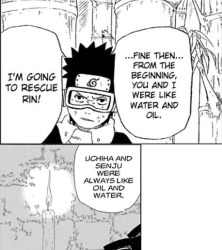
The following are my scattered thoughts on the layout and progression of Obito Uchiha's character.
I’ve previously posted this a while back on a forum like a year ago but found that I wanted to share with a wider audience, if I should be so fortunate.
With that out of the way, here we go. And warning, it’s quite long.
----------------------------------------------------------------------------------------
The first lesson Team 7 had to learn as shinobi was teamwork. They initially all fought for their own self-interests, which prompted Kakashi to tell them about the memorial stone.
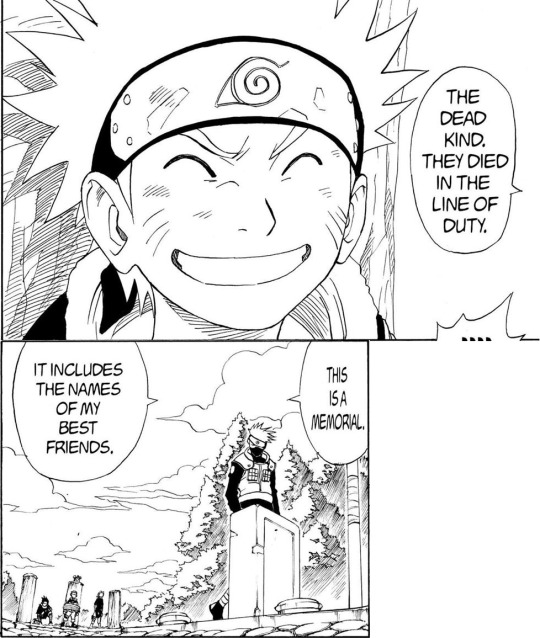
Later, once Sasuke and Sakura sacrifice their food for Naruto, Kakashi unexpectedly passes them and reveals to them his philosophy in life.
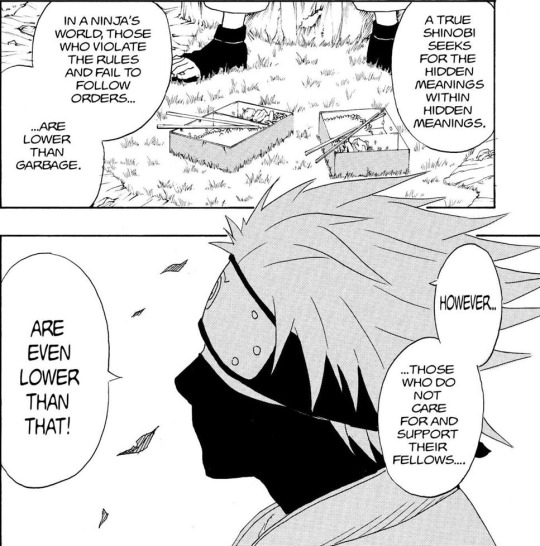
His mystery is further compounded with the reveal of his Sharingan, as well. Kakashi is built up as a man of mystery throughout Part I, and after the Third Hokage's death he is shown mourning at the grave of someone called Obito in a very somber scene.

(Note that the chapter in which Obito's name is first mentioned is the chapter in which Akatsuki first shows up. Likely coincidence, but interesting nonetheless)
So, tons of shit happens, and the darkness in Sasuke grows. He eventually abandons Konoha to join Orochimaru. The cast is left crestfallen after his betrayal, with Naruto promising to bring him back no matter what. The chapter in which this resolution occurs, releasing shortly before Kakashi Gaiden, starts off with this:
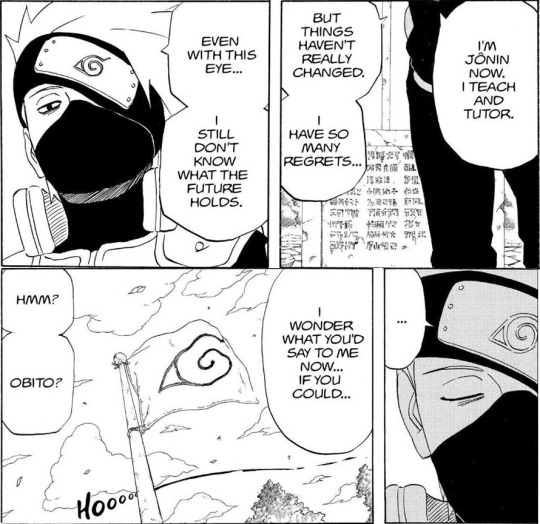
The remaining pages revolve around Naruto's conviction to keep his promise to Sakura, and about comrades who have fallen into darkness. I hindsight, this was effective and subtle foreshadowing for Obito’s role to come.
Next, immediately sandwiched between Parts I and II, we have the Kakashi Gaiden, revealing the character of Obito for the first time and showing his role in shaping Kakashi's life.
Obito's character, from beginning to end, centered around the themes of injustice and cherishing one's comrades.
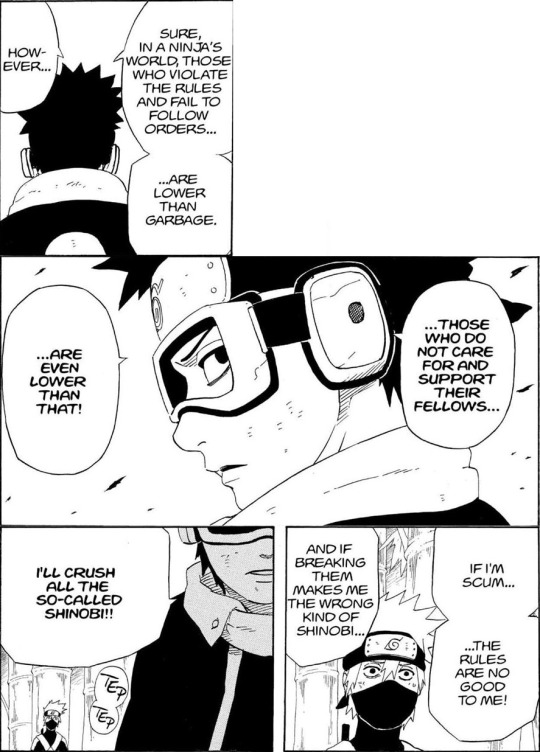
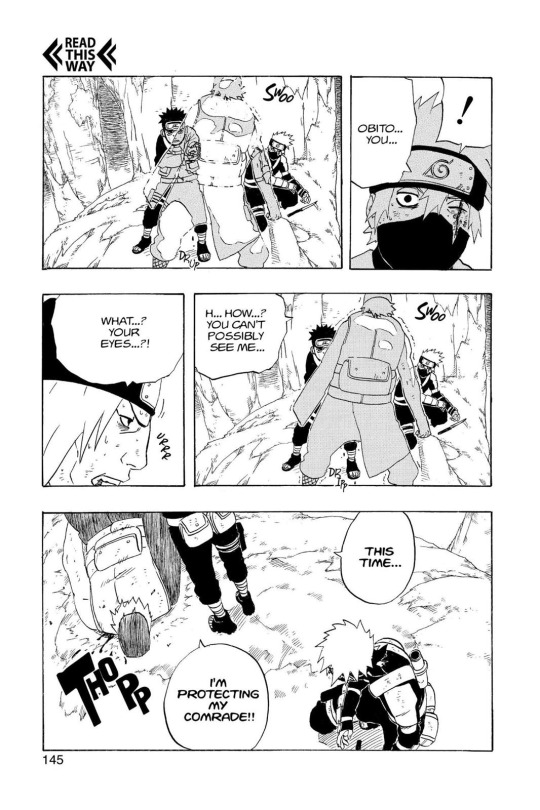
He not only vowed to "crush" the shinobi that diverged from his dogma, but he was able to gather the resolve to kill someone in order to protect Kakashi (this was likely his first kill).
At this point, it is of course important to touch on Obito's love for Rin Nohara. Obito was a kindhearted Uchiha with big ambitions to be Hokage and end the war. But among the prestigious Uchiha clan, he was a washout. A disappointment. For a long time his only real support was Rin, and so he became attached to her.
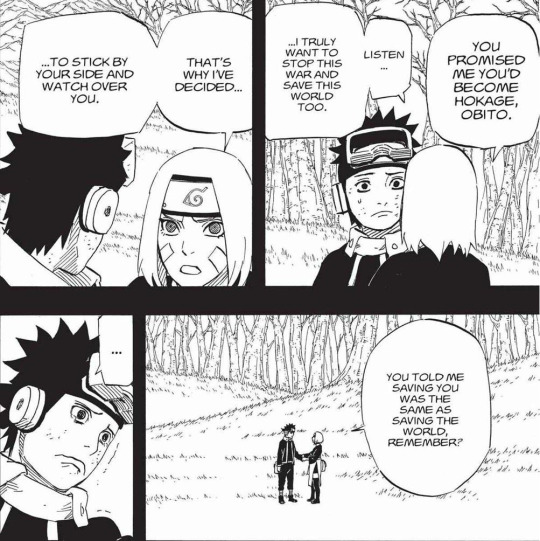
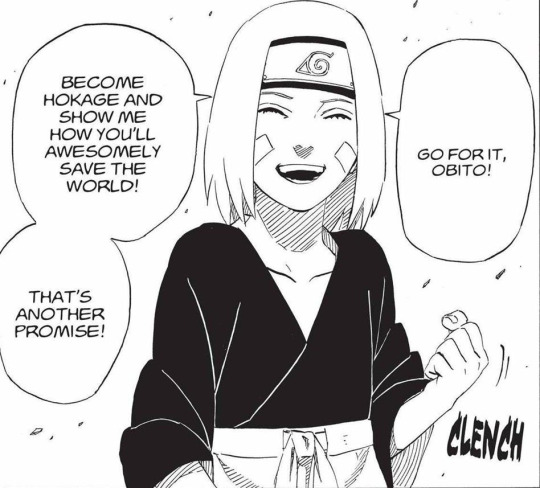
Obito's insistence on rescuing Rin in the Gaiden was not, however, just because of his feelings for her. They played a role, but she was also a comrade of his, much like Kakashi. They did, however, play a larger role in his request to Kakashi. Obito ended up being smashed by boulders in the process of saving Kakashi. The two had formed a bond by then, so he entrusted his eye to Kakashi, telling him they would "see the future together". Even though he had been very mature throughout this experience, however, Obito was still a child at heart and told Kakashi to protect Rin at any cost.
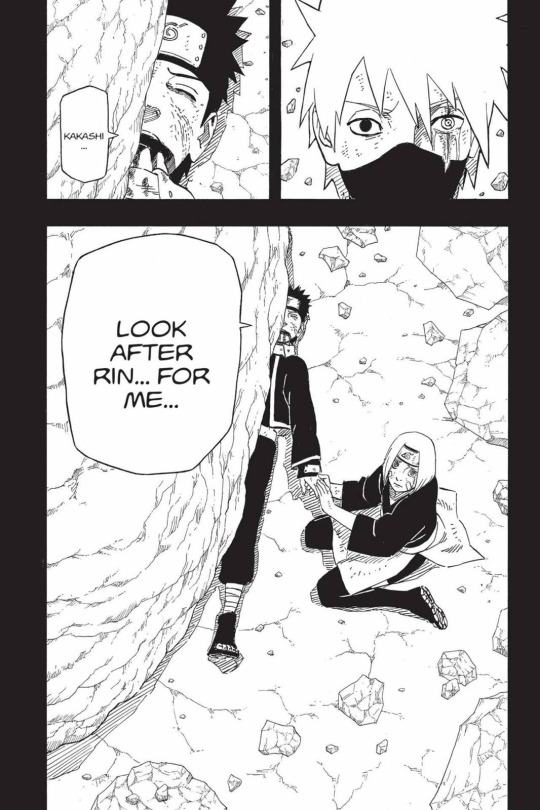
Now, it’s very important to note Obito's last thoughts before being supposedly killed.

His most desperate wish is to survive so he can spend more times with the people he cherishes, which will become his main drive when rehabilitating in Madara's cave.
Afterwards, a battle ensues and Kakashi moves to protect Rin. He later wakes up with Minato sitting beside him, and wonders if he survived.

However, he was not the only one to survive. Obito found himself in a very similar, but less fortunate situation:

He awakes in an underground cave with Madara Uchiha. He is relieved to be alive, but is constantly driven by the desire to return to his comrades and protect them with his newfound power. Madara reacts to this by telling him his hopes are futile and reality is cruel.
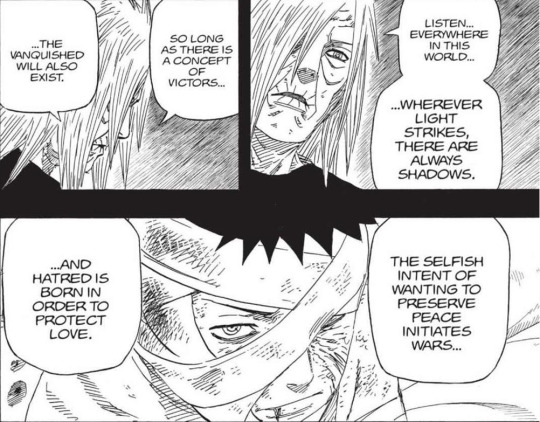
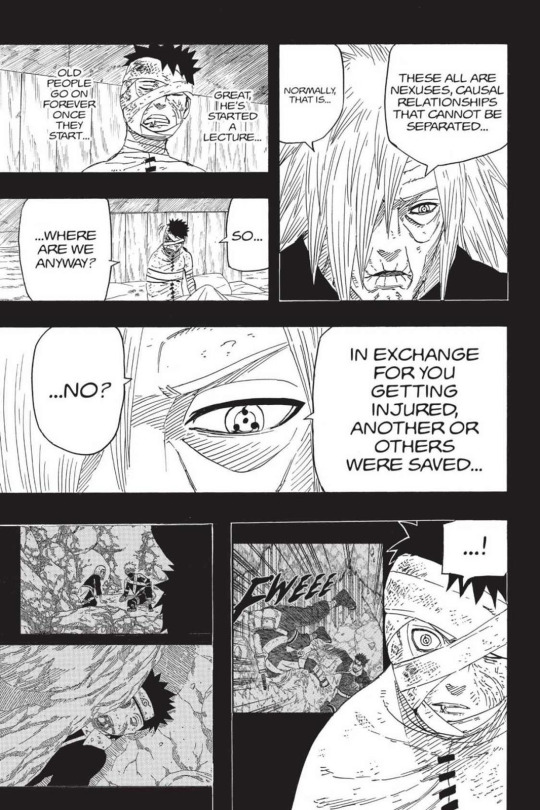
But Obito, of course, would not pay heed to this until much later.


The only thing giving Obito hope and strength during this drawn on underground recovery, with half a body and surrounded by strangers and pessimism, is the thought of returning to his comrades. That thought is what keeps him going during his time spent down under.


Obito's most prominent trait for a while now has been hope. He's put all his being into reuniting with his comrades and escaping from this creepy geezer. But the reality ended up being far harsher.
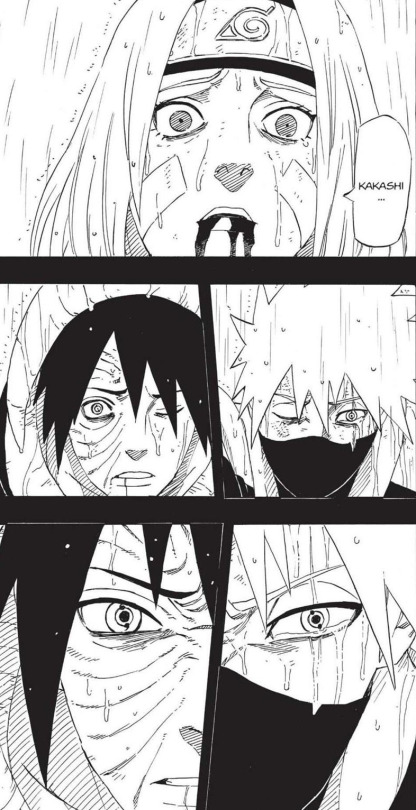
Obito's entire world was shattered in this instant. The power he had entrusted to his newfound friend Kakashi to protect Rin was robbing her of her life (Obito’s Sharingan perfected Kakashi’s Chidori). Not only did Obito lose the one he loved, but his view of the world was shattered. All his hopes were crushed in that instant. But what happens here is one of the key differences between Obito and Madara. Obito does not lose hope in the world; he denies that he has it. He refuses to accept the reality before him.
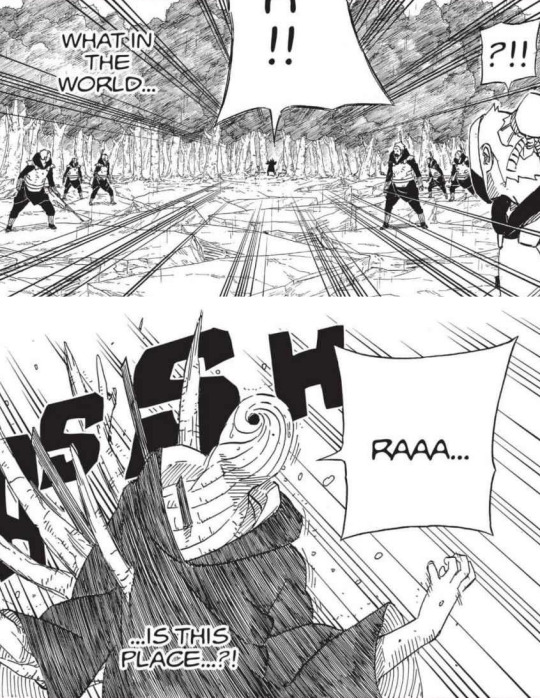

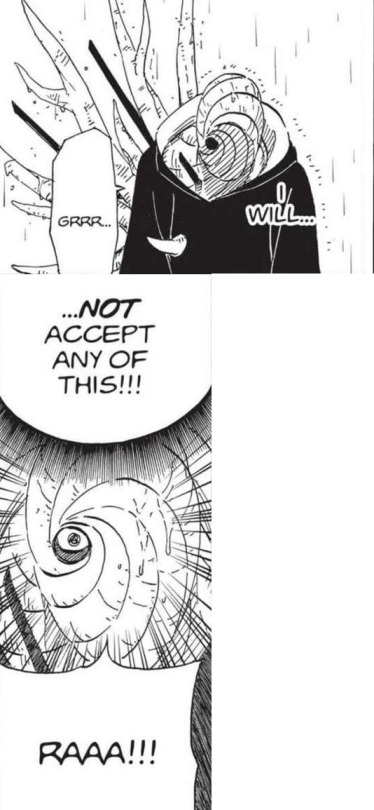
Obito was in an unfamiliar place in unfamiliar circumstances, and his life just fell apart before his eyes. His immediate response is to reject what he sees. In contrast, Madara slowly but surely lost hope in the world over time. He accepted what the world was (or rather his perception of it). Obito couldn't. He never developed, or had time to develop, the mental state for it.


The person he loved most was killed by his best friend, and all his efforts had proven useless. Unlike Naruto, Obito was alone, and the people he did have, well it's self explanatory what happened there. Obito from this point on started operating in the shadows towards the completion of Madara's plan.
Obito's general persona from this point on slowly becomes more detached and warped. He gains a sarcastic/sadistic bend to his personality and becomes increasingly divorced from reality, as he has abandoned (or rather surpressed) his hope for the world.

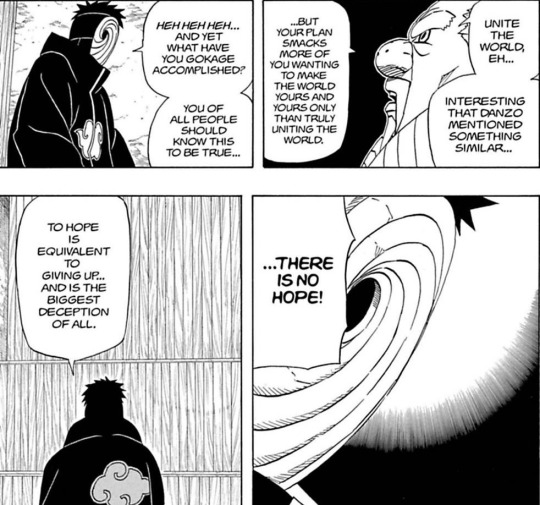
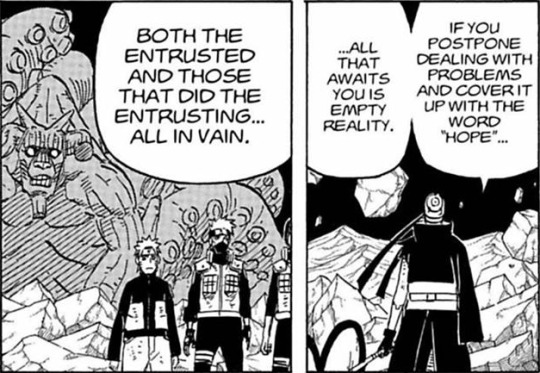
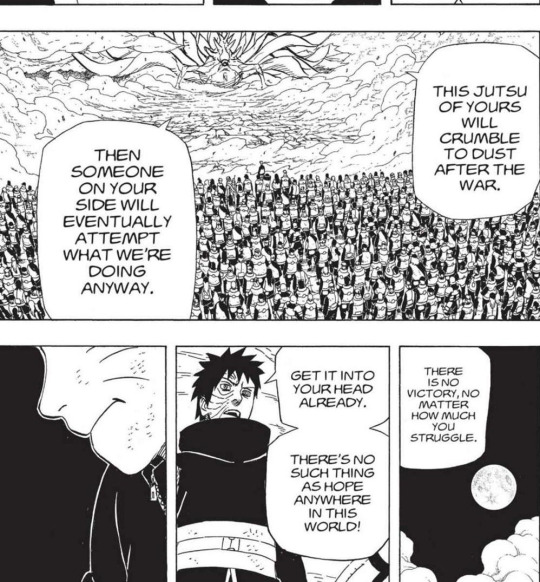
He still is fixated on and values camaraderie, but it's not in the same way he did before. It's more self-serving now.
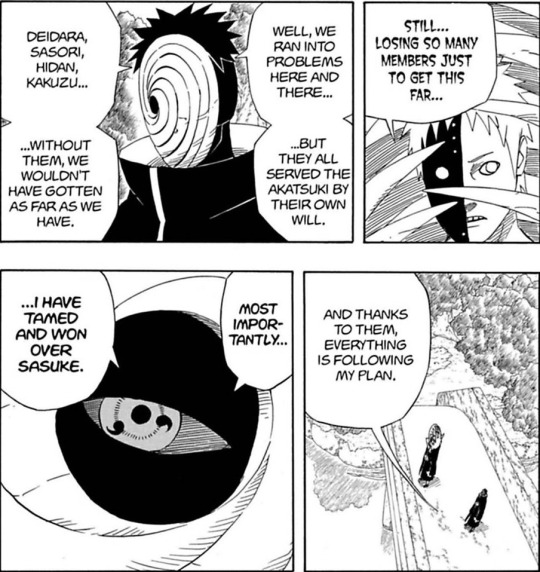
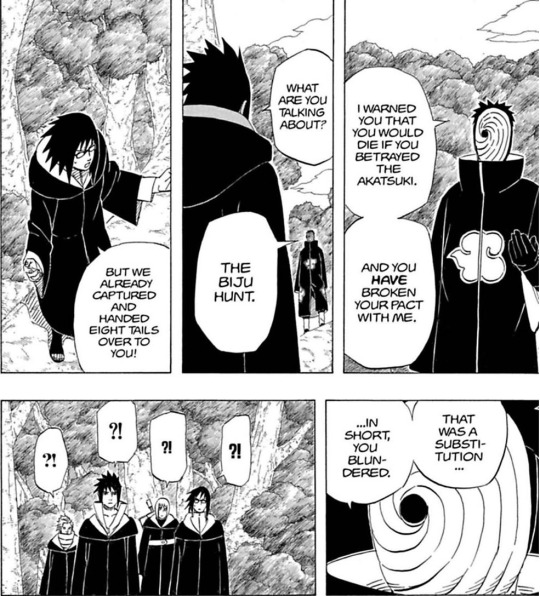


He values loyalty, so long as it's loyalty to him. However, when double-crossed he will be merciless.
The seeds for this were planted earlier though, albeit in a more innocent form.

This is an important divergence from Madara, who didn't really care about the loyalty of his comrades so much as their usefulness to him. As seen by him giving no shits when learning of Nagato's betrayal and not caring about Obito having his own plans either.

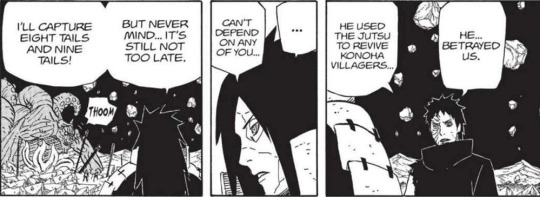
Obito's also become quite deluded by this point, choosing to consider the real world and its inhabitants "fakes" and the Mugen Tsukuyomi world to be "truth".
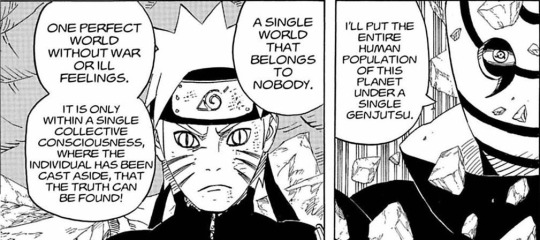
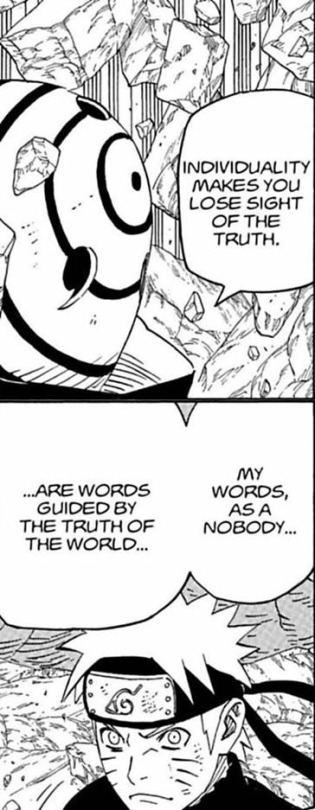
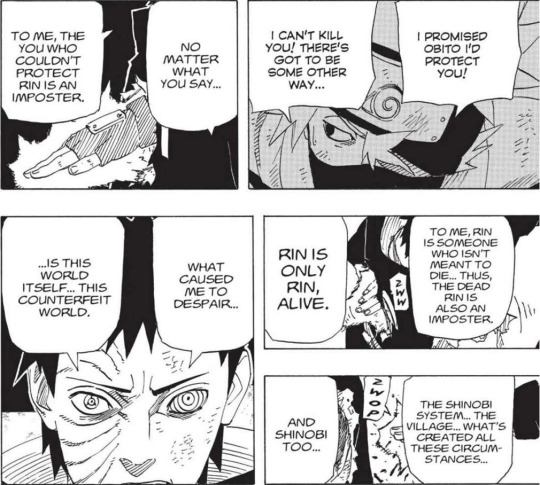
Basically, he considers bonds and interpersonal relationships to be a farce, because he believes the world will sever those ties, without fail, and cause people to sink into despair. Thus, uniting together would eliminate that and create harmony.
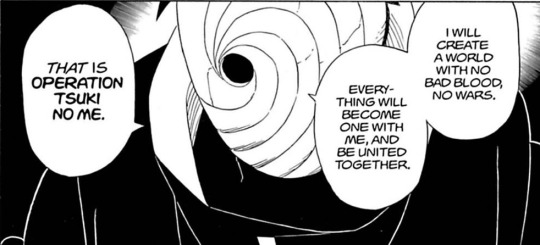
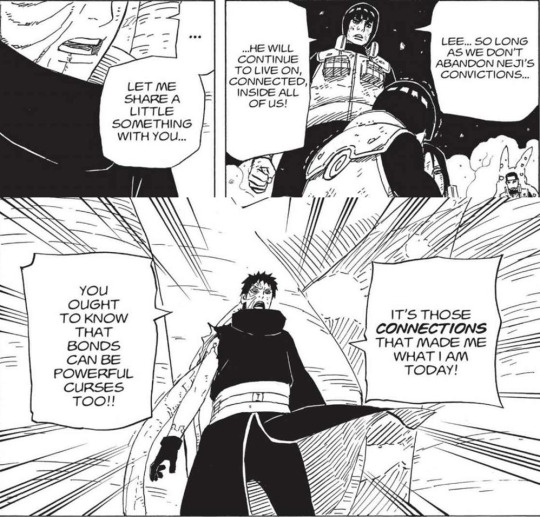
The way Obito sees it, this shinobi world that doesn’t align with how he thinks things should be is “false”, and the Moon’s Eye Plan / Tsuki no Me Keikaku is the remedy.
The thing is, while Obito did initially defect due to the shock, trauma, and despair induced by everything to do with Rin’s death, he still did not have the hardened outlook on the world he would display in his adult years. As he made moves towards the completion of his plan, Obito observed the shinobi world's workings and it only served to deepen his conviction.
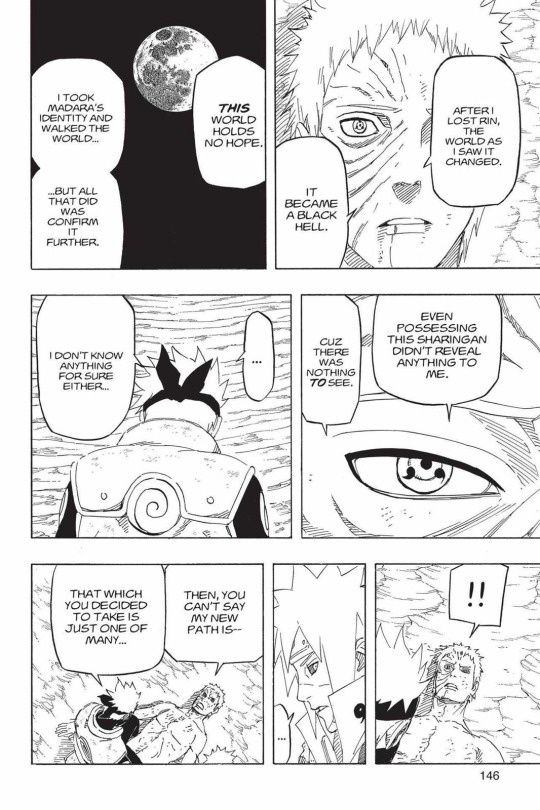
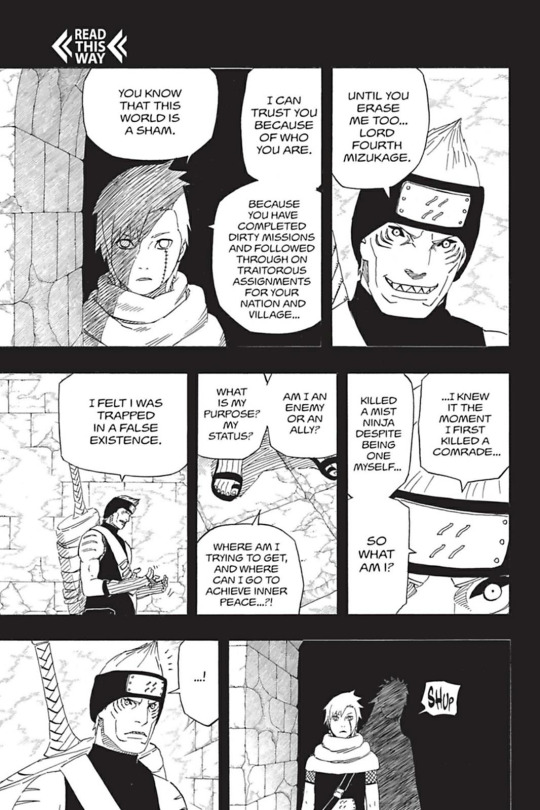

Obito, though not as far gone as Madara, steeped himself in the darkest areas of the Shinobi world. What he saw just reinforced his belief, or rather he made it so. He surrounded himself with fallacy (his identities of Madara and Tobi) and negativity. Even when seeing the brighter aspects of the world, Obito would brush it off.
See:
https://en.wikipedia.org/wiki/Cognitive_dissonance
https://en.wikipedia.org/wiki/Confirmation_bias
This shared outlook on the world may be why Obito considered Kisame "the person closest to him".
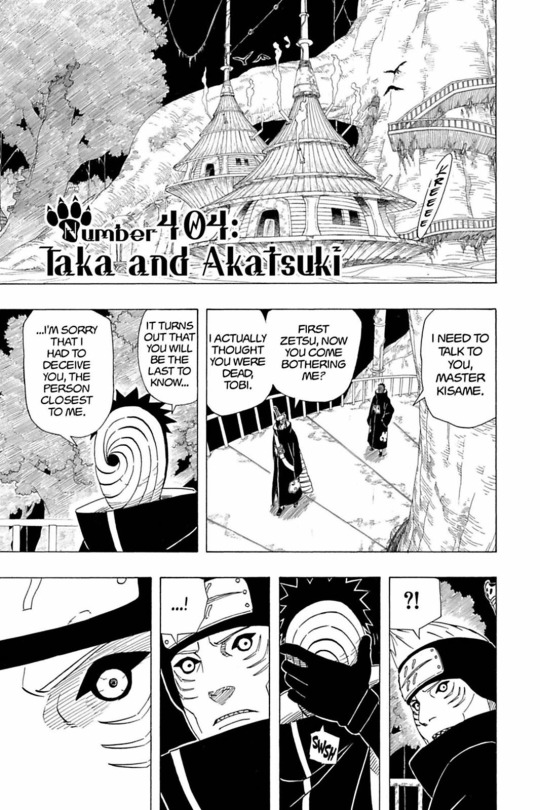
So, we’ve established what Obito is like by the time the main story unfolds. However, something starts to happen in Obito after Nagato’s betrayal at the end of the Pain Invasion arc.
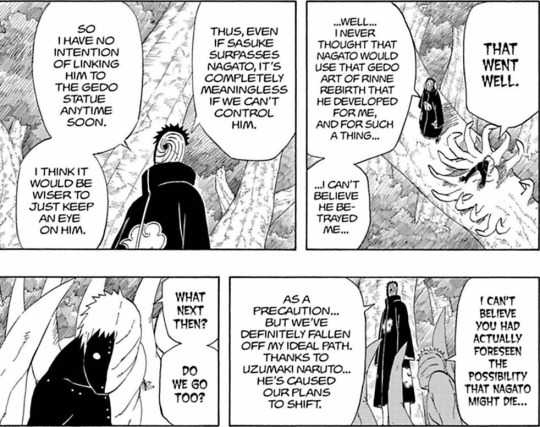
Obito is bothered that Nagato, who was quite similar to him, was convinced to switch sides. This sort of reignites the doubt in Obito's heart, and so he goes to ask Naruto about it. Naruto, the boy who was so much like Obito and inherited the younger Obito’s ideals by way of Kakashi.
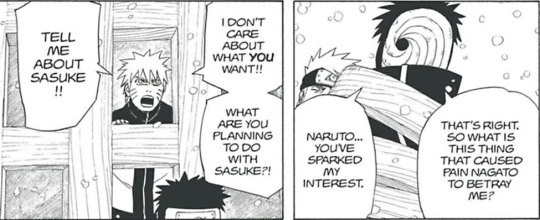
Of course Naruto cuts him off, and so Obito gets no immediate answer. His anxiety and anger towards Nagato and fixation on Naruto escalates when he fights Konan.
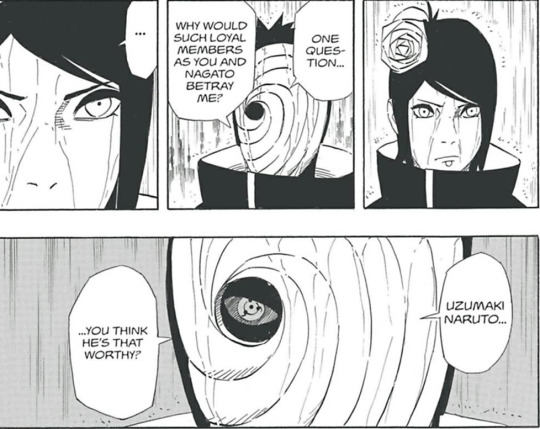
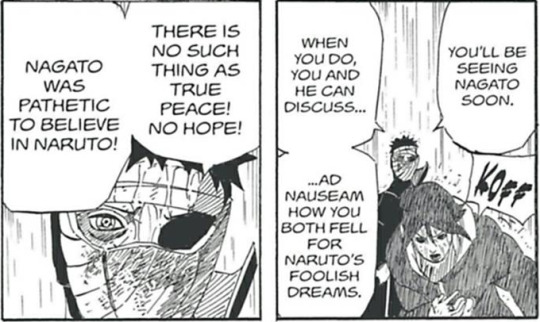
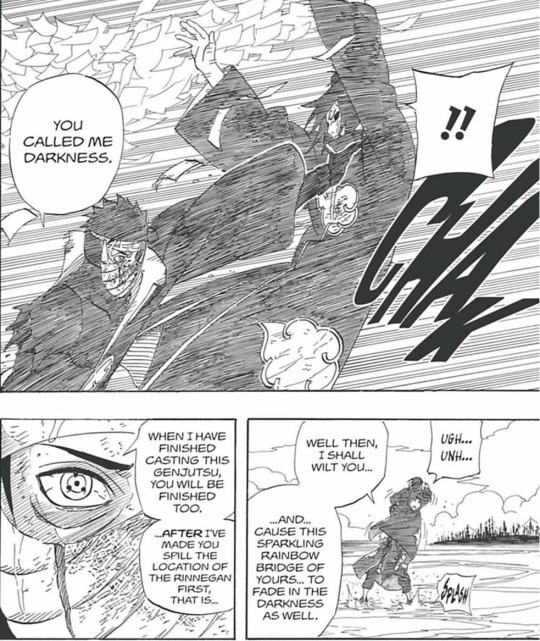
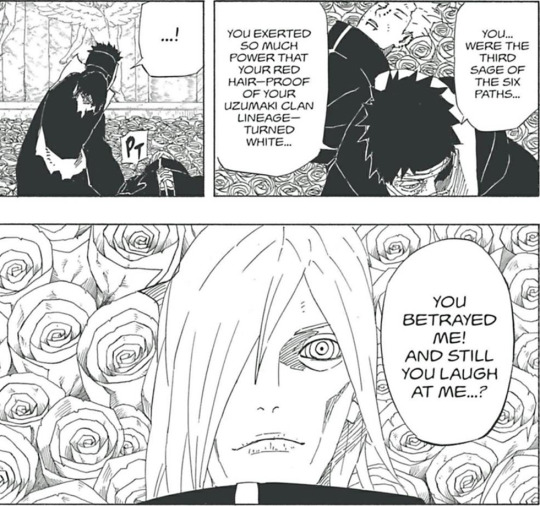
This, of course, would come to a head in the Fourth Shinobi World War, where the two shinobi finally clashed head on and pit their ideologies against each other.
Interestingly, Obito also sees himself in Sasuke. Both were motivated by the death of someone they cared about, but chose to nullify their sacrifice for the sake of their personal ideals.
Compare the following pages
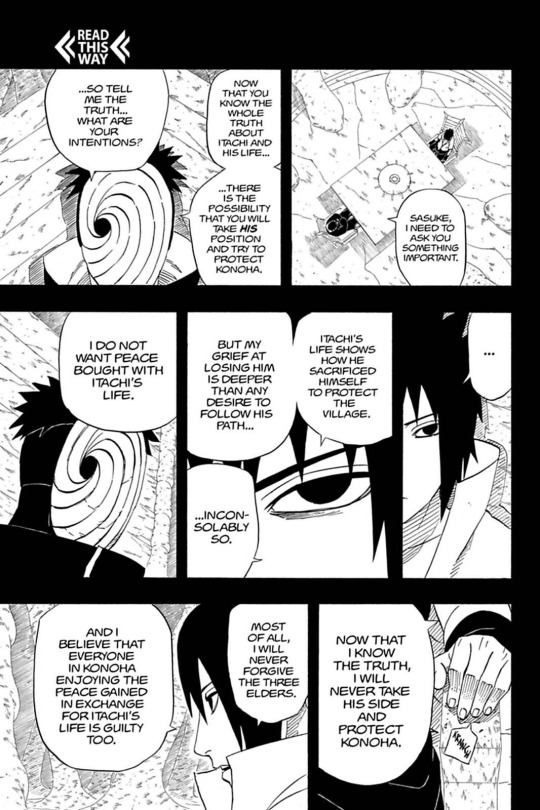
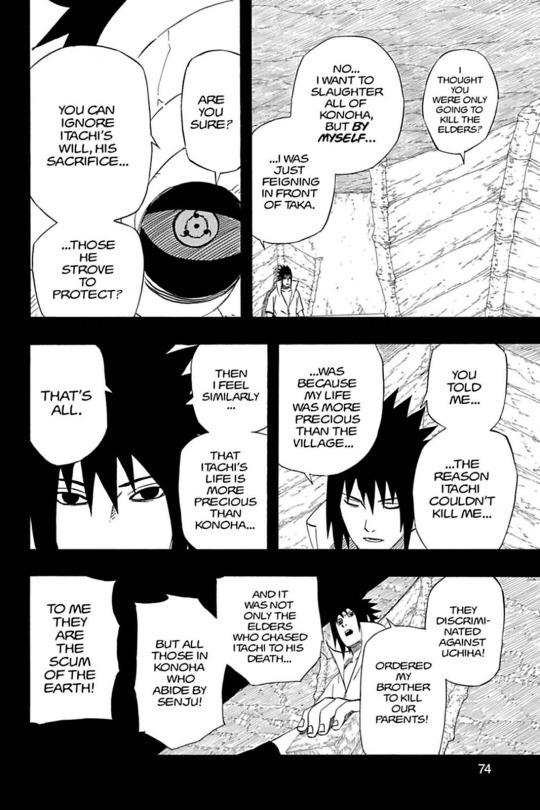
to this exchange
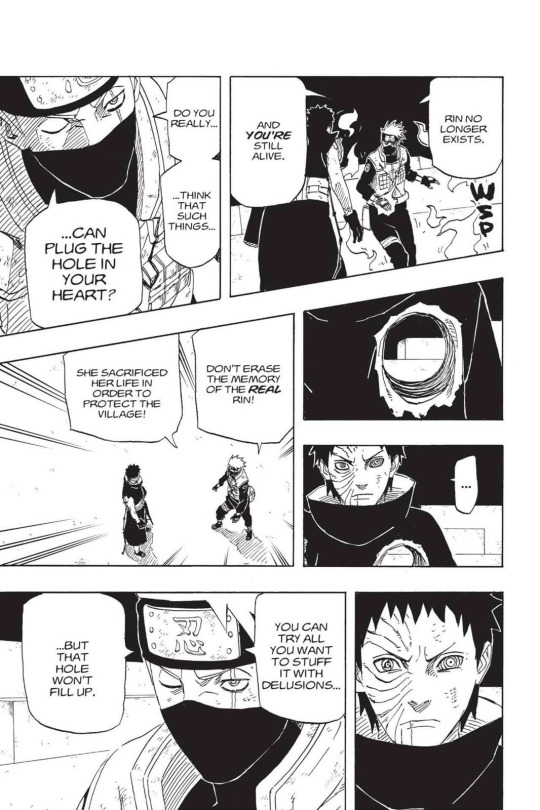
Obito was asking Sasuke if he had the resolve to shit on the sacrifice of someone he loved for the sake of his own motives. Basically asking if he was like him.
And well
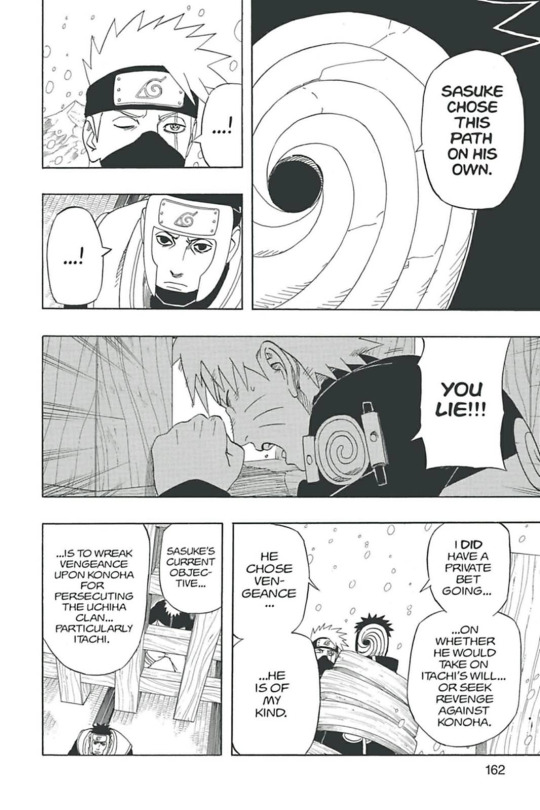
Obito’s corruption of Sasuke is even a direct mirror of when Obito awoke in a cave with Madara, who had sinister plans of his own for Obito.
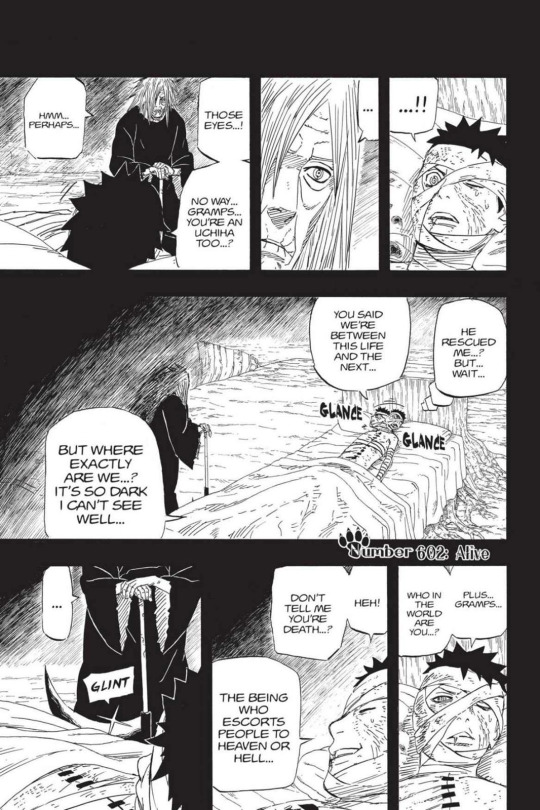
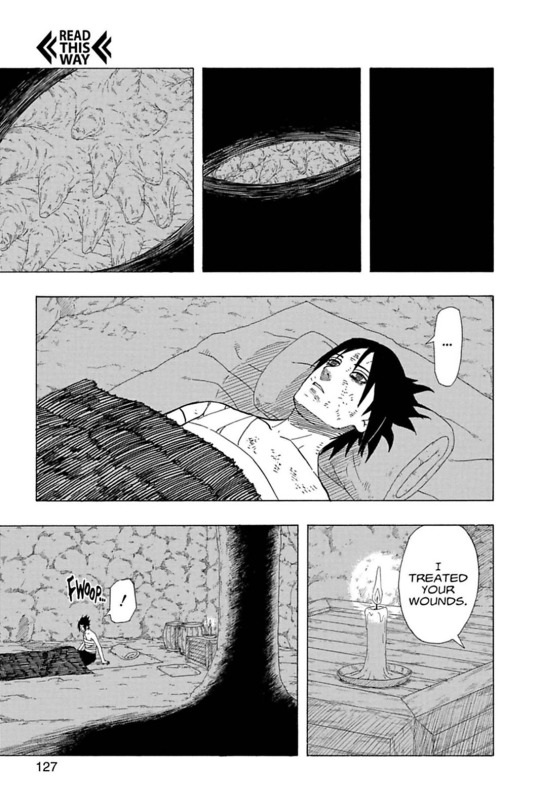
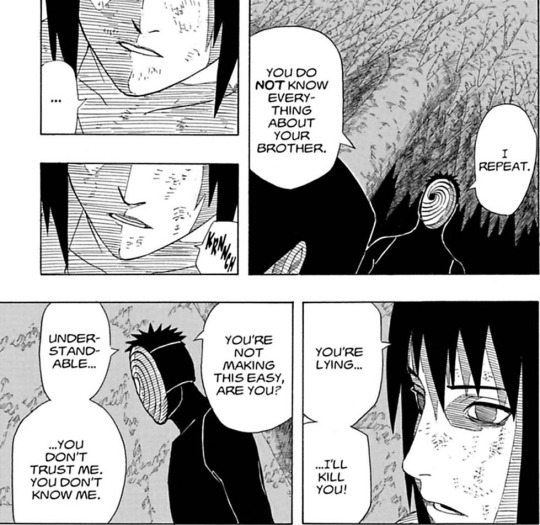
So yes early as the Gokage Summit arc, the conflict in Obito was making itself apparent. The fight Obito attempted to orchestrate between Naruto and Sasuke was a microcosm for Obito’s own inner conflict that would come to a head in the War Arc, specifically when Kakashi and Guy arrived on the battlefield to help Naruto.
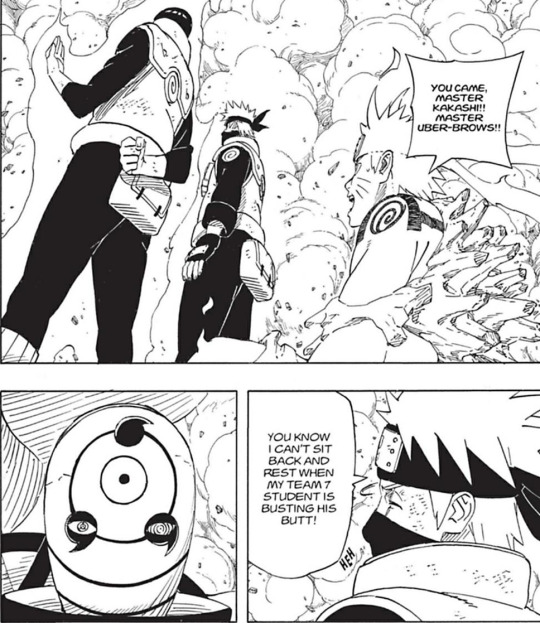
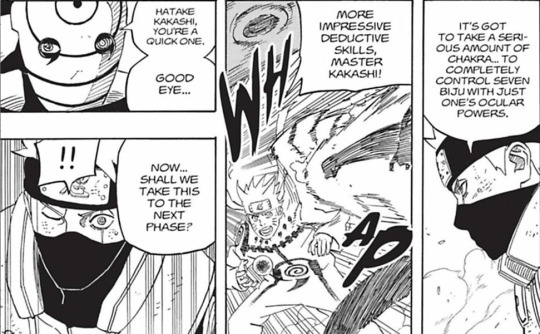
He struggles harder than he'd anticipated in his battle with Naruto, who begins to gain traction in their clash and amasses chakra from almost all the other biju as well as finally synching with Kurama.


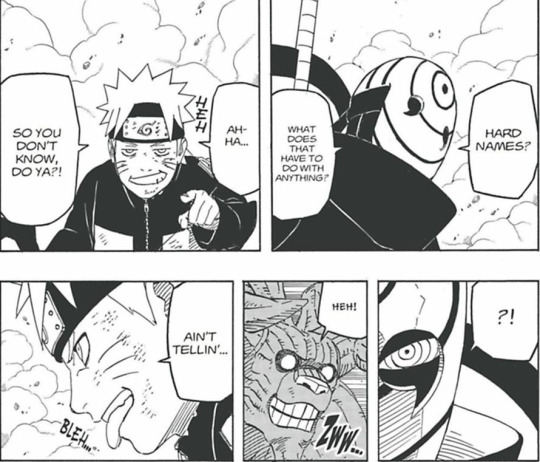


These past few panels are from Chapter 573, which contains Naruto’s comrades running to his aid and ends with this panel

You’ll see later why this and a later panel perfectly bookend the meat of Obito’s journey to find himself again.
Now, Obito still manages to somewhat retain his composure in this chapter, but by the time the story next cuts to the battle his detachment has lessened. His lunatic rantings increase in intensity, and he becomes more invested in Naruto and Kakashi. He was probably having those Rin flashbacks people love to criticize too but they couldn't be shown then for obvious reasons.
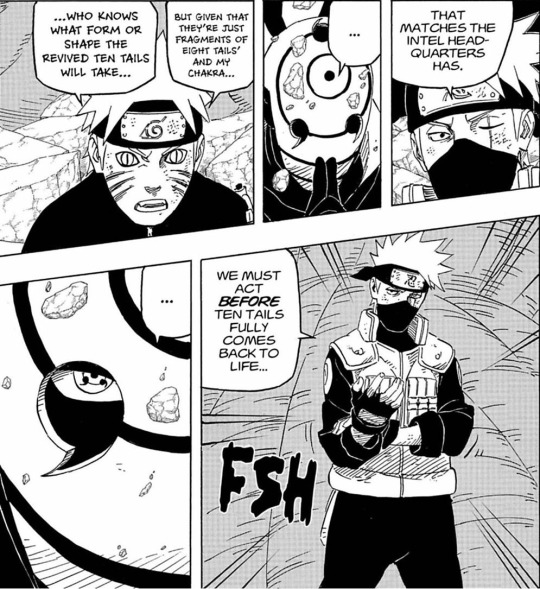
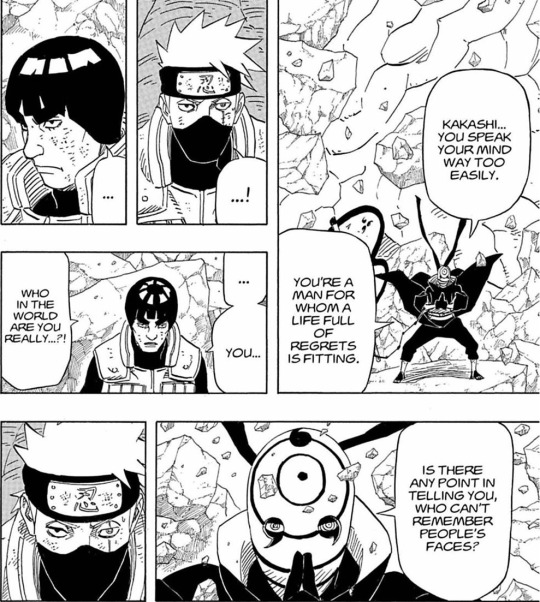
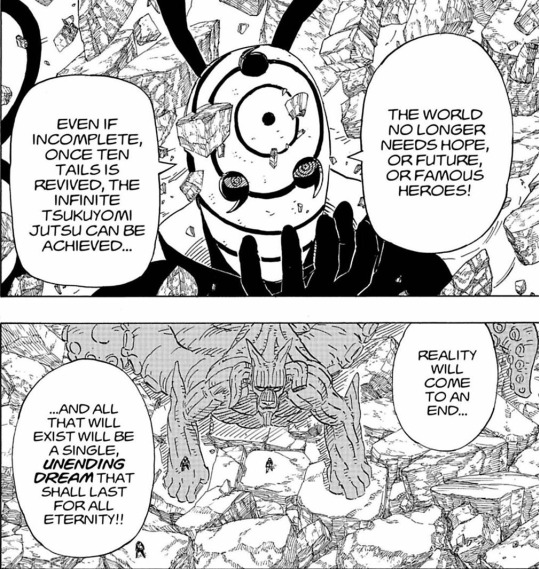

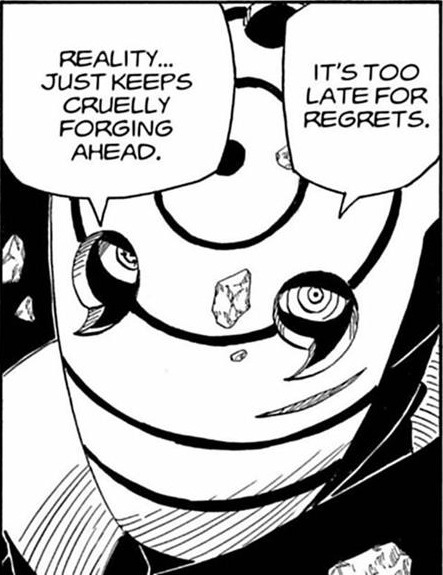
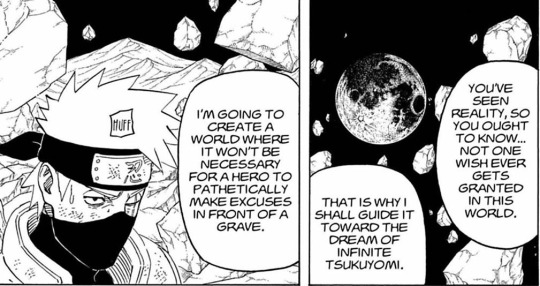
Once his mask is finally broken, Obito can no longer really run from his insecurities and grief. After all, now that he's unmasked he won't be able to escape more personal questions from Kakashi. He has to address things in more detail than he’d like to, at least to some extent. Although, he initially maintains some remnants of the detachment he'd held til then.
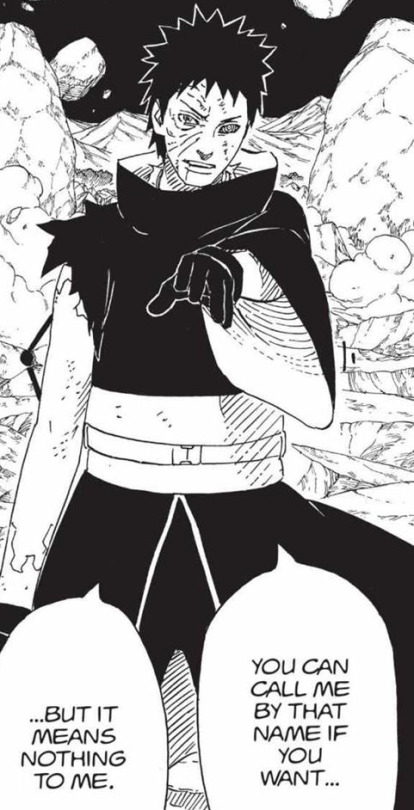
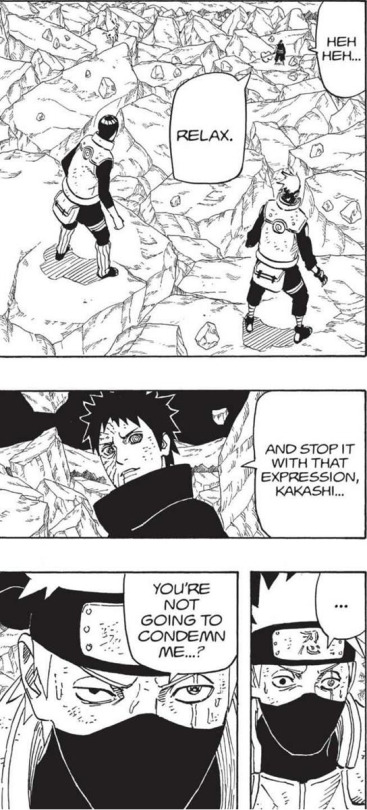


However, he soon fights Kakashi one-on-one and his rage boils to the surface.
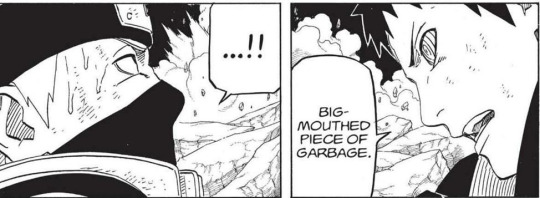
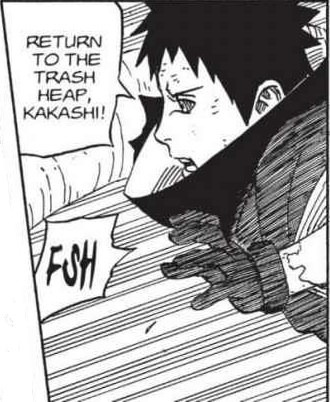
Now I only posted enough of this to get the point across. But this man really beat the living shit out of Kakashi. He’s angry, despite his prior claims to have cut himself off from personal ties.
At any rate, towards the conclusion of their scuffle, Naruto joins in and starts touting his resolve to protect his comrades and defeat Obito and Madara.
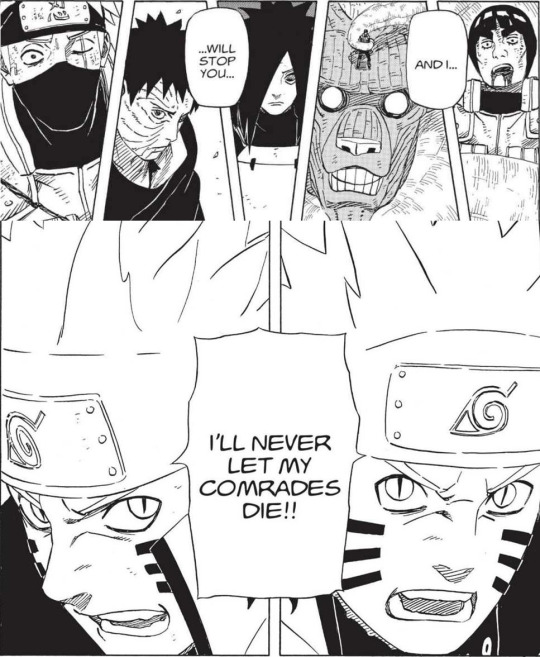
Now, it's around this point that Obito really attempts to crush Naruto's ideology, as it's basically his own (formerly of course). But Obito desiring to twist Naruto and in turn solidify his own conviction was first hinted during his fight with Konan, where he swore to "fade him into darkness".

He believes Naruto, and basically every shinobi, is destined to turn out like him (scum, basically. At least, I doubt he meant everyone would become a psychotic masked murderer).

Itachi earlier foreshadowed this same thing to Naruto, warning him of what would happen if he forgot the people that got him where he was.

Obito recognizes that Naruto's ideology was basically the mirror image of his own, among their other similarities. By this point his resolve has wavered a good deal, so he resorts to trying to break Naruto's spirit in order to convince himself his path isn't mistaken.

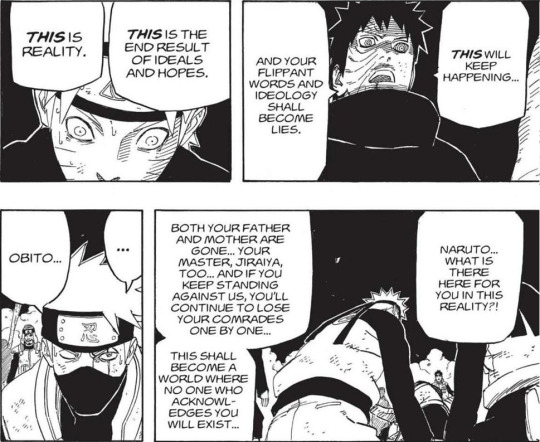
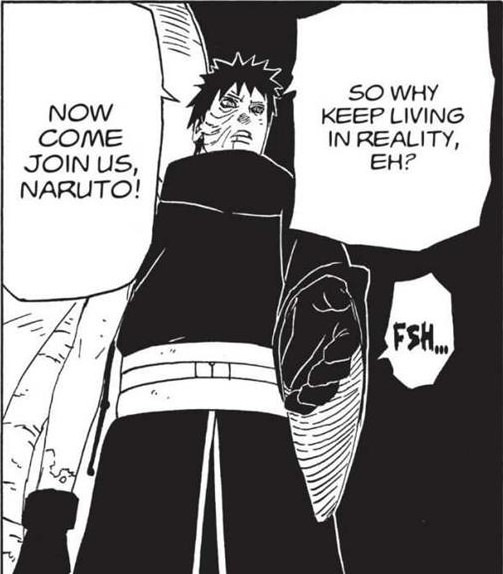
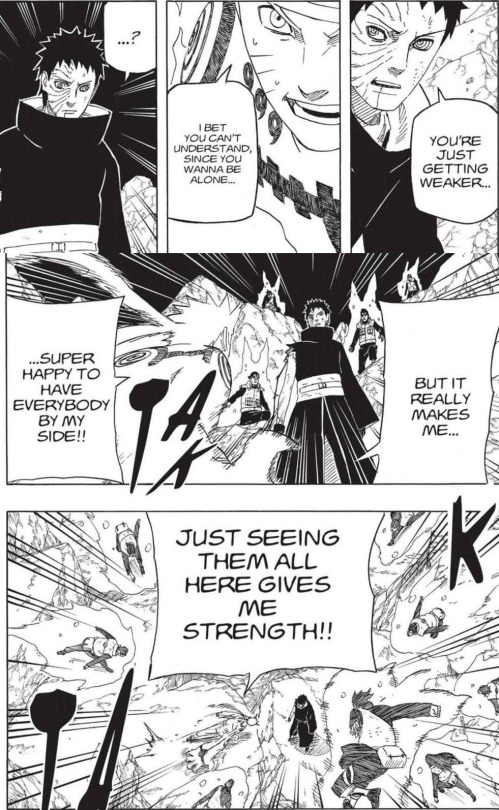
This is a good time to bring up something I don’t think I can fit anywhere else. While trying to convince Naruto to abandon reality, Obito brings up the deaths of Minato, Kushina, Jiraiya, and of course Neji. All things caused, directly or indirectly, by Obito himself. This is why the act that Madara orchestrated Rin’s death is irrelevant.
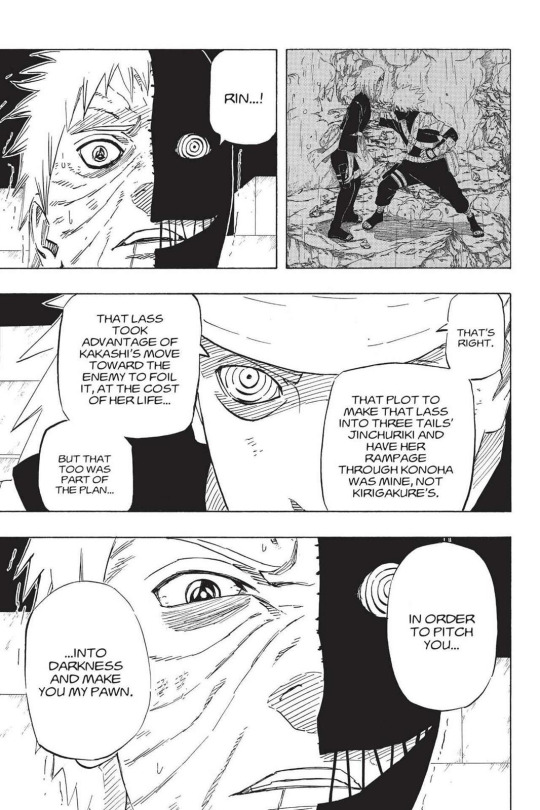
It’s beside the point of Obito’s despair and I dare say if he learned of this while still “evil” he wouldn’t have changed. He didn’t even like or trust Madara to begin with. It was the fact that such things occurred at all that raked at Obito’s mind. After all, it’s not like Obito has never manipulated people for his own ends.


So this moment is more meant for Madara’s development, because it demonstrates his extreme arrogance which is shattered when he is betrayed by Black Zetsu and learns he was the biggest pawn of all.

Anyway, soon enough the Ten Tails starts to go out of control. This prompts Obito to commence with his plan of making Kakashi stab through Madara's puppet seal, which would enable him to become the Jinchuriki.


I'm pretty sure I've covered all the relevant characterization focused on in his battle with Kakashi in previous parts of this, so I'll just speed ahead to after that.
Obito comes out of the Kamui dimension and is immediately assaulted by Madara, who wants Obito to Rinne Tensei him.

This point marks an interesting shift in the way Obito is portrayed. He is seen struggling against Madara's rods and relying on the memories and thoughts of his former comrades to propel him forward and resist the takeover.

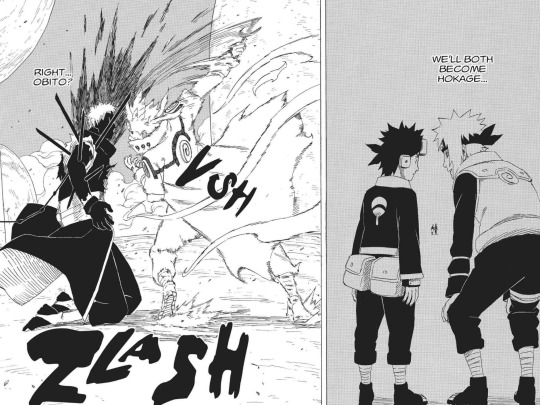
It’s moments like this that almost makes him feel like the protagonist.
But even with that, Obito still retains a villainous aura, as seen when he confidently declares that the war hasn't reached its end.

Yet even after succeeding in becoming the Jinchuriki, his ego was still under siege by the Ten Tails. And once more he draws on his memories of his comrades to resist and regain control. This frequent blending of heroic and villainous portrayals makes his eventual change feel even more organic in my opinion.
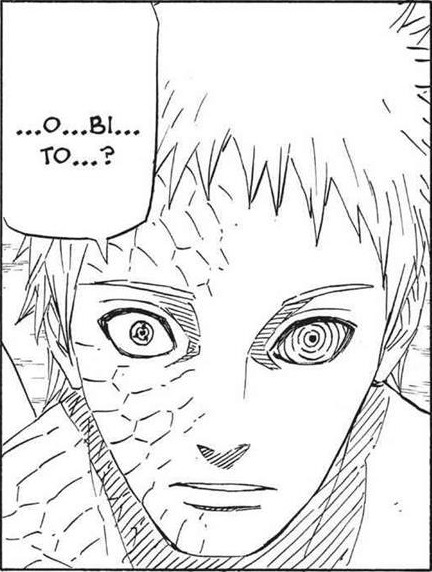
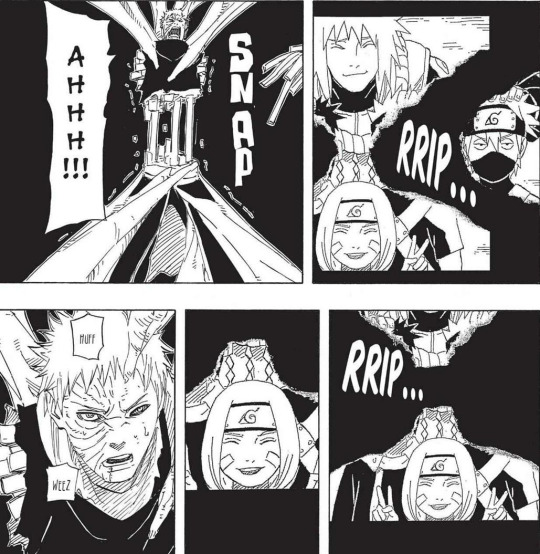
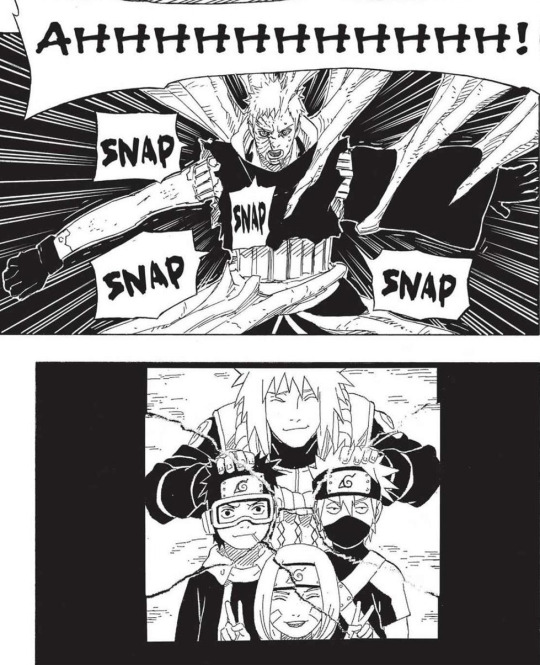
Obito's newly acquired power makes him the focus of the war, although Naruto, Sasuke and others start to gain on him and even the playing field. Obito becomes more agitated at Naruto and his constant interfering with his aims.
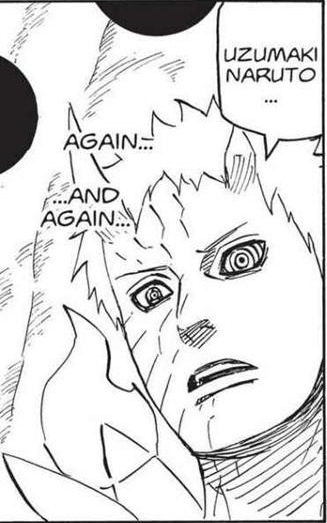
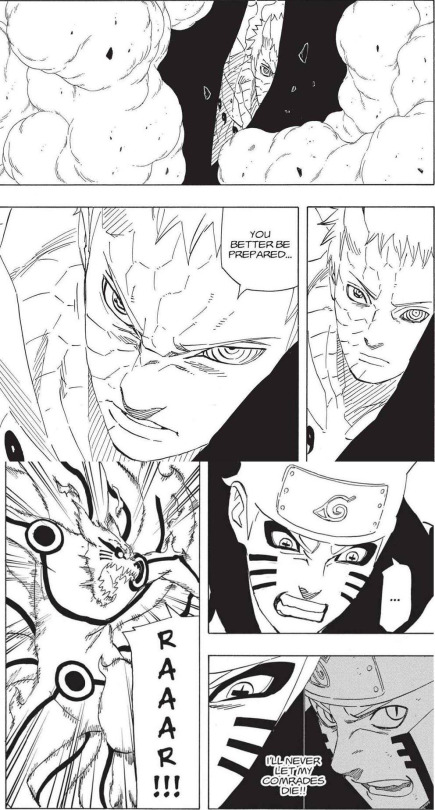
His frustration and fixation with Naruto has grown to an insane point. And it started with something so small and seemingly trivial:
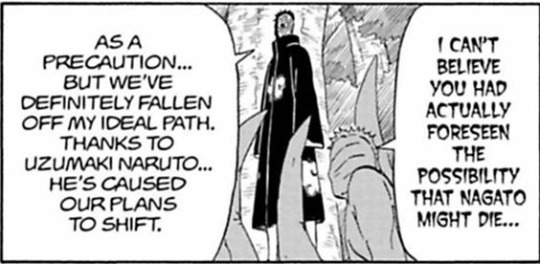
So anyway, Obito continues to question and nudge Naruto in order to reach a conclusion about his own choices.
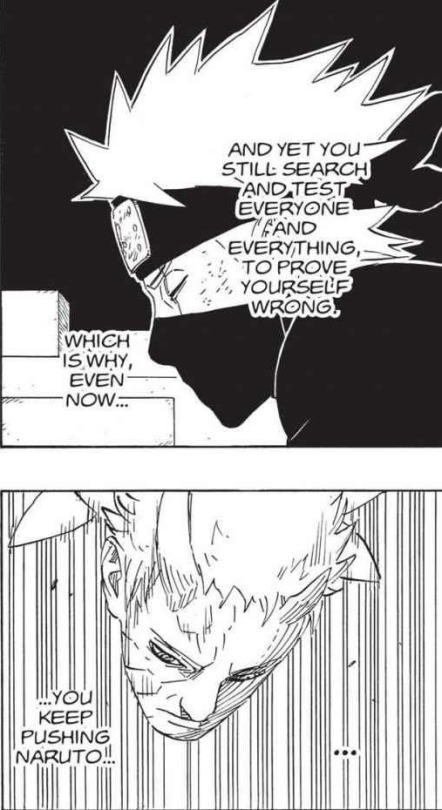
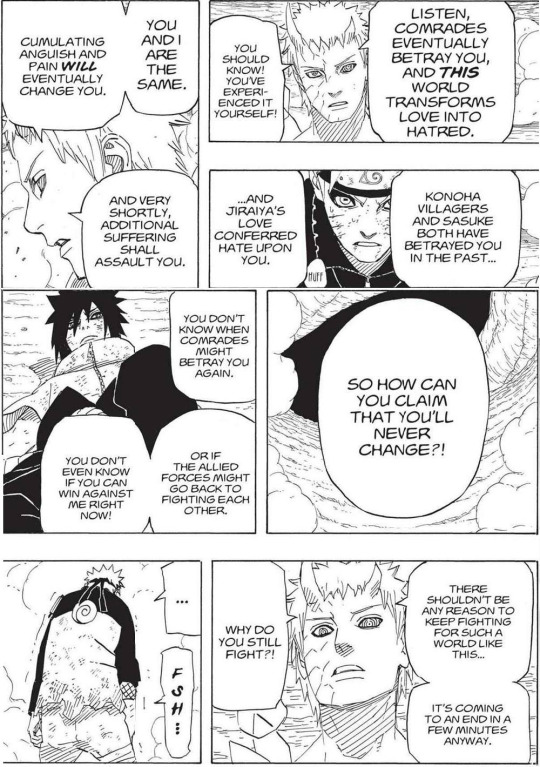

Now, the "my ninja way" thing may come off as bullshit and might not seem like a good answer. But the thing is, Obito isn't asking Naruto how to fix the shinobi world's problems. He's simply trying to see if he has the will to persevere no matter what the world throws at him. And by this point, Obito is almost convinced. Obito was never about grand visions concerning villages and government. That was Madara. Obito was always more intertwined with the personal aspect of suffering, which is why Naruto’s refusal to break infuriates him.
Before:
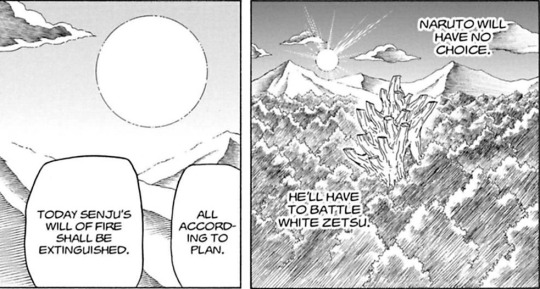
After:

By this point Obito's resolve has wavered considerable, resulting in his defeat.
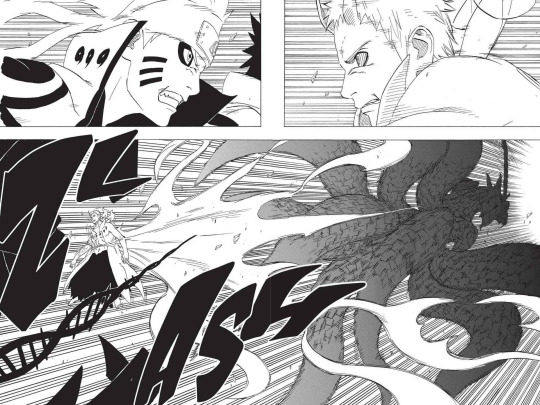
So this is the part where the main "TnJ" or "Talk no Jutsu" stuff comes in. Through the contact between their chakra, Naruto and Obito enter a sort of shared mental space. There, having connected to his memories, Naruto confronts Obito, frustrated that someone so like him turned out how he did. A lot of the shit discussed has already been covered though, so this'll be brief.
I'll just post some interesting tidbits I may not have covered well enough earlier.
First is this:
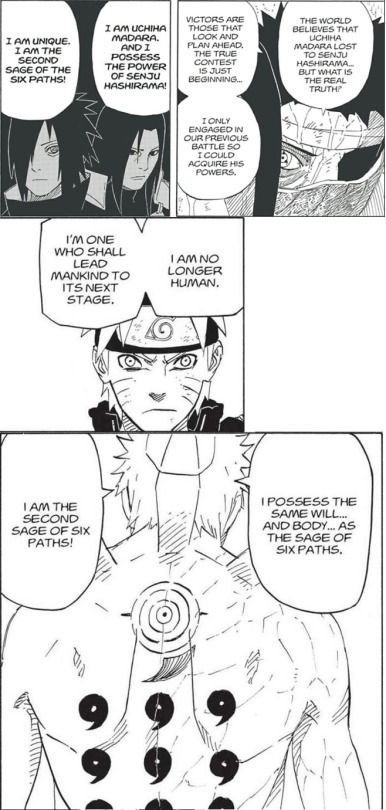
Obito viewed himself as the second coming of the Sage. Looking solely at the first image, you might think he was referring to Madara. But as shown in the second from his talk with Naruto, he really was referring to himself. He also refers to Nagato as the “Third Sage of the Six Paths” after his fight with Konan, presumably as someone who also carried his will.

Why did he not include Madara as a Sage? Well for whatever reason, Obito never seemed to trust Madara. He never wanted him revived, and has stated he never saw him as an ally
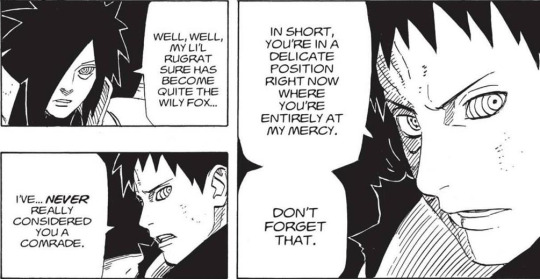
Might have something to do with that puppet seal Madara planted in him to prevent him from becoming the Jinchuriki himself.
Another interesting point in Obito’s talk with Naruto is this parallel with the Kakashi Gaiden.
Chapter 241:
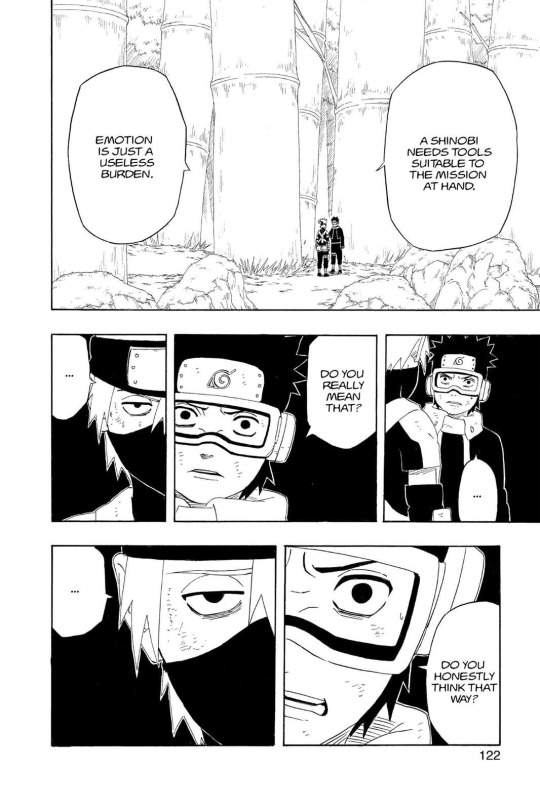

Chapter 653:
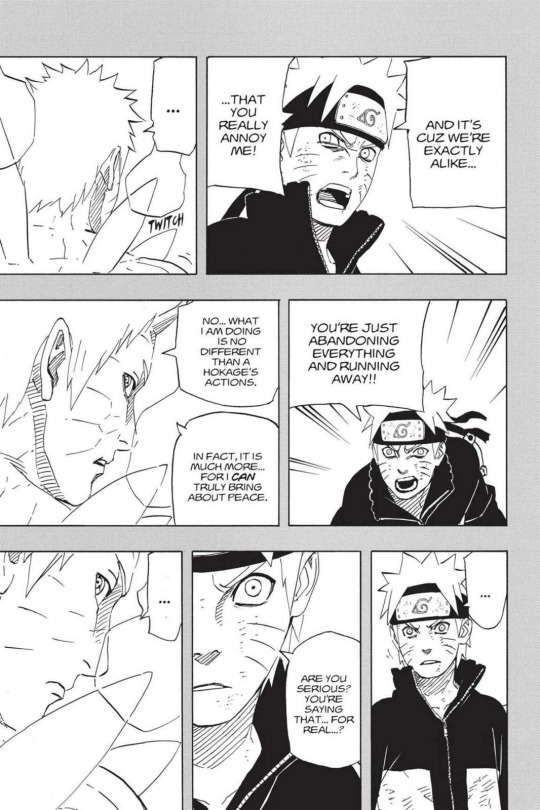
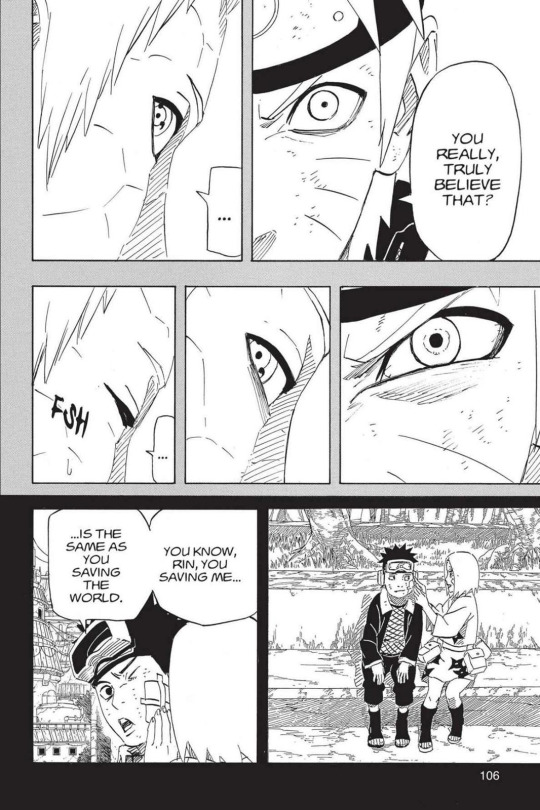
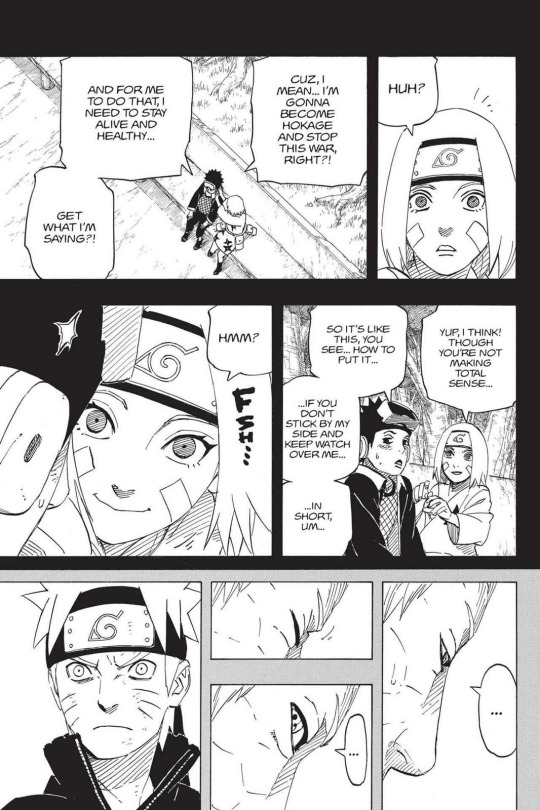
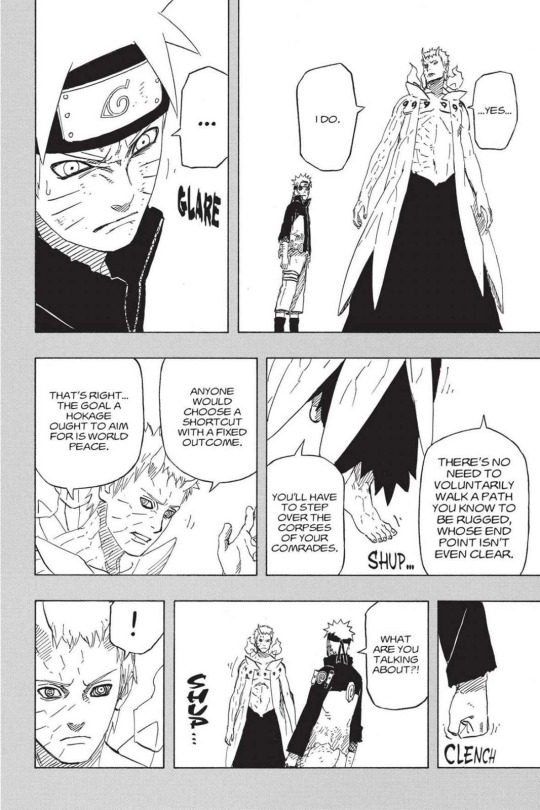
Slick.
So at the end of this talk, Obito is more conflicted than ever, and with the combined power of both Kurama and the Allied Forces, The Biju are released from Obito. It works well thematically as an end to Obito's threat, because Naruto both utilized the power of all his comrades on the battlefield (in the ultimate triumph of Obito’s original philosophy over his new one), and Kurama's power, which was originally placed in Naruto for the purpose of defeating Obito in the first place.

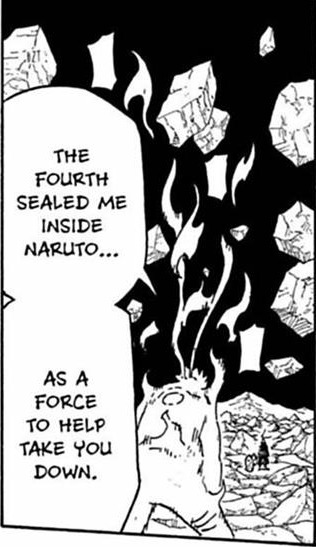
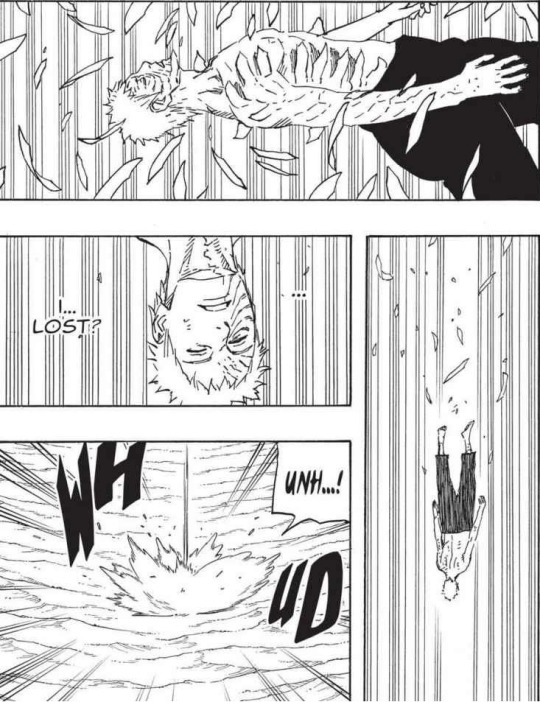
Having been definitively beaten, Kakashi has a final talk with Obito about the path he chose.
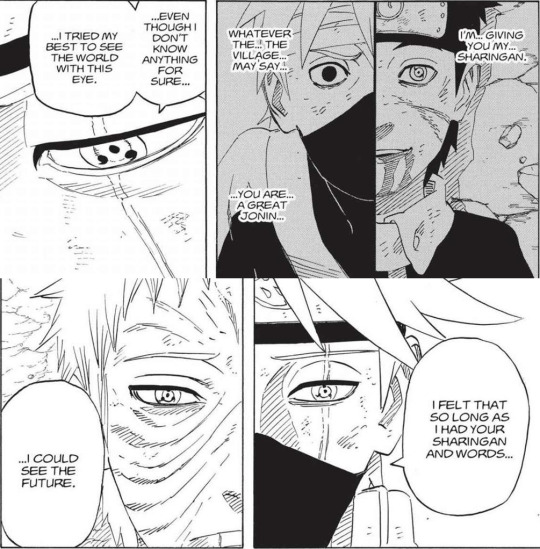
And guess what the chapter ends on?
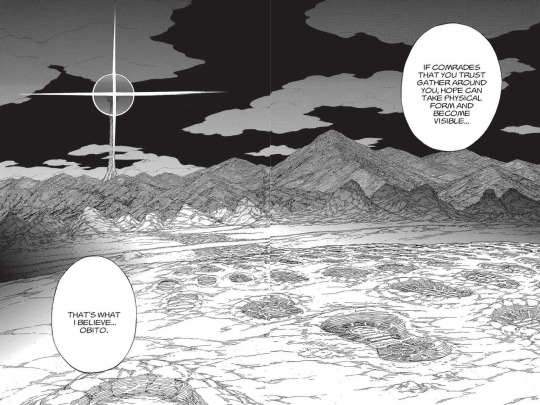

Our friend, the panel from Chapter 573. Fucking slick and thematically poignant.
At this point, Obito finally accepts that his path was wrong, and the whole Nagato thing that jumpstarted his indecision is given a conclusion as well.
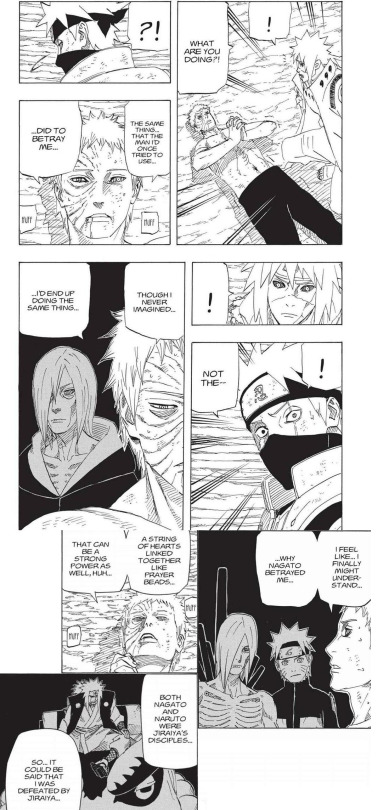
He resolves to give his life to Rinne Tensei his victims in the war, but Black Zetsu intervenes and forces Madara's resurrection. Obito is put out of commission for a while, but eventually regains his senses, and uses Madara as a means to steel his resolve. Sure, he had switched sides, but he was mellow, depressed, and wrought with guilt. He didn’t even believe himself worthy of redemption.
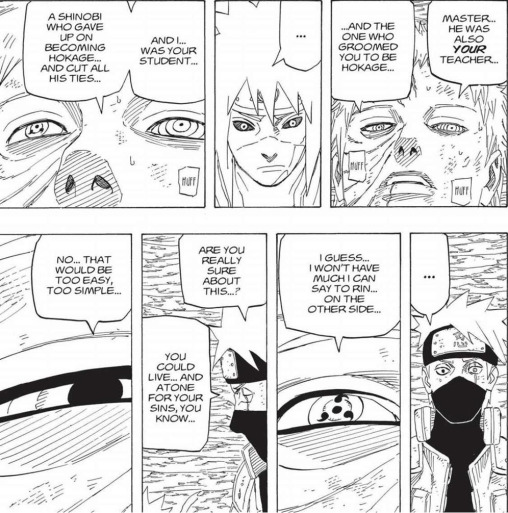
But by talking with Madara, Obito contrasts Madara's ideals with that of Naruto (and also his own original ideals), and finally reclaims his identity as Obito Uchiha, resolving to do his best and end the war.
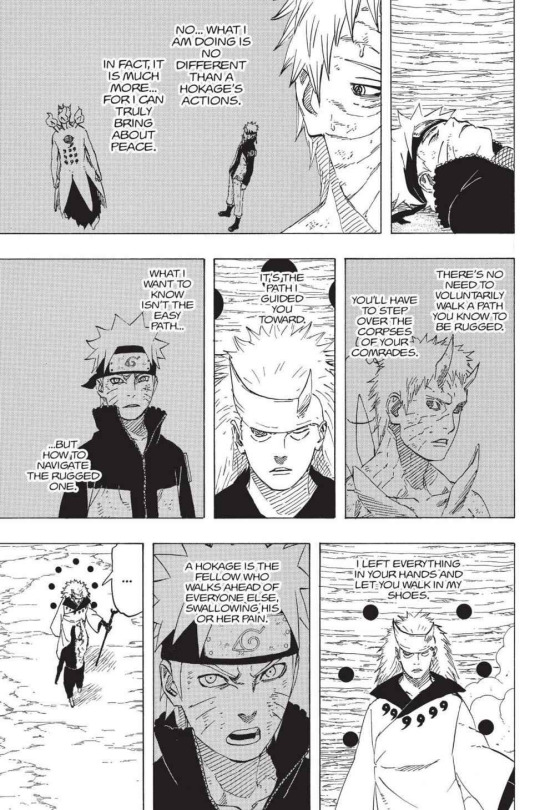

This layout with Obito caught between Naruto's (in actuality his own) and Madara's ideologies is a small scale representation of a major theme of his character. Same with his fascination with Naruto and Sasuke, seeing a part of himself in both of thmm. Obito is the man on which the core of the Naruto series hinges. Even how his literal physical body was half Uchiha and half Senju DNA. He has always been a man of duality, represented by his association with the concept of Yin and Yang:


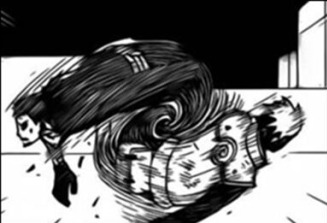

Yin and Yang, or as Obito himself is fond of saying, Oil and Water.
Obito proved to be an extremely valuable ally in the fight against both Madara and Kaguya, and gave his life one more time to protect Kakashi, Naruto, and Sasuke. He fought on with everything he had to redeem himself for even a fraction of the damage he’d done. He died not as the Masked Man or the harbinger of calamity, but as Obito Uchiha. Obito, in my opinion, is the best written character in Naruto. There’s way too much unjustified hate and too many misconceptions about the character. I put this together out of my recognition of that and desire to share my passion for this boi. Thanks for reading all the way through (if you did) or even reading just a bit.
243 notes
·
View notes
Text
Two Riders Were Approaching... - Watchmen blog
(SPOILER WARNING: The following is an in-depth critical analysis. if you haven’t read this comic yet, you may want to before reading this review)

As we hurtle head long into the third act, Two Riders Were Approaching provides a story that comes the closest to a more quote/unquote ‘traditional’ comic book narrative. With nuclear tensions rising and World War Three imminent, Daniel and Rorschach must work together to deduce the identity of the ‘mask killer’ before it’s too late.
At the core of the issue is Dan and Rorschach’s relationship. Their partnership is something that has been talked about throughout the graphic novel, but this is the first time we actually get to see Nite Owl and Rorschach in action, and it’s legitimately fascinating to observe.

When I first read the graphic novel, one question kept bugging me throughout. Why the hell would Nite Owl want to work with someone like Rorschach? A violent, bigoted, right wing conspiracy nut. It can’t just be a marriage of convenience because Dan does express genuine affection toward Rorschach numerous times throughout Watchmen. Of course I was much younger at the time, so I didn’t understand all the nuances until now. See, what Alan Moore does such a good job with regarding the Nite Owl/Rorschach dynamic is using them to illustrate the flaws and dangers of centrist politics.
Now before I go any further, I just want to clarify one thing. I’m not necessarily saying there’s anything wrong with holding a centrist view. I myself identify as a centrist, albeit slightly left leaning. However there is always a risk when it comes to taking a centrist stance of becoming so neutral to the point of being complicit, maintaining the status quo even when it serves as a detriment to others because they don’t want to take sides. I can understand wanting to come across as fair and balanced, but fair and balanced doesn’t necessarily mean both sides of a debate have equal weight. There are some topics where there is no neutral stance you can possibly take. Do women deserve the vote? Should black people have rights as white people? Should gay people be allowed to get married? There’s only one correct answer to those questions. Trying to take a centrist view here wouldn’t be fair and balanced. It would be perpetuating a harmful system of discrimination and inequality. Both sides of an argument aren’t always equally valid. And yet, especially recently, we’re seeing a growing number of (usually white) centrists trying to take a neutral position from a moral or political standpoint. We’ve all seen those cringeworthy pictures of people posing with their Trump supporting friends wearing a MAGA cap, saying how politics shouldn’t affect a strong friendship. Donald Trump is a racist twat, and while not all Trump supporters are necessarily racist twats, they are complicit in his racist twattery, as are the people who claim to be liberal and yet still hang out with those guys, wringing their hands and asking why can’t everyone just get along.
In my opinion Nite Owl serves as the pinnacle of extreme centrism. He may not be as right wing as Rorschach, but he is complicit when it comes to his extreme methods and views because they’re superheroes and what they’re doing is for the supposed greater good. The scene in the bar hammers this point home very effectively. Rorschach of course used similar violent means of interrogation back in the first issue and you’d think now that Nite Owl is with him that he’d show a bit more restraint, but no. Rorschach is still just as violent as he was before and Nite Owl doesn’t stop him or resist in anyway, instead reassuring everyone around them that they’ll try and keep their interrogation brief. In fact it’s Rorschach that ends up restraining Nite Owl when he finds out about Hollis Mason’s murder and threatens to kill one of the Knot Tops.

Ah yes. Rorschach. Now he is the most interesting part of this issue for me. Presented as being sociopathic and intolerant throughout the entire novel, here we start to see another side to him. There’s obviously the moment I just mentioned where he stops Dan from committing murder, but there are other moments too. Near the beginning of the issue, we see the two of them going to Rorschach’s residence to pick up his spare uniform and journal (which is very bloody convenient, isn’t it? The spare uniform I could believe, but a spare journal too? He just happens to have a spare journal lying around in case he lost the other one. When does he have the time to copy his notes wholesale just in case he misplaces one copy? Doesn’t the guy sleep?) and they encounter Walter’s landlady who had been spreading misinformation accusing him of trying to sexually assault her. Rorschach, understandably, takes issue with this and starts to berate her, calling her a whore. She begs him not to say that in front of her kids because ‘they don’t know.’ The implication being they all have different fathers. At which point, in a rare moment of pity, Rorschach leaves her be. There’s clearly a strong parallel between his landlady and his mother and the reason he drops the argument is because he see’s one of her young boys crying in fear, which seems to remind him of his own unhappy childhood. He’s never going to be considered a good person any time soon, but considering the vile and atrocious things he’s done in past issues, this moment feels significant.
Another significant moment is in the Owlship with Dan. With the police hunting them, the two have to lay low for a while before continuing their investigations into the ‘mask killer,’ which leads to a lot of stress and arguing. Dan finally snaps and shouts at Rorschach, chastising him for his behaviour. You think you know what’s going to happen because we’ve become so familiar with the characters’ MO, but Rorschach surprises us yet again by instead apologising and shaking Dan’s hand, calling him a good friend.
This is why Rorschach is such a great character and why Watchmen is such a great book. This small, but touching moment adds some real humanity to his character. As horrid and extreme as he is, you can’t help but feel slightly sorry for Rorschach as you realise that throughout the story, his attempts to reach out to Dan have been in an effort to win back the trust of his best and only friend. It’s a tiny detail, but it helps elevate the character to something more three dimensional as opposed to just being a conservative strawman.

But now of course, it’s time for the big reveal. Turns out the ‘mask killer’ was Adrian Veidt, aka Ozymandias the whole time. I’m going to talk more about his character in the next issue, which focuses very heavily on him. For now I’ll just say that it’s a good twist that was expertly built up throughout the course of the graphic novel, however I do feel that Alan Moore fumbled it a bit toward the end. While Nite Owl is trying to break into Adrian’s computer, Rorschach delivers this very clunky monologue about Egyptian beliefs and practices, which ends up giving the game away too early. The reason why the reveal works is because Adrian has been used sparingly throughout the story. We know that his superhero alter ego has an Egyptian theme, but this is a background detail that doesn’t really register until now. It sounds silly to say, but at no point did I ever suspect that the mastermind behind ‘Pyramid Transnational’ (the company behind many of the suspicious goings on in Watchmen, along with Dimensional Developments) was the Egyptian themed superhero. But that’s because we’ve only been exposed to Ozymandias every now and then, just enough to keep him in the back of our minds, but not so often that it gives the game away. It’s a masterstroke, if you think about it. However, thanks to Rorschach’s clunky monologue, the reveal becomes really forced rather than having everything falling into place naturally. There’s no moment where the reader goes ‘oh duh! of course it’s Adrian!’ because the reveal is being telegraphed way too heavily. It’s a serious misstep in my view and I wish Moore trusted the reader a bit more rather than having to explain everything in a giant infodump.
However what I especially love about all this is how intentionally ridiculous it all is. We see Nite Owl and Rorschach talking and acting in a very melodramatic fashion. Someone is killing off superheroes in order to try and start World War Three and only they can save the day! Tra la laaaa! It’s once again all about the fantasy of power, until they learn that Ozymandias, one of their own, is the true villain, at which point the fantasy is broken and things get a lot more complicated from here on out. Not that it wasn’t complicated before, but this is the first time the characters themselves acknowledge it’s complicated, which again says a lot about them and their fantasies. Anyone less than a superhero is easy to deal with, but a superhero betraying them? Now that’s more serious.
Before his falling out with DC, Alan Moore had expressed interest in doing a Watchmen prequel about the Minutemen, which I would love to see. But after reading Two Riders Were Approaching, I would also love to see a prequel series about Rorschach and Nite Owl’s partnership in the sixties. It’s clear that we’ve only really scratched the surface of these characters as here we are, ten issues in, and there’s still so much to unpack and learn about them. It would have been nice to have seen them in their element and how it fell apart. We’ll probably never get to see it sadly (yes I know Before Watchmen exists. I’m talking about Alan Moore coming back to Watchmen), but at least this issue gives us a tantalising glimpse.
15 notes
·
View notes
Text
Lore Episode 33: A Dead End (Transcript) - 2nd May, 2016
tw: gore
Disclaimer: This transcript is entirely non-profit and fan-made. All credit for this content goes to Aaron Mahnke, creator of Lore podcast. It is by a fan, for fans, and meant to make the content of the podcast more accessible to all. Also, there may be mistakes, despite rigorous re-reading on my part. Feel free to point them out, but please be nice!
When the trucker pulled up to the toll booth on Route 895 in Virginia, it was the middle of the night, and the look on his face was one of confusion and fear. The toll booth attendant listened to the man’s story and then sent him on his way. The state highway there is referred to as the Pocahontas Parkway, so maybe the man’s story was just a play on the name’s motif, but when the highway department received more than few phone calls that night from distressed motorists, each telling essentially the same story, the authorities began to take notice. What the trucker saw, what all of them claimed to have seen, was a small group of Native Americans standing in the grass between the east- and west-bound lanes of traffic near Mill Road. The trucker described them as standing motionless in the grass, each one holding a burning torch. He assumed they were picketing, of course – after all, the parkway is rumoured to cut through land that’s sacred to local Native American tribes – but the middle of the night didn’t seem like the right time for a peaceful protest. So, it didn’t sit well with him, or the others who claimed to see the very same thing. The Times Dispatch caught wind of the story and soon people were flocking to the Mill Street overpass to see if they, too, could catch a glimpse of the ghosts. And that’s what it all comes down to, isn’t it? We all want to see the ghosts, to witness history press it’s face against the glass of the present, to cheat reality, in a sense. Each year, thousands of people around the world claim that they, too, have seen a ghost. They tell their stories and pass along their goose-bumps like some communicable disease. But the reality is that, for most of us, we never see a thing. History is often nothing more than a distant memory. In some places, though, that history floats a bit closer to the surface. I’m Aaron Mahnke, and this is Lore.
When the English arrived in what is now Virginia way back in 1607, they found the land heavily populated by the original inhabitants of the region. The English called them the Powhatan, although that was just the name of their leader. If you don’t recognise his name that’s understandable, but everyone certainly remembers his daughter, Pocahontas. Before Richmond was… Richmond, the land where it now stands was an important Powhatan settlement. In 1607, a party from Jamestown travelled inland and claimed the location as their own. Possession of the land bounced back and forth between the Native Americans and the English for years, but it was finally in 1737 that the tribes lost, and Richmond was born.
Early on, Richmond played host to important figures in the American Revolution against England. Patrick Henry, the man who shouted: “Give me liberty, or give me death”, did so from St. John’s Church, right there in Richmond. And in the middle of the Revolutionary War, Thomas Jefferson served as the governor of Virginia out of the city. Less than a century later, Richmond became a key city in the Confederacy, as the American Civil War tore the country apart. From its munitions factory and railroad system to the seat of the new government under Jefferson Davis, it was a powerful city, and rightly so – and at the centre of it all is Belle Isle. It sits right there in the James River, between Hollywood Cemetery to the north and Forest Hill to the south. It’s easy to overlook on a map, but far from being an afterthought, Belle Isle is actually home to some of the most painful memories in the history of the city.
Before the English arrived and Captain John Smith stood atop the rocks there, Belle Isle belonged to the Powhatan. Shortly after the English took control of it late in the early 1700s it was a fishery, and then, in 1814, the Old Dominion Iron and Nail Company built a factory there. Positioned on the river with the strong current never tiring, it was the perfect location to harness the power of the water. As the ironworks grew, so did its footprint. The factory expanded, a village was built around it, and even a general store popped up to serve the hundreds of people who called the island home. But they wouldn’t be the only ones to live there. In 1862, Confederate forces moved onto the island and began to fortify it. Their plan was to use the isolated island as a prison camp and began to transport Union captives there by the thousands. Over the three years it was in operation, the prison played host to over 30,000 Union soldiers, sometimes over 10,000 at a time. The crowded space and resentful feelings between Confederate and Union ideals led to deplorable conditions.
In 1882, after living with memories of the prison camp for nearly two decades, New York cavalry officer William H. Wood wrote to the editor of the National Tribune with his observations. “Many froze to death during the winter,” he wrote, “others were tortured in the most barbarous manner. I’ve seen men put astride a wooden horse such as masons use, say, 5ft high, with their feet tied to stakes in the ground, and left there for an hour or more on a cold, winter morning. Often their feet would freeze and burst open.” He also wrote of their lack of food. “A lieutenant’s dog,” he wrote, “was once enticed over the bank and taken into an old tent, where it was killed and eaten raw. Your humble servant had a piece of it. For this act of hungry men, the entire camp was kept out of rations all day.” There were only a few wooden shacks to house the prisoners, so they lived out their days completely exposed to the elements – blistering heat, freezing cold, rain and frost, and all of it contributed to the suffering of the men who were held there. Estimates vary depending on the source, but it’s thought that nearly half of those that were brought to the camp – that’s close to 15,000 – never left alive.
Today, Belle Isle is a public park, but it’s haunted by a dark past, and by those who lived and died there long ago. You can’t see their ghosts, but you can certainly feel them. It’s a heavy place. Those who visit the island claim to have felt its dark past in the air like the stifling heat of an iron forge. But there are other places in Richmond that are said to be haunted. Unlike Belle Isle, though, these locations aren’t in ruins, or nearly forgotten by the living. They’re right in the middle of everyday life, and each one has a unique story to tell. They have their own past, and according to those who have been there, it can still be seen.
Technically, Wrexham Hall is in Chesterfield County, just south of Richmond, but when you speak to people about the city’s deep, haunting past, it’s always brought up as a perfect example of local lore, and while it doesn’t have a large number of stories to tell, what it does offer is chilling enough. The house was built at the end of the 18th century by Archibald Walthall, who left the home to his daughters, Polly and Susannah. It was Susannah who later sold her childhood home, but because there was always risk that the property might be used for future construction, she required that the new owners at least preserve the family graveyard. Time and the elements, though, have allowed the site of the burial ground to slip from memory, and according to some, that’s why Susannah has returned to Wrexham Hall, perhaps in an effort to make sure some piece of the past is still remembered.
Many years after her death, the home was owned by a man named Stanley Hague. He and a handful of other men had been working in the field near the house when they looked up to see a woman in a red dress sitting on the front porch. They all saw her, and even commented to each other about it. It was hard to miss that bright red against the white home. Later, when Stanley headed home from work, he asked his wife if her mother had been on the porch that day. No, she told him, she’d been away all day in Richmond.
In Hollywood Cemetery, just north of Belle Isle, there are other stories afoot. The graveyard was established in 1849 and is the final resting place of a number of important figures – former US presidents James Monroe and John Tyler, along with Confederate president Jefferson Davis. There are also two Supreme Court Justices buried there, along with 22 confederate generals and over 18,000 troops. The soldiers are honoured with an enormous stone pyramid that reaches up beyond the tree tops, and even though no one is buried beneath it, there have been several reports of moans heard coming from the stones. Others have claimed to have felt cold spots near the base. But it’s really a grave nearby that’s the site of the most activity there. This grave belongs to a little girl who died at the age of three from a childhood illness, and standing beside her tombstone is a large, cast iron dog. According to the local legend, the dog once stood outside her father’s grocery store, but when she passed away in 1862, it was moved to her grave to look after her. That might not be completely accurate, though. In the early 1860s, many iron objects were melted down to be used for military purposes, so the dog was most likely moved to the cemetery as a way of protecting it, but that hasn’t stopped the stories – stories that include visions of a little girl playing near the grave, or the sound of barking in the middle of the night.
Nearby, on Cary Street, is the old, historic Byrd Theatre. It was built in 1928 and named after the founder of Richmond himself, William Byrd. The space inside is enormous – it can seat over 900 on the lower level and another 400 or so in the balcony, and it’s up there that some of the oddest experiences have taken place. When the theatre opened its doors in December of 1928, Robert Coulter was the manager, and he continued to serve in that role all the way up until 1971, when he passed away. For over four decades, he was a permanent fixture in the theatre, often found sitting in his favourite seat up to one side of the balcony, and if we believe the stories, Robert never left. The current manager has been told by a number of people that they’ve all seen a tall man in a suit, sitting in the balcony at times when no one else was up there. Others have physically felt someone pass by them while operating the projector. The former manager has even been seen on more than one occasion by employees locking the front doors at night, as if he were coming out to help them. The stories that are whispered about places like Byrd Theatre aren’t alone. There are dozens of locations across the city that claim unusual activity and equally eerie stories, but none can claim to have played host to a flesh and blood monster. None, that is, except for one.
In 1875, the Chesapeake and Ohio Railway Company was looking to connect some track in Richmond to another spur 75 miles to the south. Newport News was down that way, and that meant ocean and shipping. It was a gamble to make their railroad more profitable in the wake of the Industrial Revolution and its increasing demand for things like coal, something mined in western Virginia. Part of the new railway line would cut through Richmond, near Jefferson Park, and it was decided that a tunnel would be constructed for the track to pass through. Trains would enter on 18th Street and then exit 4000ft later on the eastern end, near 31st Street. It was one of those ideas that sounded perfect on paper. Reality, though, had a few complications to throw at them. Richmond sits on a geological foundation of clay, as opposed to the bedrock found in other parts of the state. It’s the kind of soil that changes consistency depending on the season and weather. Rainy months lead to more ground water, and that swells the clay. Dry months cause the opposite. As you can imagine, it’s difficult to build on ground that constantly changes density. Even during construction, there were a number of cave-ins. Between the project’s inception in 1875 and its completion six years later, at least ten men died while working in the tunnel. Even after it was open, water had a tendency to seep in and cause problems, something that went on for decades.
Around 1901, though, alternative routes were created, and the Church Hill Tunnel was used less and less. But when the railroad wanted to increase capacity in 1925, they remembered the old tunnel, and began work to bring it up to modern standards. Maybe now, they thought, they could do it right. By the autumn of 1925, the tunnel was playing host to a crew of brave men, supported by a work train powered by steam. They were slowly making their way along the length of the tunnel, making repairs, improving the engineering and hopefully making the tunnel safe for future use. But even after claiming so many lives decades before, the tunnel didn’t seem to be done just yet.
On October 2nd, while doing what they’d been doing for weeks, dozens of men were working inside the tunnel when the ceiling collapsed. Most escaped, but five men were trapped inside, buried alive. And to make matters worse, the steam engine exploded from the weight of the debris pressed down on it, filling the tunnel with steam and dust, eventually contributing to even further collapse. According to the story as it’s told today, something did, in fact, walk out of the tunnel – but it wasn’t human. They say it was a hulking creature, covered in strips of decaying flesh, with sharp teeth and a crazed look in its eye. And because witnesses reported that blood was flowing from its mouth, many have since referred to it as the Richmond Vampire. No one could explain why the creature was there. Some suggested that it had been attracted to the carnage and had come to feed. They say that’s why the early rescue attempts only found one of the five missing men, still seated at the control of the work train. There was no other sign of the other victims of the tragedy, though, so some suggest that perhaps the vampire had something to do with that. Witnesses say that the creature fled out the eastern end of the tunnel, past the gathering crowd of workers, and then made its way south to Hollywood Cemetery. Some of the workmen who had managed to escape the collapse and witnessed the creature’s getaway were able to make chase, following it through the graveyard for a distance. Then, they claimed, it slipped into one of the tombs, the final resting place of a man named W. W. Pool.
Pool, it turns out, was a relatively unknown accountant who had died just three years prior. According to the local legend, this made sense – the blood on the mouth, the jagged teeth, the return to the mausoleum. All of it pointed to one, undeniable fact that quickly spread across the city as one of the premier legends of Richmond. Pool was, of course, a vampire. It’s said that people returned to the cemetery for many nights, each one eagerly waiting to see if the vampire would emerge from its hiding place once more, but there were no other stories to tell us what happened next. If the Richmond Vampire had been active before the Church Hill tunnel incident, it seems he had gone into retirement immediately after it. Like many tales of local lore, this story ends on an unsatisfying note. Just as the mysterious creature’s trail from the collapsed tunnel finally ended in the shadowy doorway of a cold mausoleum, the story of what happened seems to end in shadows as well. Much like the tunnel itself, it was now nothing more than a dead end.
A funny thing happens somewhere between real life events in the past and the stories we tell each other around the campfire or dining room table. Much like the true and tried telephone game, where the message is passed from person to person through a long chain of possession, these old stories shift and change. The change is never visible. They adapt to a new culture, or take on elements that are only relevant to a particular generation, but after decades, sometimes even centuries, these stories stand before us transformed, which is the difference between history and folklore, after all. History, there’s a paper trail, a clear image of the original that time and distance has more difficult time eroding. Folklore is like water, forever shifting to fit the crevice as the rock breaks down. Richmond is an old city by the standards of most Americans. Yes, there are older places on the east coast, but it has a storied history that makes it feel almost timeless – Jamestown, the Revolutionary War, the Civil War and the Confederacy. American history would be lacking something essential without the role Richmond has played through it all. Some of that history is unchanged, but some, it seems, has undergone deep transformation over the years, and a prime example of that is the story of the Richmond Vampire.
The collapsed tunnel and the train inside are all fact. There have even been modern day efforts to rescue the train car inside and clear the rubble, but the tunnel is now flooded with the same ground water that made it unstable in the first place. The events that happened on that dark, October day in 1925 were real, though – at least to a degree. A lone survivor did crawl from the wreckage, as the story tells us. His teeth were sharp and his mouth was bloody. Even his skin, hanging from his body like wet linen bandages, is documented fact. But the survivor had a name – Benjamin Mosby. He was a 28-year-old employee of the railroad and was described as big and strong. At the moment of the accident, he’d been standing in front of the train’s open coal door, shirt off, covered in sweat, and shovelling fuel into the fire. When the tunnel collapsed, the boiler burst under the pressure, washing Mosby in a flood of scalding water. But he somehow survived, crawled free from the rock and twisted metal, and walked to safety. He died the following day at the local hospital, and it was his appearance, with bloody, broken teeth and skin boiled from his body in ribbons, that fuelled the story we still whisper today. It’s almost cliché to say it, but it’s true – sometimes the real-life events that birth the legend turn out to be more frightening and horrific than any folktale could ever be.
[Closing Statements]
9 notes
·
View notes
Text
Internet trolls don’t troll. Not the professionals at least. Professional trolls don’t go on social media to antagonize liberals or belittle conservatives. They are not narrow minded, drunk or angry. They don’t lack basic English language skills. They certainly aren’t “somebody sitting on their bed that weighs 400 pounds,” as the president once put it. Your stereotypical trolls do exist on social media, but the amateurs aren’t a threat to Western democracy.
Professional trolls, on the other hand, are the tip of the spear in the new digital, ideological battleground. To combat the threat they pose, we must first understand them — and take them seriously.
On August 22, 2019, @IamTyraJackson received almost 290,000 likes on Twitter for a single tweet. Put in perspective, the typical tweet President Trump sends to his 67 million followers gets about 100,000 likes. That viral tweet by @IamTyraJackson was innocent: an uplifting pair of images of former pro football player Warrick Dunn and a description of his inspiring charity work building houses for single mothers. For an anonymous account that had only existed for only a few months, “Tyra” knew her audience well. Warrick’s former coach, Tony Dungy, retweeted it, as did the rapper and producer Chuck D. Hundreds of thousands of real users viewed Tyra’s tweet and connected with its message. For “Tyra,” however, inspiring messages like this were a tool for a very different purpose.
The purpose of the Tyra account, we believe, was not to spread heartwarming messages to Americans. Rather, the tweet about Warrick Dunn was really a Trojan horse to gain followers in a larger plan by a foreign adversary. We think this because we believe @IamTyraJackson was an account operated by the successors to Russia’s Internet Research Agency (IRA). Special Counsel Robert Mueller indicted the IRA for waging a massive information war during the 2016 U.S. election. Since then, the IRA seems to have been subsumed into Russia’s Federal News Agency, but its work continues. In the case of @IamTyraJackson, the IRA’s goal was two-fold: Grow an audience in part through heartwarming, inspiring messages, and use that following to spread messages promoting division, distrust, and doubt.
We’ve spent the past two years studying online disinformation and building a deep understanding of Russia’s strategy, tactics, and impact. Working from data Twitter has publicly released, we’ve read Russian tweets until our eyes bled. Looking at a range of behavioral signals, we have begun to develop procedures to identify disinformation campaigns and have worked with Twitter to suspend accounts. In the process we’ve shared what we’ve learned with people making a difference, both in and out of government. We have experienced a range of emotions studying what the IRA has produced, from disgust at their overt racism to amusement at their sometimes self-reflective humor. Mostly, however, we’ve been impressed.
Professional trolls are good at their job. They have studied us. They understand how to harness our biases (and hashtags) for their own purposes. They know what pressure points to push and how best to drive us to distrust our neighbors. The professionals know you catch more flies with honey. They don’t go to social media looking for a fight; they go looking for new best friends. And they have found them.
Disinformation operations aren’t typically fake news or outright lies. Disinformation is most often simply spin. Spin is hard to spot and easy to believe, especially if you are already inclined to do so. While the rest of the world learned how to conduct a modern disinformation campaign from the Russians, it is from the world of public relations and advertising that the IRA learned their craft. To appreciate the influence and potential of Russian disinformation, we need to view them less as Boris and Natasha and more like Don Draper.
As good marketers, professional trolls manipulate our emotions subtly. In fall 2018, for example, a Russian account we identified called @PoliteMelanie re-crafted an old urban legend, tweeting: “My cousin is studying sociology in university. Last week she and her classmates polled over 1,000 conservative Christians. ‘What would you do if you discovered that your child was a homo sapiens?’ 55% said they would disown them and force them to leave their home.” This tweet, which suggested conservative Christians are not only homophobic but also ignorant, was subtle enough to not feel overtly hateful, but was also aimed directly at multiple cultural stress points, driving a wedge at the point where religiosity and ideology meet. The tweet was also wildly successful, receiving more than 90,000 retweets and nearly 300,000 likes.
This tweet didn’t seek to anger conservative Christians or to provoke Trump supporters. She wasn’t even talking to them. Melanie’s 20,000 followers, painstakingly built, weren’t from #MAGA America (Russia has other accounts targeting them). Rather, Melanie’s audience was made up of educated, urban, left-wing Americans harboring a touch of self-righteousness. She wasn’t selling her audience a candidate or a position — she was selling an emotion. Melanie was selling disgust. The Russians know that, in political warfare, disgust is a more powerful tool than anger. Anger drives people to the polls; disgust drives countries apart.
Accounts like @IamTyraJackson have continued @PoliteMelanie’s work. Professional disinformation isn’t spread by the account you disagree with — quite the opposite. Effective disinformation is embedded in an account you agree with. The professionals don’t push you away, they pull you toward them. While tweeting uplifting messages about Warrick Dunn’s real-life charity work, Tyra, and several accounts we associated with her, also distributed messages consistent with past Russian disinformation. Importantly, they highlighted issues of race and gender inequality. A tweet about Brock Turner’s Stanford rape case received 15,000 likes. Another about police targeting black citizens in Las Vegas was liked more than 100,000 times. Here is what makes disinformation so difficult to discuss: while these tweets point to valid issues of concern — issues that have been central to important social movements like Black Lives Matter and #MeToo — they are framed to serve Russia’s interests in undermining Americans’ trust in our institutions.
These accounts also harness the goodwill they’ve built by engaging in these communities for specific political ends. Consistent with past Russian activity, they attacked moderate politicians as a method of bolstering more polarizing candidates. Recently, Vice President Biden has been the most frequent target of this strategy, as seen in dozens of tweets such as, “Joe Biden is damaging Obama’s legacy with his racism and stupidity!” and “Joe Biden doesn’t deserve our votes!”
The quality of Russia’s work has been honed over several years and millions of social media posts. They have appeared on Instagram, Stitcher, Reddit, Google+, Tumblr, Medium, Vine, Meetup, and even Pokémon Go, demonstrating not only a nihilistic creativity, but also a ruthless efficiency in volume of production. The IRA has been called a “troll farm,” but they are undoubtedly a factory.
While persona like Melanie and Tyra were important to Russian efforts, they were ultimately just tools, interchangeable parts constructed for a specific audience. When shut down, they were quickly replaced by other free-to-create, anonymous accounts. The factory doesn’t stop. They attack issues from both sides, attempting to drive mainstream viewpoints in polar and extreme directions.
In a free society, we must accept that bad actors will try to take advantage of our openness. But we need to learn to question our own and others’ biases on social media. We need to teach — to individuals of all ages — that we shouldn’t simply believe or repost anonymous users because they used the same hashtag we did, and neither should we accuse them of being a Russian bot simply because we disagree with their perspective. We need to teach digital civility. It will not only weaken foreign efforts, but it will also help us better engage online with our neighbors, especially the ones we disagree with.
Russian disinformation is not just about President Trump or the 2016 presidential election. Did they work to get Trump elected? Yes, diligently. Our research has shown how Russia strategically employed social media to build support on the right for Trump and lower voter turnout on the left for Clinton. But the IRA was not created to collude with the Trump campaign. They existed well before Trump rode down that escalator and announced his candidacy, and we assume they will exist in some form well after he is gone. Russia’s goals are to further widen existing divisions in the American public and decrease our faith and trust in institutions that help maintain a strong democracy. If we focus only on the past or future, we will not be prepared for the present. It’s not about election 2016 or 2020.
The IRA generated more social media content in the year following the 2016 election than the year before it. They also moved their office into a bigger building with room to expand. Their work was never just about elections. Rather, the IRA encourages us to vilify our neighbor and amplify our differences because, if we grow incapable of compromising, there can be no meaningful democracy. Russia has dug in for a long campaign. So far, we’re helping them win.
3 notes
·
View notes
Text
Psycho Analysis: Evelyn Deavor
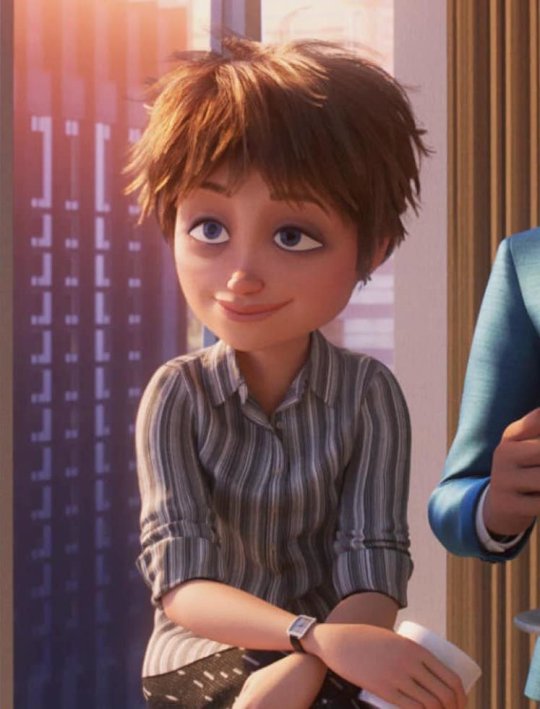
(WARNING! This analysis contains SPOILERS!)
Disney has been making a lot of films with twist villains as of late, villains who seem to be a friend for much of the movie but then, in the final act, reveal their true colors and suddenly are revealed to be the driving antagonistic force of the film. The only time this ever worked was for King Candy, because the twist tied to him wasn’t that he was an antagonist (he had been opposing the heroes and there was foreshadowing he knew more than he let on) but rather what his true nature was. Hans and Bellwether fell flat because of the inconsistencies of their characters and the lack of proper buildup beforehand, respectively, but at least this problem didn’t afflict itself on other Disney properties…
...And then came Incredibles 2. It’s a fantastic film without a doubt, and definitely a great thematic continuation of the first film that really helps to expand the world, but I cannot for the life of me find any way to defend the twist villain of this film. Evelyn Deavor is just the absolute bottom of the barrel when it comes to twist villains, because she combines all the problems of every other twist villain prior into one.
Actor: Catherine Kenner portrays Evelyn Deavor, and quite frankly it is endlessly amusing that she is yet again playing a villain who uses hypnosis to control people. Wonder if those goggles send the supers to the Sunken Place? For what it’s worth, I do think she does a good job, her performance is never bad or anything, and most of the reason Evelyn is a bad character is because of the writing, not Kenner’s performance.
Motivation/Goals: This is where Evelyn completely falls apart. She has constructed this whole elaborate false villain known as the Screenslaver, a character that actually has some pretty Interesting (though completely fabricated) motivations for committing crimes and who actually would help strengthen the themes of the film if his character was built on… all for the sake of making sure superheroes are illegal.
Now, her motivation comes from the same place as her brother’s motivation to bring heroes back: as a child, their father was gunned down by robbers when, instead of doing the smart thing and going into his safe room, he decided to try and call two superheroes on specially made phones to come save the day. Keep in mind this was after the initial ban on supers. In a way, you can kind of see where her motivation comes from; her dad was childish and stupid to think he could rely on heroes all the time.
But here’s the problem: heroes are already banned. It’s hard to comprehend exactly what she wants to accomplish; does she want heroes to get double banned? Sure, you could say that she’s just trying to sabotage her brother, who seems rather hellbent on legalizing heroes again, but considering he trusts her with a lot of the technical aspects of this there are a lot better ways she could have gone about undermining him, ways that would have been far less convoluted. Her entire plan seems to be to build them up to the top before tearing them down again, never stopping to consider how dangerous this is. These are SUPERHEROES, people who are known for finding a way against all odds to thwart evil schemes.
And going back to her creation, the Screenslaver, he actually has a far more interesting motivation, what with his big speech decrying the over-reliance on screens in society. There’s some interesting commentary there and it works well with the retro setting. This would have made a far more interesting villain, one that could actually say something about society, media, and so on while also reaffirming the positive points. It would have been the sort of bold statement that we need in a big film like this, in an age where, for good and for bad, we do rely quite a bit on screens.
Do I know for sure there would have been brilliant commentary there and not just the typical Luddite nonsense you see in political cartoons? No, I don’t, but I have faith considering the people working on the film. Do I know it would have been far better than the convoluted mess of a motivation that we got? Oh yes I do.
Personality: To her credit, Evelyn doesn’t actually change to much between her heroic and villainous personas. She’s still snarky, she still genuinely cares for her brother, she’s still brilliant save for her reliance on stupid and overly complex schemes… unlike other twist villains she doesn’t feel like two different characters between the time she’s a hero and the time she’s a villain. But I think this is where the praise has to end and veer into criticism, because with all this being said, it is obvious she’s going to be the bad guy from the moment she first appears onscreen. The reason why there’s no disconnect between her two personalities is because there never really was one; you either consciously or unconsciously pick up on there being something off about Evelyn from the get-go, which is not a problem Hans or Bellwether had.
Best Scene: Evelyn herself doesn’t really have any standout scenes, since in this exciting superhero action film she’s a non-action big bad, and unlike other non-action big bads like, say, Zemo from Civil War, her motivations are too stupid and convoluted to really get behind to enjoy her ranting. But I suppose she was technically behind the Screeslaver fight even if she was not directly there, so let’s go with that. Despite the issues the visuals caused when the film was first released, the fight is one of the most exciting moments of the film.
Best Quote: “Screenslaver interrupts this program for an important announcement. Don't bother watching the rest. Elastigirl doesn't save the day; she only postpones her defeat. And while she postpones her defeat, you eat chips and watch HER confront problems that you are too lazy to deal with. Superheroes are part of your brainless desire to replace true experience with simulation. You don't talk, you watch talk SHOWS. You don't play games, you watch game SHOWS. Travel, relationships, risk; every meaningful experience must be packaged and delivered to you to watch at a distance so that you can remain ever-sheltered, ever-passive, ever-ravenous consumers who can't bring themselves to rise from their couches, break a sweat, and participate in life. You want superheroes to protect you and make yourselves ever more powerless in the process; while you tell yourself you're being ‘looked after’, that your interests are being served, and your rights are being upheld. So that the system can keep stealing from you, smiling at you all the while. Go ahead, send your supers to stop me. Grab your snacks, watch your screens, and see what happens. You are no longer in control. I am.” Oh darn, am I giving the fabricated villain credit over Evelyn again? It’s almost like this utterly boring and convoluted villain was far better at writing more interesting villains than she was at being an antagonist.
Final Thoughts & Score: Let’s compare and contrast to Syndrome from the first movie, since she actually has quite a bit in common with his motivation. Syndrome seemed to envy superheroes and wanted to undermine them by supplanting their place in the world with his own technology, making a world where everyone is super, which in his own words would mean “no one will be.” The catalyst for his descent into supervillainy is, of course, his rejection by Mr. Incredible, which made him lose sight in what was important and drove him mad, leading to his eventual criminal career. Syndrome ends up being rather effective as a villain, and even a twist villain, because his true nature is revealed about halfway through the film, and he is given plenty of screentime to be a villain and establish his evil personality. His plan made sense, wasn’t overly convoluted, and actually managed to cause permanent, lasting damage to the super community.
And then you have Evelyn. Her motivations are completely muddied and incoherent, a problem Hans had as well but with him there was at least a token effort to foreshadow why he might do what he does, as bad as said foreshadowing ended up; with Evelyn though, there’s really no attempt made to really make sense of her convoluted scheme, there’s no questioning the logic behind doing what she does. The fact her plan is just accepted, that not even Helen Parr, a very smart woman, does not see the glaring flaws in Evelyn’s plan and call her out on them, is ridiculous. And then, much like Bellwether, the more interesting motivations are completely wasted; but where Bellwether at least genuinely did have some vicious prejudices to her that were unfortunately glossed over, Evelyn just completely fabricated every little thing about the Screenslaver to make an interesting protagonist for the heroes to fight to make them look good so she could tear them all down. Evelyn is just the utter exacerbation of every single flaw of previous twist villains, except without any of the redemptive qualities. At best she is an interesting contrast to Syndrome, as their overall goals are polar opposites (he wants to become a super and normalize it, she wants them to go away forever), but that’s really more in theory; in practice she just comes off as convoluted and dumb.
Evelyn is a very disappointing 1/10. We deserved a much better villain in this movie; hell, the Underminer would have been a great foe, because even if he had simple motivations he was still very comic booky and fun. Or even if they just stuck with Screenslaver, and let him be the actual villain, and let all of the incredibly obvious signs right from Evelyn’s intro be nothing more than red herrings. You could have even give Screenslaver some sort of connection to the Deavors, maybe he could be a disgruntled former employee a la the Riddler in Batman Forever. It’s honestly really sad that the absolute worst Batman movie was able to do the Screenslaver better than the sequel to one of Pixar’s finest films, but such is the cruel world we live in. Evelyn isn’t one of the worst villains because she is utterly devoid of quality, like Weapon XI or, god forbid, Malekith. No, Evelyn is one of the worst because she is a frustrating waste of potential that squanders good ideas for nonsensical twists.
You want to know the saddest part? In his one single big scene, the fake Screenslaver is more interesting, compelling, and exciting than the actual real Screenslaver. This untrained pizza boy puts up an actual fight and is intimidating and creepy, and he manages to outshine Evelyn in a film that ostensibly has her as the big bad. I suppose I may as well rate him, seeing as this review sort of covers them both and I don’t think it’s worth it to do a Psycho Analysis on a fake villain; I give him a solid 7/10. He is easily six points higher on the scale despite not even being a real villain and all his motivations being completely made up by the real antagonist; that’s how utterly disappointing Evelyn is.
65 notes
·
View notes